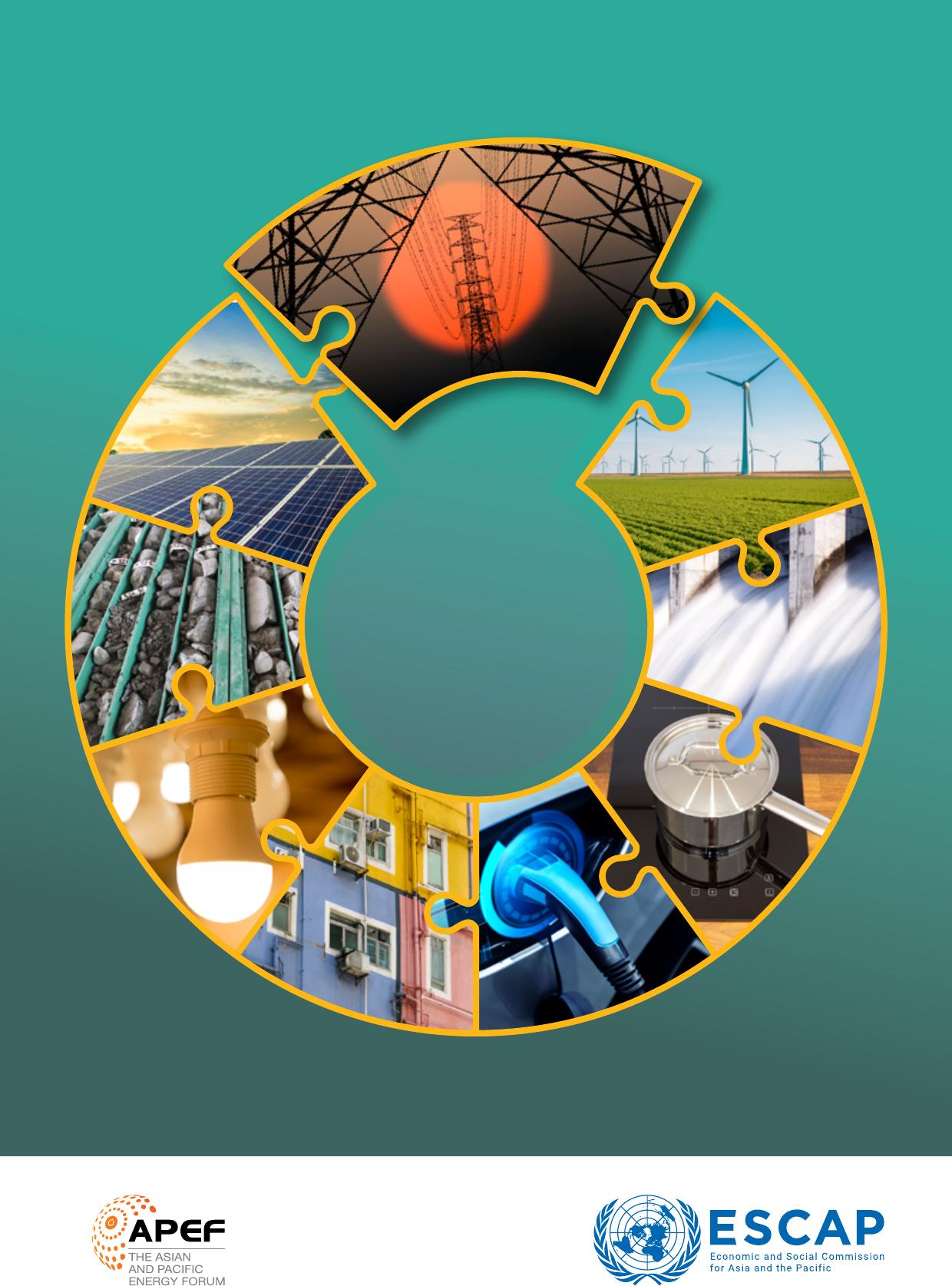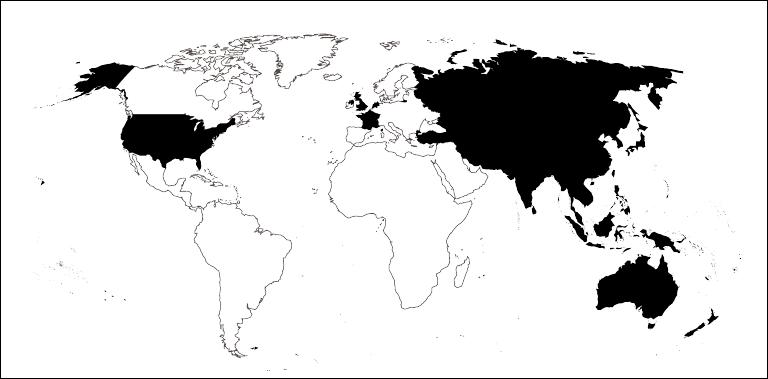ClosingthegapforSDG7intheAsia-PacificregionREGIONALTRENDSREPORTONENERGYFORSUSTAINABLEDEVELOPMENT2023TheshadedareasofthemapindicateESCAPmembersandassociatemembers.TheEconomicandSocialCommissionforAsiaandthePacific(ESCAP)isthemostinclusiveintergovernmentalplatformintheAsia-Pacificregion.TheCommissionpromotescooperationamongits53memberStatesand9associatemembersinpursuitofsolutionstosustainabledevelopmentchallenges.ESCAPisoneofthefiveregionalcommissionsoftheUnitedNations.TheESCAPsecretariatsupportsinclusive,resilientandsustainabledevelopmentintheregionbygeneratingaction-orientedknowledge,andbyprovidingtechnicalassistanceandcapacity-buildingservicesinsupportofnationaldevelopmentobjectives,regionalagreementsandtheimplementationofthe2030AgendaforSustainableDevelopment.ThedesignationsemployedandthepresentationofmaterialonthismapdonotimplytheexpressionofanyopinionwhatsoeveronthepartoftheSecretariatoftheUnitedNationsconcerningthelegalstatusofanycountry,territory,cityorareaorofitsauthorities,orconcerningthedelimitationofitsfrontiersorboundaries.ClosingthegapforSDG7intheAsia-PacificregionREGIONALTRENDSREPORTONENERGYFORSUSTAINABLEDEVELOPMENT2023Photocredits:UnitedNationspublicationforrest9/iStock(884637972)Salesno.:E.23.II.F.10fokkebok/iStock(1215198520)Copyright@UnitedNations2023Kat72/iStock(50727777)Allrightsreservedaapsky/iStock(1397078816)ISBN:9789210029292RalfHahn/iStock(464326357)e-ISBN:9789213584828SCMJeans/iStock(1621949846)ISSN:2618-107XDKsamco/iStock(507305500)e-ISSN:2618-1088SlobodanMiljevic/iStock(1211557085)ST/ESCAP/3097Thinnapob/iStock(1310384629)Thispublicationmaybereproducedinwholeorinpartforeducationalornon-profitpurposeswithoutspecialpermissionfromthecopyrightholder,providedthatthesourceisacknowledged.TheESCAPPublicationsOfficewouldappreciatereceivingacopyofanypublicationthatusesthispublicationasasource.Usemaynotbemadeofthispublicationforresaleoranyothercommercialpurposewhatsoeverwithoutpriorpermission.Applicationsforsuchpermission,withastatementofthepurposeandextentofreproduction,shouldbeaddressedtotheSecretaryofthePublicationsBoard,UnitedNations,NewYork.ThedesignationsemployedandthepresentationofthematerialinthispublicationdonotimplytheexpressionofanyopiniononthepartoftheUnitedNationsconcerningthelegalstatusofanycountry,territory,cityorarea,orofitsauthorities,orconcerningthedelimitationofitsfrontierorboundaries.iiCRELOGISOINNGALTTHREEGNADPSfRoErPSODRGT7OINNETNHEERAGSYIAF-OPARCSIUFISCTARIENGAIOBNLEDEVELOPMENT2023AcknowledgementsThisreportwasdevelopedbytheEnergyDivisionoftheEconomicandSocialCommissionforAsiaandthePacific(ESCAP)undertheoveralldirectionandguidanceofHongpengLiu,DirectoroftheEnergyDivision,andMichaelWilliamson,ChiefofSustainableEnergyDevelopmentandUtilizationSection,theEnergyDivision,ESCAP.TheprincipalauthorsofthereportwereDavidFerrari,MichaelDavidWaldronandKimberlyRoseberry.ThecontributorsfromtheEnergyDivisionwereMichaelWilliamsonandSergeyTulinov.ThepeerreviewandvaluablesuggestionswereprovidedbySustainableEnergyforAllandtheInternationalRenewableEnergyAgency.AlanCoopereditedthemanuscript.ThecoveranddesignlayoutwerecreatedbyLowilEspada.AdministrativeandsecretarialsupportwasprovidedbyKorakotChunprapaph,PrachakpornSophon,NawapornSunkphoandThirayaTangkawattana.TheCommunicationsandKnowledgeManagementSection(CKMS)ofESCAPcoordinatedthedisseminationofthereport.iiiForewordAstheworldfacesmultipleoverlappingcrises,countriesoftheAsia-Pacificregioncontinuetheireffortstoimplementthe2030AgendaforSustainableDevelopment.InthisfinaldecadeofactionontheSustainableDevelopmentGoals(SDGs),theseeffortshaveaparticularurgency.WhilealltheSDGsareimportant,makingprogresstowardsSDG7onaffordableandcleanenergyiscritical,asenergyisatthecentreofthesustainabledevelopmentprocess,presentinglinkagesacrossmanyotherSDGs.Asenergysectoremissionsarethekeydriversofclimatechange,thesuccessoftheParisAgreementhingesonthespeedofenergydecarbonizationinthisregion.Thepastfewyearshavetaughtusthatenergyisasectorinwhichmanynegativeimpactsstemmingfromthecurrentglobalcrisesareexperienced,suchasrisingpricesandenergysecurityconcerns.Sustainableenergy,however,holdsmanysolutions¬fromrenewableenergytoenergyefficiencyandcross-borderpowersystemconnectivity–thatcanleadtolowercosts,diversifiedportfoliosandenhancedsecurity.Againstthisbackdrop,thisflagshipreport,partoftheannualRegionalTrendsseries,isanimportantcontributiontowardsunderstandingthesechallengesandopportunities.ThereportexaminesprogressmadebyAsianandPacificcountriestowardsachievingSDG7andreviewsthewaysinwhichcountriesoftheregioncanpreparetoreachnet-zeroemissionsbymid-century.Byassessingprogressatcountryandregionallevels,itpresentsacomprehensiveregionalpictureoftheprincipalSDG7gapsandoutlineskeypolicydirectionsformemberStatestoconsider.MuchmoreneedstobedonetobridgethesegapsandbringSDG7achievementcloser.ESCAPiscommittedtoworkingwithallmemberStatestobuildanenergysystemthatismoresustainable,resilient,secureandinterconnected.ThereportisbeingreleasedpriortotheThirdAsianandPacificEnergyForum(APEF3)inOctober2023tosupportdeliberationsonregionalcooperationonenergy.ThethemeofAPEF3–“Buildingasecure,sustainableandinterconnectedenergyfutureforAsiaandthePacific”–encapsulatesavisionthatbringstogethersustainability,regionalcooperationandresiliencefortheregion’senergyfuture.Itishopedthatthisreportcanprovideasteppingstonetowardsachievingthisvision.ArmidaSalsiahAlisjahbanaUnder-Secretary-GeneraloftheUnitedNationsandExecutiveSecretaryofESCAPivCRELOGISOINNGALTTHREEGNADPSfRoErPSODRGT7OINNETNHEERAGSYIAF-OPARCSIUFISCTARIENGAIOBNLEDEVELOPMENT2023ContentsAcknowledgements�iiAbbreviationsandacronyms�viiiForeword�iiiExecutivesummary�1Listoffigures,tablesandboxes�viIntroduction�6CHAPTER1CHAPTER2CHAPTER3SustainableEnergyTheAsia-PacificOPPORTUNITIESDevelopment:SituationRegion’sSustainableFORPROMOTINGandTrends�9EnergyProgressandSUSTAINABLEENERGYOutlookattheHalfwayDEVELOPMENTINTheenergysituation:aPointofthe2030THEASIA-PACIFICstatusupdatefortheAgendaforSustainableREGION�44Asia-PacificregionandDevelopment�21acrosstheglobe�9OverviewofpolicysolutionsProgresstowardsforsustainableenergyOverviewofenergyrealizingSustainabledevelopment�44situationbysubregion�13DevelopmentGoal7�21PromotingsystemSynergiesbetweenProgresstowardsintegrationthroughSustainableuniversalenergyaccess�24digitalization�47DevelopmentGoal7andtherestofProgressinrenewableFocusoncrossbordertheSustainableenergy�31connectivity�49DevelopmentAgenda�15ProgressinenergyManagingaccesstocriticalProgressinemissionsefficiency�38rawmaterialstoenableandclimateambition�17energytransition�54RenewedenergysecurityEnsuringtransitionsareconcernsamidavolatilejustandpeople-centeredeconomicandenergyascountriesshiftfrommarketbackdrop�19coal�55Aligningcleanenergydevelopmentwithlocalenvironmentalandcommunitypriorities�57vCHAPTER4CHAPTER5IMPACTSOFCONCLUSIONSANDAnnex1:KeyenergyOVERLAPPINGRECOMMENDATIONS�74indicatorsbysubregion�79CRISESONENERGYTRANSITIONS�60Annex2:PathwaystolimitingglobalwarmingEnergyimpactsoftheto1.5°CforthefiveCOVID-19pandemic�61largestemittersintheregion�83ChallengesforaReferences�85sustainablerecovery–economicconstraintsandfossilfuelledrebound�62Challengesforasustainablerecovery–energycrisisandnewenergysecurityrisks�64Implicationsforjustandinclusivetransitions–newaffordabilitypressures�66Opportunitiesforsecureandsustainabledevelopment–policyandplanningstrategies�70viCRELOGISOINNGALTTHREEGNADPSfRoErPSODRGT7OINNETNHEERAGSYIAF-OPARCSIUFISCTARIENGAIOBNLEDEVELOPMENT2023ListofFiguresFigureES1EnergysupplybyproductinAsiaandthePacific�2FigureES2Populationwithoutaccesstoelectricity(millions),2021�3FigureES3Populationwithoutprimaryrelianceoncleancookingfuelsandtechnologies,2021�3Figure1EnergysupplybyproductinAsiaandthePacific�10Figure2FinalconsumptionbysectorinAsiaandthePacific�11Figure3SustainableDevelopmentGoal7progressgloballyandintheAsia-Pacificregion�12Figure4(a)Asia-Pacificprimaryenergysupplybyproduct,2020;and(b)Carbondioxidefromfuelcombustion,2020�18Figure5GreenhousegasemissionsscenariowithcompoundednationallydeterminedcontributionsandcarbonneutralpledgesfortheAsia-Pacificregion,(GtCO2e),1990–2060�19Figure6Indexedpricetrendforglobalenergycommodities�20Figure7SustainableDevelopmentGoal7indicators(a)7.1.1rateofaccesstoelectricity;(b)rateofaccesstocleancooking;(c)renewableenergyshareoftotalfinalenergyconsumption;and(d)energyintensityofprimaryenergy–progressintheAsia-Pacificcomparedtoglobalprogress�22Figure8EnergyinvestmentbytechnologyinAsia-Pacificcountries�23Figure9Regionalprogressinenergyaccess:(a)accesstoelectricity;and(b)accesstocleancookingfuelsandtechnologies�24Figure10Shareofpopulationwithaccesstoelectricity,bysubregion,2021�25Figure11(a)Populationwithoutaccesstoelectricity(millions),2021;and(b)Economieswithlowestratesofelectrification,2021�25Figure12Cookingfuels,bytype,2019�28Figure13Annualgainsinpopulationwithaccesstocleancooking,2000-2021�29Figure14Percentageofpopulationwithprimaryrelianceoncleanfuelsandtechnologies,bysubregion,2021�30Figure15(a)Economieswithlowestratesofcleancookingreliance,2021;and(b)Populationwithoutprimaryrelianceoncleancookingfuelsandtechnologies,2021�30Figure16(a)RenewableenergyandmodernrenewablesasashareoftotalfinalenergyconsumptioninAsiaandthePacific(b)ModernrenewableenergyshareineachoftheEconomicandSocialCommissionforAsiaandthePacificsubregions�32Figure17Renewableenergycapacitybyresourcein2010and2021,ingigawatts�33Figure18Annualrenewableenergycapacityadditionsbyresourcein2010,2015and2021�34Figure19Estimatedglobalaveragelevelizedcostofenergyfromvarioussources�35Figure20Plannedinvestmentsinlarge-scalehydrogenprojects,bystageofinvestment�37Figure21Asia-Pacificgrowthrateofprimaryenergyintensity,byperiod,andglobal2021–2030SustainableDevelopmentGoalsandnet-zerotargets�39Figure22FinalenergyintensityoftransportinAsia-Pacificsubregionsandmotorizationrateofselectcountries�41Figure23Shareofelectricvehiclesin2021passengervehiclesalescomparedwithannouncedshareambitionsforselectcountries�42Figure24RegulatoryIndicatorsforSustainableEnergyscoresforcountriesoftheAsia-Pacificregion�45Figure25TheninestrategiesoftheRegionalRoadMaponPowerGridConnectivity�50Figure26InternationalpublicfinancialflowstodevelopingcountriesinAsiaandthePacificinsupportofcleanenergyresearchandrenewableenergyproduction,bysubregion�52Figure27Totalcriticalrawmaterialsdemandforcleanenergytechnologiesbyscenario�54Figure28InternationalFrameworkforSupportingEnergyTransitioninCoalRegions�56Figure29TrendsinAsia-Pacifictotalfinalconsumptionbysub-regionandbysector�61viiFigure30Recoveryfiscalspendingin2021asashareofgrossdomesticproduct(left)andgreencomponentofspending(right)forselecteconomies�62Figure31Totalenergysupplybyproduct(left)andCO2emissionsfromfuelcombustioninAsiaandthePacific(right)�63Figure32Energytradebalance(netexports/imports)asashareoftotalenergysupplyforselectAsia-Pacificeconomies,2019�65Figure33Monthlyliquefiednaturalgasnetimportsbyregion(left)andtopAsia-Pacificcountriesdevelopingliquefiednaturalgasimportterminals(right)�66Figure34Annualchangeinaverageconsumerenergy,waterandhousingpricesinselectAsia-Pacificcountries,secondhalfof2022�67Figure35FossilfuelsubsidiesasashareofgrossdomesticproductinselectAsia-Pacificcountries�68Figure36Changesininterestratesandimpactonlevelizedcostofelectricityfornewonshorewindforselectcountries,2021–2022�69Figure37Percentchangeinannualwindandsolarphotovoltaiccapacitynetadditions,2022versus2019,forselectcountries�72Figure38EnergysupplybyproductinEastandNorth-EastAsia,NorthandCentralAsia,thePacific,SouthandSouth-WestAsia,andSouth-EastAsia�79Figure39FinalconsumptionbysectorinEastandNorth-EastAsia,NorthandCentralAsia,thePacific,SouthandSouth-WestAsia,andSouth-EastAsia�80Figure40Shareofpopulationwithaccesstoelectricity,bysubregion�81Figure41EastandNorth-EastAsia,NorthandCentralAsia,thePacific,SouthandSouth-WestAsia,andSouth-EastAsia�82Figure42ApathwaytodeliveringChina’scontributiontolimitingglobalwarmingto1.5°C�83Figure43ApathwaytodeliveringIndia’scontributiontolimitingglobalwarmingto1.5°C�83Figure44ApathwaytodeliveringJapan’scontributiontolimitingglobalwarmingto1.5°C�84Figure45ApathwaytodeliveringRepublicofKorea’scontributiontolimitingglobalwarmingto1.5°C�84Figure46ApathwaytodeliveringIndonesia’scontributiontolimitingglobalwarmingto1.5°C�84ListoftablesTable1RelationshipsbetweenSustainableDevelopmentGoal7andtheotherSustainableDevelopmentGoals�15Table2Multi-TierFrameworkforMeasuringofElectricityAccess�26ListofboxesBox1SustainableDevelopmentGoal7roadmaps�14Box2Defining“cleancooking”�27Box3GenderimpactsofSustainableDevelopmentGoal7�30Box4HydrogendevelopmentinAsiaandthePacific�36Box5Newfrontiersofcooperationonenergy�46Box6HowcouldchangingmacrofinancialconditionsaffectfinancingforSustainableDevelopmentGoal7targets?�69viiiCRELOGISOINNGALTTHREEGNADPSfRoErPSODRGT7OINNETNHEERAGSYIAF-OPARCSIUFISCTARIENGAIOBNLEDEVELOPMENT2023AbbreviationsandacronymsADBAsianDevelopmentBankAIMSASEANInterconnectionMasterplanStudyAPECAsia-PacificEconomicCooperationAPEFAsiaandPacificEnergyForumAPGASEANPowerGridCCUScarboncaptureutilisationandstorageCO2carbondioxideCO2-ecarbondioxideequivalentCRMcriticalrawmaterialsESCAPEconomicandSocialCommissionforAsiaandthePacificESCOsenergyservicescompaniesESMAPEnergySectorManagementAssistanceProgramEVselectricvehiclesFiTfeed-intariffGDPgrossdomesticproductIEAInternationalEnergyAgencyIMFInternationalMonetaryFundIPPindependentpowerproducerIPCCInternationalPanelonClimateChangeIRENAInternationalRenewableEnergyAgencyISOInternationalOrganizationforStandardizationJETPJustEnergyTransitionPartnershipJODIJointOrganisationsDataInitiativekgkilogramkoekilogramoilequivalentkWhkilowatt-hoursLCOElevelizedcostofelectricityLPGliquidpropanegasLNGliquifiednaturalgasMEPSMinimumEnergyPerformanceStandardsMtoemilliontonnesofoilequivalentMWhmegawatt-hoursNDCsnationallydeterminedcontributionsNEXSTEPNationalExpertSDGToolforEnergyPlanningOPERAOfficeofthePacificEnergyRegulatorsAllianceOECDOrganisationforEconomicCo-operationandDevelopmentPVphotovoltaicRBFresults-basedfinancingSDGsSustainableDevelopmentGoalsSPCPacificCommunitySTEMscientific,technology,engineeringandmathematicsTFECtotalfinalenergyconsumptionTEStotalenergysupplyTWhterawatt-hoursUNDPUnitedNationsDevelopmentProgrammeUNFCCCUnitedNationsFrameworkConventiononClimateChangeVREvariablerenewableenergyWHOWorldHealthOrganizationWpwatt-peakReferencestodollars($)aretoUnitedStatesdollarsunlessotherwisestated.1ExecutivesummaryAsiaandthePacificisatacriticaljunctureoftheenergytransition.Theregionishometomorethanhalfoftheworld’spopulation,consumesmorethan40percentofglobalenergy,producesmorethan50percentofglobalgreenhousegasemissionsandisundergoingrapiddevelopment.Itisexperiencingrapidgrowthinenergydemand,whichwillcontinueinthecomingyears.Thiscreatesfinancialchallenges,appliespressureonnaturalresources,strainstheenvironmentandmakesitdifficultfortheregiontomeetitsclimatechangecommitments.Givenrecentexperience,theachievementofSustainableDevelopmentGoal7(SDG7)–ensuringaccesstoaffordable,reliable,sustainable,andmodernenergyforallby2030–ischallengingfortheregion.DeliveryoftheSDG7targetsonuniversalaccesstomodernenergy,energyefficiencyandrenewableenergyhingesonscalingupinvestmentsincleanenergytechnologiesanddivertinginvestmentawayfromfossilfuels.Whilesignificantprogresshasbeenmadeinrecentyears,muchoftheinvestmenthasbeenconcentratedinarelativelyfewcountries.OneofthemostcriticalremainingSDG7challengesisthelackofaccesstomodernenergyservices.Millionsofpeopleintheregionstilldonothaveaccesstoelectricityorcleancookingfuels,whichproducesaseriesofnegativeconsequences,including,amongthem,healthimpacts,environmentaldegradationandeconomichardship.Theregion’senergymixisdominatedbycoal,oilandnaturalgas.Thisreliancecontributestowardsclimatechangeandairpollution,andongoinginvestmentinfossilfuelswilllikelyleadtofinancialburdens,includingtheriskofstrandedassets.Thephasingdownoffossilfuels,particularlyofcoal,inacontrolledandequitablemanner,iscentraltoensuringtheoverallsuccessoftheenergytransition.DeliveringthemultipletargetsunderSDG7inallcountriesoftheregionby2030requiresaconcertedeffortfromthestakeholders.Governments,businessesandcivilsocietymustworktogethertoensureuniversalenergyaccess,rampuprenewableenergyuseandenhanceenergyefficiency.TheobjectiveofthisreportistoexaminetheprogressmadebyAsia-PacificcountriestowardsachievingSDG7inthedecadeofactionontheSDGs.Init,keyenergytrendsareexamined,immediatechallengesarereviewedandthepreparationofmoreambitiousagendastowardsnet-zeroemissionsareassessedtogiverecommendationsofthestepsneededtobetakenbystakeholdersandpolicymakerstoachievethegoalofaccesstoaffordable,reliable,sustainable,andmodernenergyforall.StatusandchallengestothesustainableenergytransitionagendaFollowingaperiodofrapidgrowthoverthepasttwodecades,theAsia-Pacificregion’senergysupplyremainsdominatedbyfossilfuels.In2020,coalmadeup42.2percentofthetotalenergysupply,oil23.4percentandnaturalgas19.1percent(figureES1).Withtheenergysectoraccountingforapproximately80percentoftheregion’sgreenhousegasemissions,ashiftawayfromfossilfuels,thephasingdownofcoaluseandabroad-basedmovetowardsreachingnet-zeroemissionsbymid-centuryacrossAsiaandthePacificarecriticalstepsforputtingtheregionandtheworldontracktoavoiddestructiveclimatechange.Unfortunately,astheregion’senergydemandhasincreased,coal,gasandoilhavebeentheresourcesofchoicetounderpinmostofthegrowthoverthepastthreedecades.However,inrecentyearstherenewableenergycomponentofthetotalenergysupplyhasalsogrown,andtechnologymaturityandcostdeclineshavespurredanaccelerationinthedeploymentofcleantechnologies,whichisexpectedtocontinueinthecomingyears.2Thetotalenergysupplyisdominatedbycoal,buttherenewableenergycomponentisgrowingFigureES1.EnergysupplybyproductinAsiaandthePacificCoalOilNaturalGasHydroRenewables(excludinghydro)Nuclear800000070000006000000Thousandtonnesofoilequivalent5000000400000030000002000000100000001990199119921993199419951996199719981999200020012002200320042005200620072008200920102011201220132014201520162017201820192020Source:ESCAPbasedonInternationalEnergyAgency(IEA),WorldEnergyStatisticsandBalancesAnencouragingsignofimprovementsinenergyefficiencyoverthesameperiodisthesteadydeclineinenergyintensity.However,overallregionalprogressinthisregardfallswellshortoftheglobaltargetofdoublingthehistoricalrateofimprovementunderSDG7.Furthermore,therateofimprovementishighlyvariedacrosstheregionandovertime,withonlythreeESCAPmemberStates(China,IndonesiaandJapan)recordingratesinexcessoftheglobaltargetforenergyintensityunderSDG7.Althoughawiderangeofopportunitiesforimprovementareavailable,moreeffortmustbedirectedtowardsboostingenergyefficiencybyenhancingtheenergyefficiencyofappliances,buildingsandindustries.Meanwhile,53millionpeopleremainwithoutaccesstoelectricity.Alargeproportionofthoselackingaccesstoelectricityliveinoneofasmallnumberofcountries(figureES2),implyinganopportunityforattainingasignificantimpactfromasmallnumberofinterventionsinthoselocations.Thepossibilitiesforsuccessfulprogrammeshavebeenwidelydemonstrated.Forexample,enormousimpactshavebeenachievedinAfghanistanwheretheelectrificationratewasraisedfrom1.6percentin2000to97.7percentin2021throughgridextensionsandthedeploymentofoff-gridtechnologieswithinnovativefinancing.ThegreatestobstacletoachievingSDG7intheAsia-Pacificregionisindeliveringthetargetofuniversalaccesstocleancookingfuelsandtechnologies.Nearly1.2billionpeoplefromtheregionremainreliantontraditionalbiomass,suchaswood,animalwasteandtraditionalcharcoal,fortheircookingandspaceheatingneeds.Thisdependenceontraditionalfuelscompoundsexistinghardship,affectinggenderequality,healthandtheenvironment,andcementingvastpopulationsinongoingpoverty.3Mostpeoplewithoutaccesstoelectricityliveinjustafewcountries.FigureES2.Populationwithoutaccesstoelectricity(millions),2021Afghanistan,0.9RussianFederation,0.9RestoftheAsia-Pacificregion,0.5Bangladesh,1.8Indonesia,2.2Myanmar,14.7Philippines,2.9Cambodia,2.953millionIndia,6.4peoplePapuaNewGuinea,7.9Pakistan,12.0Source:WorldBank,UnitedNationsStatisticsDivisionAfteralmosttwodecadesofacceleratingimprovementfromthestartofthemillennium,thenumberofpeoplegainingaccesstocleancookingpeakedin2018andhassincebeendeclining.Ifcurrenttrendsweretocontinue,welloveronebillionpeoplefromtheregionwouldremainwithoutaccesstocleancookingbytheendofthedecade.FigureES3.Populationwithoutprimaryrelianceoncleancookingfuelsandtechnologies,2021DemocraticPeople’sRepublicofKorea,23RestoftheAsia-Pacificregion,98Afghanistan,26India,407Myanmar,30Indonesia,36RussianFederation,39Philippines,591196millionPakistan,114peopleBangladesh,124China,240Source:WHO,UnitedNationsStatisticsDivision4CRELOGISOINNGALTTHREEGNADPSfRoErPSODRGT7OINNETNHEERAGSYIAF-OPARCSIUFISCTARIENGAIOBNLEDEVELOPMENT2023BestpracticesforsustainableenergydevelopmentTherearemultipleopportunitiesforthepromotionandaccelerationofsustainableenergydevelopmentinAsiaandthePacific.Theregionalexperiencesofpolicymakers,projectproponentsandcommunitieshaveproducednumerouslessonslearnedandbestpractices,whichwillguideongoingimprovement.Becauseofthediversityofeconomicandnaturalresources,politicalwillandothervariables,policysolutionsforsustainableenergydevelopmentmustbetailoredandcalibratedtothelocalcontext.Nevertheless,theanalysispresentedinthisreportsupportstheexperienceofpolicymakersthatsolutionscanbeeffectivewhendesignedinclosecollaborationwithprivateandpublicstakeholders,leaningtowardsregulatedmandatesontheonehandorsupportiveinterventionsontheother.Successfulpolicyreliesonasolidfoundationofplanningforanenergytransitionthatisenvironmentallysound,secureandequitable.Astherenewableenergysupplyincreasesandheadwayismadeinimprovingefficiency,technicalsolutionsofferopportunitiesformaintainingreliability.Highlevelsofvariablerenewableenergy(VRE)willpresentchallengestogridmanagementthatcanberesolvedthrougharangeofmeasures,rangingfromchangesinoperatingprocedurestodevelopingnewinfrastructure,includingstorage,smartgridsandcross-borderconnectivity.Increasedlevelsoffinancewillneedtobemobilizedinthecomingyears,withthemajoritycomingfromtheprivatesector.Thisiscontingentonapipelineofbankableprojects,supportiveandenablingenvironmentsforprojectdeliveryandappropriatecommercialarrangements(includingriskallocation)betweenpublicandprivateactors.Reformsinfinancingtheenergysector,theimplementationofcarbonpricingandthedeploymentofinnovativebusinessmodelsandnewfinancialinstrumentswillallplayanimportantroleindrawinginternationalfinancetotheregion.Criticalrawmaterials(CRMs)areanincreasingsourceofchallengestotheenergytransition.TheAsia-PacificregionofferssignificantpotentialtocontributesolutionstoeffectivelymanageCRMs,butanalignmentofextractiveindustrieswiththeSDGsrequiresaholisticapproachandeffectivepolicymeasures.Localmanufacturingindustriesareamajordriverofdemand,butwithaquarteroftheworld’smineralreservesfoundinAsiaandthePacific,theregioniswell-positionedtomeetincreasingglobalneeds.Supplychainresiliencecanbereinforcedthroughthemanagementoftrade,whilesomeadditionalstrategiesaresupportingdomesticexploration,securingoverseasresourcesanddiversifyingthesupply,allofwhichmustbeachievedwhileensuringprotectionoftheenvironment.BothCRM-surplusandCRM-deficitcountriescanbenefitfrominternationalcooperation,innovationandcirculareconomyapproaches.Itisimportanttoensurethattheenergytransitionisjustandequitable,takingintoaccountthefullimpactsonallaspectsofsocietyandtheenvironment.Energyaffectsawiderangeofotherissuesacrossthesustainabledevelopmentandclimateagendas.Policymakers,therefore,mustconsiderthealignmentofthetransitionwiththeseinterlinkedagendas.Amidthesechallenges,theregionfacesnewrisksandopportunitiesfromtheemergenceoftwoconsecutiveglobalcrises:theCOVID-19pandemic,whichbeganin2020,andthewarinUkrainewhichstartedin2022.Whiletheimpactsarestillplayingout,thecriseshavealreadyaffectedenergytradeandsecurity.Accordingly,thesecrisescanalsoreinforcetheneedforgovernmentstoadoptgreaterlevelsofenergyefficiencyanddrivethediversificationofnationalenergysystemsawayfromfossilfuels.Theyhavealsohighlightedtheneedforcountriestoensurethatenergysystemsareevermoreresilienttonewchallengesinamorevolatileworld.5OpportunitiesforregionalaccelerationofprogressinachievingSustainableDevelopmentGoal7Insummarythecurrentstatusandtrajectoryoftheregion’ssustainableenergydevelopmentisnotcompatiblewithrealizingtheSustainableDevelopmentGoalsorthepledgesoftheParisAgreement.AtthemidwaypointoftheSDGs,itisnowmoreimportantthanevertoaccelerateeffortstowardstheenergytransition.Inthisyear’sRegionalTrendsReport,policymakersandotherstakeholdersarecalledontoworktowardsputtingtheregiononapathtowardsdeliveryofSDG7andtoaimfornet-zeroemissionsaroundthemiddleofthecentury.Inthereport,thefollowingactionsarerecommendedinsupportofthoseefforts:1.Improveenablingenvironmentsforcleanenergydevelopmentthroughaholisticapproachtoplanningandpolicymaking,whichchartsapathwayfortheenergytransitionandsupportsdeploymentofclean,modernenergytechnologies.2.Increaseprivatesectorengagementbyreformingmarketsandregulatoryframeworkstoenhanceprivateparticipationandincreasecompetition.3.Deployarangeofriskallocationandinvestmentmobilizationstrategiestoensurethatprivatefinance–whichisneededmakeupthebulkoffinancedrivingtheenergytransition–isavailableforprojectsandsectoraldevelopment.4.Employenergyconnectivityasatoolforsupportingtheenergytransitionbyworkingtowardssettingharmonizedregulationsandoperationalpoliciesthatallowfortheintegrationofpowersystems.5.ManageaccesstoCRMstoenabletheenergytransitionbysupportingeffortstoimprovelegalandregulatorypractices,establishinginclusivemanagementpracticesandstrengtheningregionalcoordination.6.Ensureajustenergytransitionthatensuresnooneisleftbehindacrossallgeographicsubregionsandallpartsofsociety.6CRELOGISOINNGALTTHREEGNADPSfRoErPSODRGT7OINNETNHEERAGSYIAF-OPARCSIUFISCTARIENGAIOBNLEDEVELOPMENT2023INTRODUCTIONSettingthesustainableenergytransformationagendaforAsiaandthePacificTheAsia-Pacificregionishometoapproximatelysources,suchassolar,windandhydropower,60percentoftheworld’spopulation,consumesintheglobalenergymixtoreducegreenhousegasabout44percentoftheprimaryenergysupplyemissionsandmitigateclimatechange.andcontributesmorethan55percentoftheannualglobalgreenhousegasemissions(United•Target7.3:DoubletheglobalrateofimprovementNationsDepartmentofEconomicandSocialAffairs,inenergyefficiency.ThistargetaimstoincreasePopulationDivision,2023;ESCAP,2022;IEA,2020).therateofimprovementinenergyintensityinIncreasingincomesandeconomicgrowthindicatestermsofprimaryenergyandgrossdomesticthattheregion’senergydemandandassociatedproduct(GDP),withenergyefficiencyplayingemissionsaregrowingrapidly,furtherheighteningacriticalrole.Thisisessentialforreducingtheimportanceofregionalcontributionstowardsenergyconsumption,loweringgreenhouseglobaleffortsonsustainableenergyandcleangasemissions,andpromotingsustainableenergytransitions.development.Theobjectiveofthisreportistoexaminetheprogress•Target7.a:EnhanceinternationalcooperationtomadebyAsia-PacificcountriestowardsachievingfacilitateaccesstocleanenergyresearchandSustainableDevelopmentGoal7(SDG7)inthefinaltechnology,includingrenewableenergy,energydecadeofactionontheSDGs.Init,thekeyenergyefficiency,andadvancedandcleanerfossil-fueltrendsacrosstheAsia-Pacificregionareexamined,technology,andpromoteinvestmentinenergywhileinadditiontoanalysingtheimmediateinfrastructureandcleanenergytechnology.challengesindeliveringSDG7,thepreparationofmoreambitiousagendastoreachnetzeroemissions•Target7.b:Expandandupgradeenergyservicesbymid-centuryarediscussed.fordevelopingcountries,especiallyleastdevelopedcountries,smallislanddevelopingSustainableDevelopmentGoals7wasadoptedinStatesandlandlockeddevelopingcountries,2015aspartofthe2030AgendaforSustainableinaccordancewiththeirrespectiveprogrammesDevelopmentwiththeaimofensuringaccessofsupport.toaffordable,reliable,sustainable,andmodernenergyforallby2030throughdeliveryoftheGiventheinterlinkagesthatenergyholdswithfollowingtargets:thehealthoftheenvironmentandwitheconomicandsocialdevelopment,achievementofSDG7is•Target7.1:Ensureuniversalaccesstoaffordable,crucialfortheoveralldeliveryoftheglobalgoals.reliableandmodernenergyservices.ThepurposeFurthermore,fortheAsia-Pacificregion,achievementofthistargetistoensurethateveryonehasoftheSDG7isimportanttospurprogressacrossaccesstomodernandsustainableenergymanyotherSDGsasfollows:services,suchaselectricity,cleancookingfuels,andtechnologies.•AsiaandthePacificisoneofthemostvulnerableregionsintheworldtotheimpactsofclimate•Target7.2:Increasetheshareofrenewablechange.ByrealizingSDG7,countriesintheenergyintheglobalenergymix.Thistargetisregioncanreducetheirclimateimpactsasintendedtoincreasetheuseofrenewableenergywellasdependenceonfossilfuelsbyshifting7torenewableenergysourcesandenergy•Lackofaccesstomodernenergyservices,efficiencymeasures.Thiswouldsignificantlysuchaselectricityandcleancookingfuels,isareducegreenhousegasemissionsandmitigatemajorhealth,genderandeducationissueinthetheimpactsofclimatechange,inlinewithregion.ByachievingSDG7,countriesintheregioncommitmentsundertheParisAgreement,canimproveaccesstocleanenergytoimprovewhilealsosupportingtheimplementationqualityoflife,reduceadversehealthimpactsoftheSendaiFrameworkforDisasterRiskandgenderinequalities,andenhanceeducationReductionthroughenhancingtheresiliencyoftheoptionsthatarehamperedbyindoorairpollutionenergysystem.andotherenergydeficit-relatedissues.•Accesstoaffordable,reliable,andsustainableManycountries,however,arestillfacingmajorenergyisessentialforpovertyreductionandchallengesrelatedtoenergyaccess,energysecurityeconomicdevelopment.ByachievingSDG7,andenvironmentalsustainability.Profoundchangescountriesintheregioncanimproveenergyaccessintheenergysystemsoftheregionarerequiredtoforthepoorandmarginalizedcommunities,whichdeliveronthesegoals.AsiaandthePacificisthecanhelpreducepovertyandpromoteinclusivecentreofgrowthforglobalenergyproductionandeconomicandsocialdevelopmentthroughconsumption,buttheregioncontinuestodependonprovidingaccesstobasicservicesandenhancedfossilfuelsinamannerthatisnotcompatiblewithopportunitiesforeconomicactivities.SDG7,norwiththetargetsoftheParisAgreement.PurposeandstructureofthisreportThisreport,releasedinthelead-uptotheministerialandotheranalyticalandnormativework,policylevelAsianandPacificEnergyForum(APEF),recommendationsforcountriestobridgethesegapswillsupportintergovernmentaldeliberationsonandbringSDG7achievementcloserareoutlined.regionalenergycooperationbyinformingdiscussionsWherepossible,subregionalinsightsarepresentedontheprogressofESCAPmemberStatestowardswithaviewtodevelopingsubregion-specifictheachievementofSDG7.Itlookstosubregionalrecommendations.Thefocusofeachchapteristargetsandobjectivesthatfurtherinformtheasfollows:regionalpicture;byhighlightingtheprincipalSDG7gaps,thereportofferspotentialsolutionsto•ChapteroneprovidesanoverviewoftheenergythesechallengeswithafocusonthesectorsandsituationinAsiaandthePacificandoverallsubregionsinwhichacceleratedprogressisrequired.progresstowardsrealizingSDG7throughadescriptionoftheregion’scontributiontotheThereportshedslightonsomekeytrendsandglobalenergytransition.ItgivesanoutlineonemergingissuesthatmemberStatesareconfrontinghowtheSDG7targetsarelinkedtootherSDGsintheirenergysectorsalongwiththepotentialforandtotheParisAgreement,whichincludesathosetrendstosupportorhinderachievementofthefocusonvulnerablegroupsandcommunities.sustainableenergyandclimategoals.ItincludesanAlsoreviewedinthechapterarethestatusofassessmentoftheinterlinkagesbetweenSDG7andnationallydeterminedcontributions(NDCs)alongtheotherSDGs,highlightingareaswheresynergieswiththepledgestowardsnet-zeroemissionsbyandco-benefitscanberealizedand,examiningthemid-centuryandothernationalandsubregionalbiggerpicturebeyondSDG7targets,suchasclimatetargetsandpolicies,andtherolesoftheCOVID-19change,airpollution,povertyeradication,sustainablepandemicandthewarinUkraineinshapingindustrialization,andthephaseoutofcoal.theregion’senergysystemandtransitionareexamined.Theemerginglandscapeofenergysecurityisexploredandtheroleofregionalcooperationin•Chaptertwo,adata-drivenapproachistakenstrengtheningregionalenergysecurityisdiscussedtoevaluateregionalprogresstowardseachinthereport.ThroughthisanalysisandbydrawingSDG7target,exploringsubregionalperspectivesoninitiativesofESCAP,suchasSDG7roadmapsonenergyresources,costsandconsumption8CRELOGISOINNGALTTHREEGNADPSfRoErPSODRGT7OINNETNHEERAGSYIAF-OPARCSIUFISCTARIENGAIOBNLEDEVELOPMENT2023trendsalongsidethestateofexistingpoliciesandpoliticalambition.Inaddition,thegenderimpactsoftheenergytransitionandtheroleofwomeninthedeliveryofthetargetisreviewed.•Chapterthreeprovidesanoutlineofthesolutionsinpolicy,technologyandfinancethatcanhelptoaccelerateprogressinmeetingSDG7targets.Amongotherpriorities,theimportanceofregionalpowergridinterconnectionasanavenueforrenewableenergyintegrationandthestepstheregionistakingwiththesupportofESCAPtorealizethislong-termvisionforenergycooperationarehighlighted.•Chapterfourincludesadescriptiononhowtheemergenceoftwoconsecutiveglobalcrises–theCOVID-19pandemicin2020andtheongoingwarinUkraine,whichcommencedin2022–haveaffectedenergymarketsandtheenergytransitioneffortsofmemberStates.CountryresponsestothesecrisesarehighlightedandtheeffectofthestrategiestowardsattainingSDG7targetsareassessed,drawinglessonslearnedforsupportingsecureandsustainabledevelopmentinamorevolatileworld.•Asummaryofconclusionsispresentedinchapterfive,bringingtogetherthekeyfindingsandoutliningrecommendationsforESCAPanditsmemberStatestoaccelerateprogresstowardsuniversalaccesstoclean,modernenergyservicesintheregionandmanagetheimpactsofoverlappingcrisesbothnowandintothefuture.QuantitativeinformationforthereportislargelydrawnfromtheAsia-PacificEnergyPortalandincludesdataupto2021.Inaddition,themorerecentmarketindicatorsandanalysisarehighlighted,wherepossible.9CHAPTER1.SustainableEnergyDevelopment:SituationandTrendsTheenergysituation:astatusupdatefortheAsia-PacificregionandacrosstheglobeTheAsia-Pacificregion’senergysystemshavethistrendisexpectedtocontinuetodrivearisingevolvedbasedongeography,thedistributionrenewableshareinthecomingyears.ofnaturalresources,economicdevelopmentatthelocalscaleandhistoricsequenceofpolicyDespitethis,progressisnotontracktoensuringdecision-making.achievementofaccesstoaffordable,reliable,sustainable,andmodernenergyforallby2030inAsshowninfigure1thetotalenergysupply(TES)theAsia-Pacificregionorglobally.IntheTrackingforAsiaandthePacificexpandedrapidlyintheSDG7:TheEnergyProgressReport,publishedinrecenttwodecadesalongsidetheregion’seconomic2023,thefollowingwaswritten:“Despitesomedevelopment.TESremainsdominatedbycoalprogressacrosstheindicators,thecurrentpaceis(42.2percentofTESin2020),oil(23.4percent)notadequatetoachieveanyofthe2030targets.andnaturalgas(19.1percent),whilerenewablesAsinpreviousyears,ratesofprogressvary(includinghydro)compriseonly12.3percentofsignificantlyacrossregions,withsomeregionsthemix.Thesubregionalpicture(figure1,lowermakingsubstantialgainsandsomeslowingtheirhalf)1providessomeindicationofthegeographicprogressorevenmovingbackward.”(IEAanddistributionofsupplyandresources:thehighlyothers,2023).DelaysareespeciallynotableinpopulousareasofEastandNorth-EastAsia,andtovulnerablecountrieswhereemergingmarketsandalesserextentSouthandSouth-WestAsia,werethedevelopingeconomieshavebeenunabletoaccessmajordriversofgrowthandcontinuetobethelargesttheinvestmentthatisneeded.consumersofconventionalandrenewableenergy.Figure2presentsthefinalenergyconsumptionforWhilecoal(andtoalesserextentnaturalgasandtheregionbrokendownbysectorsoftheeconomy.oil)havefuelledmostofthegrowthinsupplyintheItshowsthatoverthepasttwodecades,therehastwenty-firstcentury,greatstrideshavebeenmadebeensteadygrowthinenergydemandfromindustrytowardstheregion’ssustainableenergytransition.asfactoriesinAsiacementedtheirroleastheworld’sTheproportionofthepopulationwithaccesstocoreproviderofmanufacturedgoods.Asignificantmodernenergyservicescontinuestoincreaseincreaseinenergyconsumptionoccurredinthesteadily,whiletheenergyintensityoftheregionalindustrialsector,withusagemorethandoublingandeconomyhasdroppedalmostcontinuouslyforthetheshareoftotalfinalenergyconsumptionrisinglasttenyears.Overthesameperiod,theshareoffrom32.0percenttomorethan39percentoverthisprimaryenergyfromfossilfuelshasdecreasedperiod.Theregion’sconsumptioninthetransportandgraduallyasrenewables(includinghydro)outpacedcommercialsectorsgrewby91.5and80percent,thegrowthinenergydemand.Thisisreflectiveofrespectively,overthepasttwodecades,roughlyglobaltrends:therenewablecomponentoftotalinstepwithoverallincreasesinenergydemand.energysupplyhasexpandedfrom29.2percentinTheincreaseofconsumptioninthetransportsector2011to38.2percentin2020,astheproportionalcaninpartbeattributedtotheregion’srapidlyshareoffossilfuelsfirststabilized,thendiminishedgrowingmiddleclass,which.especiallyinEastand(IEA,2023c).Infact,renewableenergytechnologiesNorth-EastAsiaandSouthandSouth-WestAsia,arebeingdeployedatrapidlyincreasingratesandhaslongbeenassociatedwithurbanizationandmotorization:asmorepeoplemovetocitiesand1Furtherdetailofeachsubregionispresentedinannex1.becomemoreaffluent,thenumberofvehicleson10CRELOGISOINNGALTTHREEGNADPSfRoErPSODRGT7OINNETNHEERAGSYIAF-OPARCSIUFISCTARIENGAIOBNLEDEVELOPMENT2023Thetotalenergysupplyremainsdominatedbycoalandoil,butmostofthegrowthinthepastfewyearshasbeeninnaturalgasandrenewablesFigure1/EnergysupplybyproductinAsiaandthePacificCoalOilNaturalGasHydroRenewables(excludinghydro)Nuclear876Billiontonnesofoilequivalent54321020002001200220032004200520062007200820092010201120122013201420152016201720182019202041949261461686151EastandNorth-EastAsiaNorthandCentralPacificSouthandSouth-WestAsiaSouthEastAsiaAsiaSource:IEA,WorldEnergyandStatisticsBalances(https://www.iea.org/data-and-statistics/data-product/world-energy-statistics-and-balances).theroadhasincreasedsignificantly.Challengeshascontributedtowardsthegrowthinenergyintransportationinfrastructurehaveresultedinconsumptionintheregion.Bycontrast,residentialtrafficcongestionandgreaterenergyuseperunitconsumptionincreasedbyjust22.6percent,oftransport–aninefficiency,which,combinedwithindicatingcommendableprogressinenhancingaheavyrelianceonfossilfuelsfortransportation,energyefficiency.SustainableEnergyDevelopment:SituationandTrends11GrowthindemandhasbeendrivenbyindustryandtransportsectorsFigure2/FinalconsumptionbysectorinAsiaandthePacific4500IndustryCommercialandpublicservicesResidentialTransportAgriculture,forestryFishing40003500Billiontonnesofoilequivalent300025002000150010005000200020012002200320042005200620072008200920102011201220132014201520162017201820192020227252192940287EastandNorth-EastAsiaNorthandCentralPacificSouthandSouth-WestAsiaSouth-EastAsiaAsiaSource:IEA,WorldEnergyandStatisticsBalances(https://www.iea.org/data-and-statistics/data-product/world-energy-statistics-and-balances).Astheregionmovestowardsamodernenergyfuture,energytransitionandotheraspectsofdevelopment.policymakersfacethecomplexandchallengingtaskSDG7providesaframeworktoensuremodernofachievingthe2030Agendaandtheobjectivesenergythatisaccessible,affordable,reliableandoftheParisAgreement.Thisincludesensuringsustainableforall.ProgresstowardsrealizingSDG7sustainableeconomicgrowth,respondingtoismeasuredbythesystemoftargetsandindicatorsincreasingenergydemandandreducingemissions,presentedinfigure3.whilecapitalizingontheinterlinkagesbetweenthe12CRELOGISOINNGALTTHREEGNADPSfRoErPSODRGT7OINNETNHEERAGSYIAF-OPARCSIUFISCTARIENGAIOBNLEDEVELOPMENT2023Figure3/SustainableDevelopmentGoal7progressgloballyandintheAsia-PacificregionTargetsIndicators2010statusCurrentstatusProportionofWorld:83.6percentWorld(2021):populationwithwithaccess(1.1billion91.4percentwithaccesstoelectricitypeoplelackedaccess)access(675millionpeoplelackedaccess)7.1EnsureuniversalAsia-Pacificregion:accesstoaffordable,87.9percentwithAsia-Pacific:(2021):reliable,andmodernaccess(53million98.6percentwithenergyservicespeoplelackedaccess)access(97millionpeoplelackedaccess)ProportionofWorld:57percentwithaccessWorld(2021):populationwith(2.9billionpeople67percentwithaccesslackedaccess)(2.3billionpeopleprimaryreliancelackedaccess)Asia-Pacificregion:Goaloncleanfuelsand50.3percentwithAsia-Pacificregion:access(2.1billion(2020):71.6percenttechnologypeoplelackedaccess)withaccess(1.2billionpeoplelackedaccess)7.2IncreaseRenewableenergyWorld:substantiallytheshareinthetotal16.0percentWorld(2020):shareofrenewablefinalenergy19.1percentenergyintheglobalconsumptionAsia-Pacificregion:energymix15.4percentAsia-Pacificregion:(2020):16.5percent7.3DoubletheglobalEnergyintensityWorld:rateofimprovementmeasuredintermsof5.53percentWorld(2020):inenergyefficiencyprimaryenergyand4.63percentGDPAsia-Pacificregion:6.4percentAsia-Pacificregion:(2020):5.18percent7.a.1EnhanceInternationalWorld:World(2021):internationalfinancialflowsto$11.9billionUSD$10.8billionUSDcooperationtodevelopingcountriesfacilitateaccesstoinsupportofcleanAsia-Pacificregion:Asia-Pacificregioncleanenergyresearchenergyresearchand$2.5billionUSD(2021):$4.0billionUSDandtechnology…anddevelopmentandpromoteinvestmentinrenewableenergyenergyinfrastructureandcleanenergytechnology7.a.2ExpandInstalledRenewableWorld:World(2021):infrastructureandEnergy-Generating101kilowattsper268kilowattsperupgradetechnologyCapacityperCapitacapitacapitaforsupplyingmodernandsustainableAsia-Pacificregion:Asia-Pacificenergyservicesfor97kilowattspercapitaregion(2021):allindeveloping322wattspercapitacountries…Sources:WorldBank,WHO,IEA,IRENAandUNStatisticsDivisionSustainableEnergyDevelopment:SituationandTrends13OverviewofenergysituationbysubregionTheEconomicandSocialCommissionforAsiaandishometothreeofthefivelargesteconomies,thePacificiscomprisedof53memberStatesandandthreeofthefivesmallesteconomies,andits9associatemembers.Asia-Pacificregionalmemberscountriesspanfromsomeoftheworld’swealthiestaredividedintosubregionalgroupingsasfollows:toamongthepoorest.2Thereisalsowidespreaddiversityintermsofenergyneeds,naturalresources,•EastandNorth-EastAsia:China;DemocraticinfrastructureandchallengesfordeliveryofthePeople’sRepublicofKorea;HongKong,Chinasustainableenergytransition.AreasofSouthAsia(associatemember);Japan;Macao,Chinaareendowedwithsomeofthebesthydropower(associatemember);Mongolia;andtheRepublicresourcesintheworldandpartsofEast-andofKorea.North-EastAsiacontainwindandsolarresourcesthataresufficienttopowergreatswathesofthe•NorthandCentralAsia:Armenia;Azerbaijan;region,whilemuchofSouth-EastAsiaandtheGeorgia;Kazakhstan;Kyrgyzstan;RussianPacificoffersanexcellentsolarresource,amongFederation;Tajikistan;Turkmenistan;otherrenewableenergyendowments,thatawaitstheandUzbekistan.requiredinvestmentinordertosupplythegrowingeconomiesofthesubregion.•Pacific:AmericanSamoa(associatemember);Australia;theCookIslands(associatemember);InEastandNorth-EastAsia,ChinapredominatesFederatedStatesofMicronesia;Fiji;Frenchastheworld’ssecondlargesteconomyandthePolynesia(associatemember);Guam(associatemostpopulouscountry.Itistheworld’slargestmember);Kiribati;MarshallIslands;Nauru;NewconsumerofcoalbutismakingeffortstoreduceCaledonia(associatemember);NewZealand;itsdependenceonfossilfuelsandincreasetheuseNiue(associatemember);NorthernMarianaofrenewables,suchaswindandsolar.inlinewithaIslands(associatemember);Palau;PapuaNewpolicyforzeroemissionsby2060.Japan,theworld’sGuinea;Samoa;SolomonIslands;Tonga;Tuvalu;thirdlargesteconomy,hassetatargetofcarbonandVanuatu.neutralityby2050,andistransitioningawayfromnuclearpowerfollowingtheFukushimadisaster•SouthandSouth-WestAsia:Afghanistan;bymakingsubstantialongoinginvestmentsinBangladesh;Bhutan;India;IslamicRepublicrenewablesandenergyefficiency.TheRepublicofofIran;Maldives;Nepal;Pakistan;SriLanka;KoreaisexpandingitsrenewableenergycapacityandTürkiye.withagoalofreaching20percentrenewablesby2030.Thefourteenthfive-yearplanofChinaseta•South-EastAsia:BruneiDarussalam;Cambodia;targetofreducingenergyintensityby13.5percentIndonesia;LaoPeople’sDemocraticRepublic;between2021and2025,whileJapanhassetanMalaysia;Myanmar;Philippines;Singapore;ambitiouspolicyof40percentimprovementinThailand;Timor-Leste;andVietNam.energyintensityfrom2013to2030,startingfromanalreadylowbase.China,JapanandtheRepublicNon-regionalmembersStatesareFrance,ofKoreahavealsoestablishedmajormarketsfortheNetherlands,theUnitedKingdomofGreatBritainelectricvehicles(EVs)supportedbyambitiousandNorthernIreland,andtheUnitedStatesofgrowthtargets.America.Non-regionalmembersarenotincludedindatapresentedinthispublication.InNorthandCentralAsia,theRussianFederationandKazakhstanaremajoroilandgasproducersandEachsubregionfacesuniquedevelopmenthavebeenrelativelyslowtotransitiontorenewables,challengesrelatedtopoverty,inequality,whileUzbekistanhassetatargettogenerateenvironmentalsustainabilityandconflict.ESCAP25percentofitselectricityfromrenewablesby2030providesaplatformformembercountriestoworkanddecreaseitsenergyintensityby10percentfromtogethertoaddressthesechallengesandpromote2010to2030.KazakhstanandTurkmenistanhavesustainabledevelopmentintheregion.implementedmandatoryenergyauditingschemesWhiletheAsia-Pacificregionisatthecentreofthe2AccordingtodatafromtheWorldBankWorldDevelopmentglobalstage,itisdefinedbydiversity.TheregionIndicatorsDatabase,WorldBank,,updated2March2023(https://data.worldbank.org/indicator/NY.GDP.MKTP.CD).14CRELOGISOINNGALTTHREEGNADPSfRoErPSODRGT7OINNETNHEERAGSYIAF-OPARCSIUFISCTARIENGAIOBNLEDEVELOPMENT2023Box1SustainableDevelopmentGoal7roadmapsTheEconomicandSocialCommissionforAsiaandPacifichasbeensupportingmanycountriesintheregionintheireffortstomeettheambitiousSDG7targetsthroughanintegratedenergyplanningapproach.In2018,ESCAPreleasedapublicationtitledEnergyTransitionPathwaysforthe2030AgendainAsiaandthePacificinwhichitwashighlightedthatunderthecurrentpolicysettingsinplaceatthetime,theregionwouldnotachievealltheSDG7targetsby2030.TheachievementoftheSDG7targetsrequiresanintegratedsystemapproachbyconsideringthesynergiesamongitsconstituentelements–universalaccesstoaffordable,reliableandmodernenergyservices,improvingenergyefficiency,substantiallyincreasingtheshareofrenewableenergyandinternationalfinancialflowstodevelopingcountriesinsupportofcleanenergy.Constraints,suchasresourcesavailabilityandtheemissionreductiontargetsunderNDCs,needtobeconsidered.Inthereport,itissuggestedthatnationalSDG7implementationroadmapsthatprovideguidanceforpolicymakersonthepolicyandtechnologyoptionstoachieveSDG7andNDCtargetscouldplayatransformationalroleintheregion.WiththeagreementandsupportofitsmemberStates,ESCAPhasdevelopedtheNationalExpertSDGToolforEnergyPlanning(NEXSTEP)frameworktosupportthedevelopmentofnationalSDG7roadmaps.ThisframeworkenablespolicymakerstomakeinformedpolicydecisionsinsupportingtheachievementoftheSDG7andemissionreductiontargets.FollowingrequestsforsupportfrommemberStatestoimplementNEXSTEP,ESCAPhaspartneredwith16countriesintheregiontoproducenationalSDG7roadmaps.TheNEXSTEPworkhasbeenexpandedtothesubnationallevelthroughpartnershipswithsixcitiesandthreeprovincesacrosstheAsia-Pacificregiontocreatesustainableenergytransitionplans.TheseplansarticulateenergystrategiesforthesecitiesandprovincestoleveragetheirfiscalandpolicyinfluenceinordertocontributetoeffortaimedatmeetingthenationallevelSDG7targets.WhilethecountriesthathavedevelopedSDG7roadmapsarediverse,therearesomecommonfindingsemergingacrossthedifferentanalyses.Cleancookingsolutionsusingelectriccookingareanincreasinglyviableoption.Refocusingeffortsonenergyefficiencythroughmeasures,suchasminimumperformancestandardsforappliances,areessentialtoputenergyefficiencygainsbackontrack.Inthepowersector,phasingdowntheuseofcoalinfavourofrenewablesandenergyefficiencyhasemergedasarecommendationforcountriesthathavesignificantlevelsofcoal-firedpowergenerationintheirenergymix.Moreinformation,includingcompletedroadmapnationalandsubnationalreports,isavailableathttps://www.unescap.org/projects/nexstepwiththegoalofimprovingtheenergyefficiencyofmadeavailabletosomeofthesmallercountrieslargebusinesses,whiletheenergystrategyofthethroughtheexportofrenewableelectricitythroughRussianFederationfortheperiodupto2035targetsinterconnectedpowergrids.a56percentreductioninenergyintensityby2030froma2005baseline.InSouth-EastAsia,IndonesiaandVietNamareamongtheworld’slargestcoalproducers,buttheyInSouthandSouth-WestAsia,theenergytransitionarealsoinvestinginwind,solarandhydropowerisbeingledbylargercountries.Indiaisinvestinginfrastructure.TheAssociationofSoutheastAsianheavilyinrenewableenergy,particularlysolar,Nations(ASEAN)hassetacollectiverenewableandhassetatargetofachieving450GWofenergytargetforits10membersof23percentrenewableenergycapacityby2030,whilePakistanby2025.Thailandhassetatargetofachievingisexpandingitsrenewableenergycapacitywitha35percentrenewablesby2037,andSingaporeisgoalofachieving30percentrenewablescapacityinvestinginnaturalgasandexploringthepotentialofby2030.Indiahassetatargetof30percentelectrichydrogenasanalternativefuelsource.Governmentsvehiclepenetrationby2030throughsubsidies,acrossthesubregionhavemadeprogressinenergytaxbreaksandsupportforcharginginfrastructure.efficiencythroughinterventions,including,amongAfghanistan,BangladeshandNepalareprioritizingthem,greenbuildingcodes,mandatoryenergyoff-gridsolutionstoincreaseenergyaccessinrurallabellingandmandatoryenergymanagementareas,whileenormousopportunitiesarebeingsystemsforlargebusinesses.SustainableEnergyDevelopment:SituationandTrends15Thecontextinthesmallislandeconomiesoftheelectricvehicledeploymentthisdecade.TheCookPacificisdominatedbyaheavyrelianceonimportedIslands,FijiandSamoahaveseta100percentfossilfuelsforelectricitygenerationandtransport.renewableenergytargetsforelectricitygenerationHowever,withitsrelativelyhighproportionofdemandintheirnationallydeterminedcontributions(NDCs).comingfrombuildings(thesubregioncontainsMeanwhile,asthelargestcountryofthesubregion,relativelylowlevelsofheavyindustry),thepotentialAustraliaisamajorcoalproducer,consumerfortherapiduptakeofrenewablepowerandtheandexporter,butthecountryisalsoinvestinginimprovementofenergyefficiencyisvast.Sustainablerenewablesandhassetatargetofreachingnet-zerotransportposesgreaterchallengesinthesubregion,emissionsby2050.butFijiandSamoahavesetambitiousgoalsforSynergiesbetweenSustainableDevelopmentGoal7andtherestoftheSustainableDevelopmentAgendaInthissection,progresstowardachievingSDG7interlinkagesamongSDGs,includingeffortsoftheiscomparedwiththeprogressinrealizingotherSDG7TechnicalAdvisoryGroupconvenedbyUnitedSDGsandtherelationshipbetweenprogressontheNationsDepartmentofEconomicandSocialAffairsenergytransitionandattainmentoftherestofthewithcontributionstotheHighLevelDialoguesonsustainabledevelopmentagendaisdiscussed.Energyin2018and2022(UnitedNationsDepartmentofEconomicandSocialAffairs,2018).InthisEnergyhaslongbeenrecognizedasakeyenablerconnection,itcanbenotedthatthedeliveryofSDG7ofsustainabledevelopment,playingavitalclearlysupportstheoverallachievementofthe2030roleineconomicgrowth,socialdevelopmentAgendaandimplementationoftheParisAgreement,andenvironmentalsustainability.MuchofthecontributingtotheotherSDGsinthefollowingways:relatedexistingworkhasfocusedonthemanyTable1RelationshipsbetweenSustainableDevelopmentGoal7andtheotherSustainableDevelopmentGoalsPovertyeradicationandeconomicdevelopment:Accesstoaffordableandreliableenergyisessentialforeradicatingpovertyandpromotingeconomicdevelopment.SDG7aimstoensurethateveryonehasaccesstoaffordableandcleanenergy,whichcanimprovefoodsecuritybyincreasingaccesstoenergyforcooking,heating,andrefrigerationwhileenhancingproductivitybystimulatingeconomicgrowthinawaywhichcreatesjobopportunities(particularlyinruralareas).Healthandwell-being:Reliableandsustainableenergyaccessiscrucialforprovidingaccesstocleanwater,sanitation,andhealth-careservices,allofwhichareessentialforpromotinghealthandwell-being.Improvingaccesstocleanenergy–especiallyaccesstocleancookingfuelsandtechnologies–alsohelpstoreduceindoorairpollution,whichisamajorcauseofrespiratorydiseases,particularlyamongwomenandchildren.Education:Accesstoelectricity–and,importantly,theutilityitprovidesthroughelectricalappliancesanddigitaltechnologies–isvitalforpromotingeducationandlearningopportunities,particularlyinruralareas.Withreliableenergyaccess,schoolsandothereducationalinstitutionscanprovidelightingandpowerfordevices,suchascomputers,whichcanimprovethequalityofeducationandenhancelearningoutcomes.Genderequality:Womenandgirlsaredisproportionatelyaffectedbythelackofaccesstoenergy,particularlyinruralareas.SDG7aimstoensurethateveryonehasequalaccesstoenergyservices,whichcanimprovegenderequalitybyreducingthetimeandeffortrequiredforhouseholdchores,suchascookingandcollectingfirewood.16CRELOGISOINNGALTTHREEGNADPSfRoErPSODRGT7OINNETNHEERAGSYIAF-OPARCSIUFISCTARIENGAIOBNLEDEVELOPMENT2023Accesstoaffordableandreliableenergyisafundamentalcontributortoeconomicgrowthandjobcreation.Thetransitiontocleanandsustainableenergysourcescanpromotethegrowthofgreenindustriesandreduceenvironmentalpollution,improvingthesustainabilityofthesebenefitsandpotentiallyleadingtothedevelopmentofnewtechnologiesandinnovations,which,inturn,cancreatefurtheremploymentopportunities.Renewableenergyandenergyefficiencycanreducetheoverallcostsofenergy,particularlyforsmallandmedium-sizedenterprises,whichcanincreasetheircompetitivenessandpromoteeconomicgrowth.Industry,innovation,andinfrastructure:AchievingSDG7targetscanalsosupporttheachievementofSDG9,whichfocusesonbuildingresilientinfrastructure,promotingsustainableindustrializationandfosteringinnovation.Theuseofrenewableenergysourcesandenergyefficiencymeasurescansupportthedevelopmentofsustainableinfrastructureandindustries.Climateaction:Energyproductionandconsumptionaremajorcontributorstogreenhousegasemissions,whicharedrivinganthropogenicclimatechange.SDG7aimstopromotetheuseofrenewableenergysourcesandincreaseenergyefficiency,whichcanhelptoreducegreenhousegasemissionsandmitigatetheimpactsofclimatechange.ThisisinlinewiththegoalsoftheParisAgreement,whichseekstolimitglobalwarmingtowellbelow2°Cabovepre-industriallevels,whilepursuingeffortstolimitthetemperatureincreaseto1.5°C.Lifeonland:Sustainableenergydirectlybenefitsthehealthandwell-beingofecosystemsandtheirabilitytosustainlife.Thisisnotjustthroughthemitigationofclimatechange,whichisamajorthreattoterrestrialecosystemsandbiodiversity,butthroughtheconservationandrestorationofecosystemsthroughsustainablelandusepractices.Thiscanhelpsequestercarbon,mitigatetheeffectsofclimatechangeandsupportthedevelopmentofsustainableenergysystems.Vulnerablegroups,includingwomen,children,effortstoincreaseaccesstocleancookingpersonswithdisabilities,ruralcommunitiesandtechnologiesmustconsidertheneedsofwomenandlow-incomehouseholds,mayfacebarrierstochildren,whoareoftenresponsibleforhouseholdaccessingenergyservices.Inmanycases,thesecookingandmaybedisproportionatelyaffectedbygroupsaredisproportionatelyaffectedbyenergyindoorairpollution.povertyandmayfaceadditionalchallengesrelatedtohealth,education,andeconomicopportunitiesasAccordingly,theinclusiveandequitabledeliveryaresult.TheenergytransitionpathwaysadoptedbyofoutcomesfromSDG7isnotassuredonlybymemberStatesmustembodytheconceptofthe“justprovidinguniversalaccesstoelectricityandcleanenergytransition”byconsideringsocioeconomiccooking.Successalsohingesonensuringthatprioritiesandmitigatingtheimpactsofshiftsinvulnerablepartsofthecommunityareabletoaffordenergyproductionandconsumptiononvulnerableandusetheservicesthatareenabledbyenergygroupsandspecificgeographicalregionsthatareaccess.Consequently,overallprogressontheenergyadverselyaffected.transitionmustprioritizethefairdistributionofbenefitsacrossthewholespectrumofage,wealth,SustainableDevelopmentGoal7explicitlyaccountsgeographyandgender.Thischallengeisspreadfortheneedsandchallengesofvulnerablegroupsacrossmultipledimensions:throughitstargetsofuniversalaccesstoelectricity(SDG7.1.1)anduniversalaccesstocleancooking•Ensuringthatallindividualsandcommunitiesfuelsandtechnologies(SDG7.1.2),butmorehaveaccesstosustainableenergyservicesnuancedneedsarisewithintheattemptstoachievecanimprovetheirqualityoflifeandhealth,thedesiredoutcomes.Forexample,effortstoandwell-being.Accesstoenergyservices,increaseaccesstoenergyinruralareasmustsuchaselectriclighting,efficientheatingconsidertheuniqueneedsofthosecommunitiesandcooling,andcleancookingtechnologies,andmayrequiredecentralizedandoff-gridsolutions;canimproveindoorairquality,increasethermalSustainableEnergyDevelopment:SituationandTrends17comfort,reducetheriskofrespiratorydiseases,•Datacollectionandthemonitoringofprogressandenhanceeducationalandeconomiconenergyaccessisimportantinensuringopportunities.Effortstoincreaseaccesstoenergythateffortsaretargetedeffectively,andthatservicesmustfocusonreachingmarginalizedprogressisbeingmadetowardsachievingSDG7.communities,includinglow-incomehouseholds,Datashouldbedisaggregatedbygender,incomeruralandremotecommunities,andwomenandlevelandotherrelevantfactorstoensurethatgirls,whooftenfacethegreatestbarrierstoprogressisinclusiveandequitable.accessingenergyservices.Thiscouldinvolvetargetedpoliciesandprogrammesthatsupport•Communitiescanbeempoweredtoparticipateenergyaccessforthosecommunities,suchasinthedevelopmentandimplementationofsubsidiesorfinancingprogrammesthatmakeenergypoliciesandprogrammes,andtotakeenergymoreaffordableandaccessible.ownershipofenergysolutions.Thisshouldinvolvegovernmentsengagingwithvulnerable•Collaborationinvolvinggovernments,privateandmarginalizedsectorsofthecommunity,sectorentitiesandcivilsocietyorganizationscanwhichareoftenoverlooked,thedeliveryoftraininghelpdriveprogresstowardsachievingSDG7byprogrammesthatprovidetheskillsandknowledgepoolingresources,expertise,andinnovationtorequiredtooperateandmaintainenergysystems,createmoreinclusiveandsustainableenergyortheimplementationofcommunity-ledinitiativessystems.Partnershipscanalsohelpensuretopromoteenergyconservationandefficiency.thattheneedsofmarginalizedcommunitiesareprioritizedinthedevelopmentofenergyFurtherevidencefromacademicliteraturesuggestsinfrastructureandservices.thattherearestrongcorrelationsbetweenprogresstowardsachievingSDG7andindicatorsacrossthe•Decentralizedenergysolutions,suchasoff-gridrangeofgoalslistedintable1.Arecentsystematicrenewableenergysystems,canprovidereliablereviewusedthePreferredReportingItemsforandaffordableenergyservicestocommunitiesSystematicReviewsandMeta-Analysis(PRISMA)thatarenotconnectedtothegrid.Thesesolutions(Moherandother,2009)methodtoexaminetrendsincanbeparticularlyeffectiveinruralareaswherethepolicyandacademicdiscussionsonthelinkagesitisnoteconomicallyviabletoextendthegrid.betweenenergy,SDGsandtheParisAgreement,Investmentsindecentralizedenergysolutionsandfoundthatmostofthestudiesonthesubjectshouldprioritizecommunitiesthatarecurrentlyrecommendfurtherintegrationandcross-sectoralunderservedbyenergyservices.energyplanningandtargetedpolicyapproaches(Akrofi,OkitasariandKandpal,2022).ProgressinemissionsandclimateambitionTokeeptheworldwellbelowa2°CtemperatureApartfromamodestreductionfollowingtheonsetriseandwithinthe1.5°CriseinaccordancewiththeoftheCOVID-19pandemicin2020,emissionsUnitedNationsFrameworkConventiononClimatefromfuelcombustioninAsiaandthePacificChange(UNFCCC)ParisAgreement,theInternationalhaveoutpacedthoseoftherestoftheworld,PanelonClimateChange(IPCC)hascalledforgrowingalmostcontinuouslyoverthepastthreeareductionof45percentinglobalgreenhousedecades(albeitatareducedrateinrecentyears).gasemissionsby2030comparedto2010levels.Meanwhile,globalenergyemissionshavealsoTheregion’scontributiontosuchagreenhousegasincreased,butataslightlylowerratesuchthattheemissionsreductioniscriticaltoachievingcarbonAsia-Pacificregionaccountedfor58.7percentoftheneutralitybytheperiod2050–2060andmaintainingworld’sgreenhouseemissionsfromenergyin2020aglobal1.5°Cdevelopmentpathway(ESCAP,2023a).comparedwith50.1percentin2010(IEA,2021).WiththeenergysectoraccountingforapproximatelyThisgrowingshareofglobalemissionslargelystems80percentoftheregion’sgreenhousegasemissions,fromtheregion’sheavyrelianceoncoal,whichnowtheachievementofSDG7targetsinAsiaandtheaccountsformorethan62percentofemissionsPacificrepresentsacriticalleverforputtingtheworldfromenergyintheregion,despiteonlydeliveringontracktoavoiddestructiveclimatechange.approximately42percentofitsenergyneeds.18CRELOGISOINNGALTTHREEGNADPSfRoErPSODRGT7OINNETNHEERAGSYIAF-OPARCSIUFISCTARIENGAIOBNLEDEVELOPMENT2023Althoughcoalaccountsfor42percentofprimaryenergysupplyinAsiaandthePacific,itaccountsformorethan62percentofCO2emissionsfromfuelcombustionFigure4/(a)Asia-Pacificprimaryenergysupplybyproduct,2020;and(b)Carbondioxidefromfuelcombustion,2020Renewables(exclusinghydro),9.7%Others,0.7%Oil,21.0%Coal,42.2%Oil,23.4%Naturalgas,15.6%Nuclear,3.0%Coal,62.7%Naturalgas,19.1%Hydro,2.6%Source:IEA,WorldEnergyandStatisticsBalances(https://www.iea.org/data-and-statistics/data-product/world-energy-statistics-and-balances).Thegrowthintheregion’semissionsrelatesto52gigatonsin2060,whichisnearlydoublethelevelasurgeinenergydemand,whichistheresultoffrom2020(ESCAPandothers,2022).economicgrowth.However,emissionsareincreasingataslowerratethanenergyuse,reflectingthetrendSomecountrieshavepledgedtoachievenet-zerotowardscleanersourcesofenergyandthereductionemissions,3settingnationalnet-zerotargetdatesofenergyintensity.Thecombinationofcleaneraroundmid-centuryfortheachievementofthisgoalenergysourcesandenhancedefficiencyinenergyaspresentedintheClimateWatchNetZeroTrackerdemandhasresultedinadecreaseinemissions(ClimateWatch,2023).Atthetimeofpublication,intensityfrom730tonsCO2-epermillion2015USDinthreeESCAPmemberStates(AustraliaJapanand2000to591tonsCO2-epermillion2015USDin2020.theRepublicofKorea)hadsignedthenet-zerotargetsintolaw,16hadnet-zerotargetsasofficialSuchimprovementshaveinpartbeendrivennationalpolicy,andfourhadissuedpoliticalpledgesbycommitmentsandpoliciesforsustainableofcommitment.energydevelopmentandbyNDCsundertheParisAgreement.TheUnitedNationsDevelopmentThefoundationalworkfordeliveringontheseProgramme(UNDP)report,StateofClimateAmbition,commitmentsisprogressing,butatafarfromevaluatesNDCstogarnerinsightsintowhethertheunsatisfactorypace:financingappearstobeParisAgreementisworkingtodeliveronclimateinsufficient,keydataandstatisticsonprogresschangetargets,torecognizeandappreciatethoseindicatorsarefragmented,andsignificantfurtherdoingthework,andtounderstandwhichcountriesareleadingthewayonambitionandwhicharefalling3Thedifferencebetween“carbonneutrality”and“netzero”isbehind(Baumgartner,CarmanandLiu,2022).subtlebutimportant:CarbonneutralityreferstoachievingabalancebetweentheamountofCO2emittedandtheamountTheanalysisshowsthatthemajority(76percent)removedfromtheatmosphere.ThiscanbeachievedthroughofAsia-Pacificcountrieshaveraisedtheirmitigationmeasures,suchascarbonoffsets,whichinvolveinvestinginambitionsundertheirrecentenhancedNDCprojectsthatreduceorremovegreenhousegasemissionstosubmissions.ThenumberofmemberStatesinthecompensatefortheemissionsgeneratedelsewhere.Netzero,regionmakingcarbonneutralitypledgesreachedontheotherhand,referstoachievingabalancebetween39byAugust2022.However,underexistingclimatetheamountofgreenhousegasemissionsproducedandpolicies,regionalgreenhousegasemissionsaretheamountremovedfromtheatmospherelocally,andcanprojectedtorisefrom27gigatonsofcarbondioxidebeachievedthroughacombinationofreducingemissions(CO2)equivalentin2020to35gigatonsin2030andandremovinggreenhousegasesfromtheatmosphere,suchasthroughcarboncaptureandstoragetechnologiesorreforestation.SustainableEnergyDevelopment:SituationandTrends19UndercurrentNDCsandnet-zeropledges,regionalgreenhousegasemissionsaresettodeclinethisdecade,butthetrajectoryremainsfarfromthe45percentreductionrequiredtoavoidtheworsteffectsofclimatechange.Figure5/GreenhousegasemissionsscenariowithcompoundednationallydeterminedcontributionsandcarbonneutralpledgesfortheAsia-Pacificregion,(GtCO2e),1990–2030Asia-PacificcurrentclimatepolicyscenarioUnconditionalNDCscenarioNDC+net-zeropledges45%reduction454039.33530.33024.528.5GtCO2e25201513.410501990201020192030Imagesource:ESCAP(2023).Datasource:IPPC(2023).technicalcooperationandcoordinationisrequiredEnergypathwaystosupporttheachievementofamongnationalgovernmentagencies.ambitiousemissionsreductiongoalsdependonamassivescaleupofrenewableenergyandenergyUndercurrentNDCsandnet-zeropledges,efficiency,alongwithwidespreadelectrificationgreenhousegasemissionsinAsiaandthePacificareandtheroll-outoflow-carbonfuels,enabledbysettofallgraduallyoverthisdecadetoapproximatelysupportivepolicydesignandimplementation.28.5GtCO2-eby2030from31.6GtCO2-ein2020.Sector-specificdynamicsarediscussedmoreinThis,however,representsa16percentincreasefromchapter2.Varioustrade-offswilldeterminethe2010levels,whichisfarfromtheglobalaverageofsocioeconomicimpacts,butonecoreconsiderationthe45percentreductionneededby2030tolimitistheimportanceofdeliveringajusttransitionwarmingto1.5°C.FulfillmentofconditionalfinancetoensurethatthefullscopeofbenefitsissharedcommitmentsunderNDCsandamorewidespreadequitably.Regionalcooperationplaysakeypartroll-outofnet-zerotargetscouldhelpshiftthisinthis,supportingplanningandimplementationemissionspathwaydownwards.Despitethis,alargeasanavenueforthesharingofexperienceandshareofemissionsreductionscanbeachievedusingdevelopmentofcapacity,enablingtechnologyexistingtechnologies.transferandprovidingfinancierswithpathwaystoinvestmentinareaswhereitismostinneed.RenewedenergysecurityconcernsamidavolatileeconomicandenergymarketbackdropProgressinachievingsustainabilitygoalsshouldalsolowerdemand,thesubsequenteconomictakeintoaccountrecentglobalcrises,whichhaveledreboundtightenedenergymarketsthroughouttoconsiderablevolatilityineconomicperformance2021,resultingfromsupplychainconstraints,andenergymarkets.weather-relatedeventsandpersistentunderinvestment.ThestartofthewarinUkraineWhiletheeconomicimpactsfromtheCOVID-19inearly2022,andenergyimpactsarisingfrompandemicdepressedenergypricescausedbyeffortsbymostlyEuropeancountriestorapidly20CRELOGISOINNGALTTHREEGNADPSfRoErPSODRGT7OINNETNHEERAGSYIAF-OPARCSIUFISCTARIENGAIOBNLEDEVELOPMENT2023Recentglobalenergycrisisledtosurgingpricesfornaturalgas,coalandoil,promptingeconomiesaroundtheworldtorefocuseffortsonenergysecurityandaffordabilityFigure6/IndexedpricetrendforglobalenergycommoditiesCrudeoilNaturalgasCoal700600500Jan2018=1004003002001000Jan-18Jul-18Jan-19Jul-19Jan-20Jul-20Jan-21Jul-21Jan-22Jul-22Jan-23Source:IMF(2023b)Notes:Crudeoilisthesimpleaverageofthreespotprices:DatedBrent,WestTexasIntermediate,andtheDubaiFateh;NaturalgasincludesEuropean,JapaneseandAmericannaturalgaspriceindices;CoalincludesAustralianandSouthAfricancoal.reduceexposuretoenergysupplyfromtheRussianriskstocleanenergytransitionsintheAsia-PacificFederation,exacerbatedanalreadytightglobalregion.Theyhavealsocreatednewpressuresonenergymarketsituationandprompteddramaticaffordabilityandaccess,particularlyamongtheshiftsinpricesandtradepatterns.mostvulnerable.TheeffectsofthesecrisesanduncertaintiesoverhowfuturemarketswillevolveComparedwithpre-pandemiclevels,globalaveragearepromptingAsia-Pacificcountriestorefocustheirpricesfornaturalgasjumpedbyuptosixfoldeffortsonenergysecurity.duringthesummerof2022,whilethoseforcoalrosebynearlyfourfoldandcrudeoilpricesnearlySomeAsia-Pacificcountrieshaverespondedtothesedoubled.Whileexistingfuelsupplycontractsandoilchallengesbyimplementingwide-rangingmeasuresindexation–inthecaseofsomeliquifiednaturalgastoimproveenergyefficiencyandacceleratetheshift(LNG)contracts–providedsomereliefforend-users,towardsdomesticrenewableenergydevelopment.thisdramaticincreaseputupwardpressureonfuelOtherswithreadyavailabilityofdomesticfossil-fuelconsumingsectors,resultinginhigherelectricitysupplyhaveinvestedfurtherinthedevelopmentpricesandfuellingeconomy-widepriceinflation.oftheseenergyresources,whiletryingtobufferPricesofCRMskeyforcleanenergytechnologiespopulationsfromenergypricerises.Thesemarketalsorose.dynamics,theimplicationsformeetingSDG7targetsandtheresponsestakenbyAsia-PacificcountriesareWhileenergycommoditypriceshavecomedowntoucheduponthroughoutthepublication,withmorefromtheirhighsinmid-2022,thepandemicandextensiveanalysisfoundinchapter4.subsequentglobalenergycrisishaveraisednew21CHAPTER2.TheAsia-PacificRegion’sSustainableEnergyProgressandOutlookattheHalfwayPointofthe2030AgendaforSustainableDevelopmentProgresstowardsrealizingSustainableDevelopmentGoal7TheAsia-PacificregionhasmadegreatRenewableelectricitygeneration,inparticular,stridestowardsrealizingSDG7,includinghydropower,wind,solarphotovoltaics(PVs)successinexpandingaccesstoelectricity.4andbiomass,hasincreasedrapidlyacrosstheDespitethis,countriesarefallingshortondeliveringAsia-Pacificregioninrecentyears.Theoverallsharemanyaspectsofthegoal:Theremaininggapofmodernrenewables,whichexcludestheuseofinuniversalaccesstoelectricityby2030needstraditionalbiomass,intotalfinalenergyconsumptiontobeclosedandeaspectsrelatedtoenergyrosefrom6percentin2010to10.4percentservicequality,reliabilityandaffordabilitymustbein2020.Theshareofallformsofrenewable,addressed.Agreaterpushisneededtopromoteincludingtraditionalbiomass,intheregion’senergycleancookingfuelsandtechnologies;acceleratethemixremainedrelativelystaticatapproximatelydeploymentofrenewableenergyandincreaseits15percentoverthesameperiod;itfellbelowtheshareinthenationalenergymix;andscaleupenergyglobalaveragein2009andhasremainedbelowit.efficiencyandelectrificationinenduses.Despiterapidgrowthinmodernformsofrenewableenergy,thisstableoverallsharestemmedfromaMorethan98percentoftheregionalpopulationhaddeclineintheuseoftraditionalbiomassandalargeaccesstoelectricityin2021,upfrom87.2percentincreaseinthedemandforenergy.in2010.Thatprogress,ataratemorerapidthantheglobalaverage(seefigure7(a)),canlargelybeAstheeconomicsituationinsomecountriesattributedtoexpansionsandupgradesofnationalhasimproveddramaticallyoverthepasttwopowergridsandtheroll-outofdecentralizeddecades,thedeploymentofrenewableelectricitysolutionsinremoteareas.Duringthesameperiod,hassurged.China,IndiaandVietNamareprimetheproportionofpeoplewithaccesstocleanexamplesofthis,astheyboostedtheirrenewablecookingfuelsandtechnologiesincreasedfromonlyelectricitygenerationbyafactorof7.3,4.2and5.8,50percenttomorethan70percent–asubstantialrespectively.Nevertheless,anddespiteambitiousimprovement,butstillfarfromtherateneededtotargets,manylow-incomecountrieshavestruggleddeliveruniversalaccessby2030.In2021,atotaloftodeployrenewableenergycapacity,inpartdueto53millionpeoplestilllackedaccesstoelectricitydeveloperandfinancierperceptionsofinvestmentandnearly1.2billionlackedaccesstocleancookingrisks,lowtechnicalcapacityandlackoffavourableacrosstheregion.Thevastmajorityofthemwereinpolicyimplementation,includingwithregardtoruralareasandinlower-incomecountries.remunerationschemesandgridconnectivity.FiscaldifficultiesarisingoverthepasttwoyearsMeanwhile,progresstowardsincreasingthesharepresentfinancialandpoliticalchallengesandtestofrenewablesinheatingandtransportremainstheresolveofpolicymakerstoclosethegapovertheinsufficientandrequirespolicyattention.Momentumremainderofthedecade.intheindirectuptakeofrenewablesisseenthroughtheelectrificationofenduses,notablytransport.4DataontheprogressofAsia-PacificcountriestowardsSDG7Severalcountries,including,amongthem,China,targetspresentedinthischapteristakenfromESCAP’sonlineIndia,IndonesiaandMalaysia,arepromotingtheusedatabasetheAsia-PacificEnergyPortal(www.asiapacificenergy.org),unlessstatedotherwise.22CRELOGISOINNGALTTHREEGNADPSfRoErPSODRGT7OINNETNHEERAGSYIAF-OPARCSIUFISCTARIENGAIOBNLEDEVELOPMENT2023OverthepasttwodecadestheAsia-PacificregionhasoutpacedtherestoftheworldintermsofimprovementsagainstthreeofthefourSustainableDevelopmentGoal7indicatorsFigure7/SustainableDevelopmentGoal7indicators(a)7.1.1rateofaccesstoelectricity;(b)rateofaccesstocleancooking;(c)renewableenergyshareoftotalfinalenergyconsumption;and(d)energyintensityofprimaryenergy–progressintheAsia-PacificcomparedtoglobalprogressWorldAsia-PacificRateofaccesstoelectricity(%)Rateofaccesstocleancoking(%)10010090809570609050408530208010019992000200120022003200420052005200620062007200820092010201120122013201420152016201720182019202020217519992000200120022003200420052006200720082009201020112012201320142015201620172018201920202021Renewableenergyshareoftotalfinalenergyconsumption(%)Energyintensitylevelofprimaryenergy(megajoulesperconstant201725purchasingpowerparityGDP)20158107560519992000200120022003200420052007200820092010201120122013201420152017201820192020432102006201619992000200120022003200420072008200920102011201220132014201520162017201820192020Sources:(a)WorldBank,UnitedNationsStatisticsDivision;(b)WHO,UnitedNationsStatisticsDivision;(c))IEA,UnitedNationsStatisticsDivision;(d)IEA,UnitedNationsStatisticsDivisionofEVs.Theseeffortsincludetheroll-outofchargingAchievingSDG7targetshingesonscalingupinfrastructureandthemanufactureofEVs,includinginvestmentsanddramaticallyshiftingcapitaltwo-andthree-wheelers.allocationstowardscleanenergy(inpower,fuelsandend-use)andenergyefficiency,andawayfromRegardingenergyefficiency,whiletherateofprimaryfossilfuels.Asia-Pacificeconomieshaveboostedenergyintensityimprovementhasbeenslightlyinvestmentsintheenergysectorinrecentyears,higherintheAsia-Pacificregioncomparedtothedespiteadowntickin2020,tocloseto$1.2trillionglobalaverageoverthepasttenyears,bothratesin2022.Thisincreasewasledbyinvestmentsinhavemostlystagnatedoverthepastfiveyears.Attherenewablepowerforwhichcapitalspendinghassametime,theenergyintensityoftheAsia-Pacificmorethandoubledsince2015,andintheend-useregionishigherthaninotherregions,indicatingthatsector,includinginefficiencyandEVs.InvestmentmoreenergyisusedtoproduceoneunitofGDP.incleanenergycomprisesapproximatelytwoTheregionhasimprovedataratethatisnotinlinethirdsoftotalenergyinvestment,upfromlesswiththeglobalpacerequiredtoachievetheSDG7than50percentin2015.Theregionaccountedfortarget,indicatingtheneedfortheuptakeofenergy45percentofglobalenergyinvestmentandnearlyefficiencyacrosssectors.50percentofworldcleanenergyinvestment.23Whilecleanenergycomprisedtwothirdsofregionalenergyinvestmentin2022,torealizeSDG7,thissharemustcomprise90percentby2030andbemoreevenlydistributedacrosseconomiesFigure8/EnergyinvestmentbytechnologyinAsia-PacificcountriesFossilfuelsupplyFossilfuelpowerRenewablepowerNuclearFossilfuelpowerwithCCUSElectricitynetworksandstorageEnergyefficiencyandend-useCleanfuels140012001000USDBillion(2022)800cleanenergy600400200020152016201720182019202020212022Source:ESCAPcalculationsbasedonIEA(2023c).Notes:EnergyinvestmentinAsia-PacificcountriesisestimatedbasedonIEAregiongroupsfor“Asia-Pacific”and“Eurasia”,whicharenotfullyalignedwiththeESCAPAsiaandPacificregiongroupings;assuch,thisanalysisshouldbetreatedasindicative;CCUS,carboncaptureutilizationandstorage.Despitethissupportivetrend,underlyingdynamicsincreaseinregionalannualenergyinvestmentremaininsufficientformeetingregion-widetoapproximately$1.5-1.6trillionby2030.5sustainabilitygoals.Notably,investmentinenablingMeetingSDG7targetsandaligningeconomieselectricitynetworks–crucialfortheintegrationofwithnet-zeroemissionsobjectivesrequiresvariablerenewablesandsupportingreliableaccessregionalannualenergyinvestmenttoincreasetotoelectricity–havedeclinedoverthepastdecade.$2.2–2.4trillionby2030with90percentofthisinMuchoftheprogressincleanenergyinvestmentscleanenergy,dependingonthepathwayandambitionhasalsobeenconcentratedinrelativelyfewmarkets.level.Comparedwith2022investmentlevels,capitalForexample,inChina,cleanenergyaccountsforspendingwouldneedtoroughlydoubleby2030tomorethan70percentofenergyinvestments,whilemeetambitiousclimategoals.Whilethebulkoftheintherestoftheregionitcompriseslessthanrequirementisforrenewablecapacitydevelopment,60percentonaverage.electricitynetworksandefficiencyandelectrificationprojects,deliveringuniversalenergyaccessby2030BaselineprojectionestimatesforAsiaandthewouldalsorequireannualglobalinvestmentofPacific–fromIEAandtheInternationalRenewable$41billioninelectricityaccessand44.5billioninEnergyAgency(IRENA)scenariosbasedcleancooking(IEAandothers,2021).oncurrentandplannedpolicies–pointtoan5TheseestimatesarederivedbydownscalingglobalinvestmentprojectionsfromIEA(2022)andIRENA(2023),usingrecentAsia-Pacificshares.24CRELOGISOINNGALTTHREEGNADPSfRoErPSODRGT7OINNETNHEERAGSYIAF-OPARCSIUFISCTARIENGAIOBNLEDEVELOPMENT2023ProgresstowardsuniversalenergyaccessWhileuniversalaccesstoelectricityisontracktobeachievedby2030,progressinaccesstocleancookingfacilitiesisfallingshort,especiallyinruralareasFigure9/Regionalprogressinenergyaccess:(a)accesstoelectricity;and(b)accesstocleancookingfuelsandtechnologiesTotalRuralUrban10097.998.697.799.810087.99096.120219089.380.373.98079.98079.1201051.157.0Shareofpopulation(%)7070.570Shareofpopulation(%)26.420216067.02010605050404038.23030202017.910100200002000Source:ESCAPbasedonWorldBank,UnitedStatesStatisticsDivisionSource:ESCAPbasedonWHOTheshareoftheregion’spopulationwithaccessAta90.5percentrateofaccesstoelectricity,toelectricityrosefrom87.2percentin2010thePacificisthefurthestbehind,whileforSouthto98.6percentin2021,enabledbypowergridandSouth-WestAsia,therehasbeenanaccelerationextensionsandthedeploymentofdecentralizedthesuccessrateinthisregardoverthepasttwotechnologiestoremoteandruralcommunitiesdecades.Notableachievementshavebeenmadein(figure9).In2021,approximately53millionpeopleIndiawhere450millionpeoplegainedaccessoverstilllackedaccesstoelectricity;thereis,however,thepasttwodecades,whileAfghanistanstandsoutareasonableexpectationthatmostofthemwillforimprovingitsaccessratefrom1.6percentinhavebasicaccessby2030(IEA,2020).Incontrast,2000to97.7percent.TheaccesstoelectricityratetheproportionwithaccesstocleancookingfuelsinBangladeshincreasedby25percentagepointsandtechnologiesincreasedfrom51.1percentbetween2015and2021toreach99percent,helpedto73.9percentinthesameperiod–anotablebyprogrammesdrivenbyoff-gridsolarphotovoltaicimprovement,butstillnearly1.2billionpeople(PV)systemsandtheprovisionofsubsidiesandwerereliantontraditionalbiomassforcookingandloans,whichmadethesesystemsaffordabletomorecementedinhardshiprelatedtofuelcollection,than80millionpeople.gender,healthandtheenvironment.Figure11(a)showsthatlargestsharesoftheAccesstoelectricityestimated53millionpeoplefromacrosstheregionwholackaccesstoelectricityareinMyanmarandTheprovisionofaccesstoelectricityhasimprovedPakistan,followedbyPapuaNewGuinea,andIndia.themoststronglyintheAsia-PacificregionforAlthoughthenumbersarelowerinabsoluteterms,whichsteadygrowthwasrecordedgrowthfromPapuaNewGuineahasanaccessrateofjust79.9percentin2000to98.6percentin2021.20.9percent,theregion’slowest,whichpullsdownThecommunitiesstilllackingaccesstoelectricityaretheregionalaccessrateforPacificIslanddevelopingamongthepoorestandhardesttoreach,includingeconomies.Notwithstandingthis,mostofthePacificremoteislandsandareasthatarelogisticallyorislandStateshavereached100percentaccesseconomicallydifficulttoconnecttotheregion’stoelectricity.majorgrids.TheAsia-PacificRegion’sSustainableEnergyProgressandOutlookattheHalfwayPointofthe2030AgendaforSustainableDevelopment25PacificdevelopingeconomiesarestrugglingtoprovideaccesstoelectricityFigure10/Shareofpopulationwithaccesstoelectricity,bysubregion,2021699.2%100%38.3%98.9%96.6%EastandNorth-EastNorthandCentralAsiaPacificDevelopingSouthandSouth-WestSouth-EastAsiaAsiaEconomiesAsiaSources:ESCAPbasedonWorldBank,UnitedNationsStatisticsDivisionTheremainingelectrificationdeficitexistsinlower-incomeandhigh-populationcountriesFigure11/(a)Populationwithoutaccesstoelectricity(millions),2021;and(b)Economieswithlowestratesofelectrification,2021Afghanistan,0.9RussianFederation,0.9Kiribati92.8%Bangladesh,1.8RestoftheAsia-Pacificregion,0.5Fiji92.1%89.8%Indonesia,2.2Myanmar,14.7Nepal83.6%Philippines,2.9Micronesia(FederatedStatesof)82.5%76.3%Cambodia,2.955millionCambodia72.5%India,6.4peopleSolomonIslands70.0%52.6%MyanmarVanuatuPapuaNewGuinea,7.9Pakistan,12.0DemocraticPeople’sRepublicofKorea20.9%PapuaNewGuineaSources:ESCAPbasedonWorldBank,UnitedNationsStatisticsAraftoftechnicalsolutionsisavailable,andexpertsThesecost-effectiveandsustainablesolutionscananticipatetheachievementofuniversalaccessbefurthersupportedbynovelapproaches,suchasduringthisdecade.Systemdesignersmaychoose“pay-as-you-go”finance(includingmicrofinance)basedonlocalcontextualneedsfromarangeofunderwhichhouseholdscanpayasandwhentheyprovenmini-gridandoff-gridsolutionspoweredbycanaffordit.Smartmeteringandthe“Internetrenewableenergy.Supplyoptionsincludeoff-gridofthings”enableslease-to-ownorusage-basedanddistributedsolarPV,smallwindgenerators,modelsofpaymentunderwhichconsumerscarrystorageusingchemicalbatteriesorpumpedhydroouttransactionsusingmobilecreditandtheutilitypower,andbiomassgasification.Deploymentoforhardwareproviderisabletomonitorthesystemhigh-efficiencylightingandappliancescanhelptoremotely(IRENA,2020).Thesemodelscanoperatedeliveressentialserviceswhilemanagingdemandatthelevelofindividualhouseholdsoratthescaleofrequirements.6precinctsorneighbourhoods,enablingeconomiesofscalealongwithavarietyoftechnicalbenefits,suchasloadsmoothing.6Furtherdetailincludingtimeseriesareincludedinannex126CRELOGISOINNGALTTHREEGNADPSfRoErPSODRGT7OINNETNHEERAGSYIAF-OPARCSIUFISCTARIENGAIOBNLEDEVELOPMENT2023Table2Multi-TierFrameworkforMeasuringofElectricityAccessAttributesTier0Tier1Tier2Tier3Tier4Tier5CapacityPowerLessthanAtleast3WAtleast50WAtleastAtleastAtleast2kWcapacity3WAtleast50W200W800Wratings(WorAtleastAtleastdailyWh)Lessthan12WhAtleastAtleast8.2kWh12Wh200Wh3.4kWhServicesLightingofElectrical1000lmhrlighting,airperdaycirculation,television,andphonechargingarepossibleAvailabilityDailyLessthan4Atleast4hoursAtleastAtleastAtleastavailabilityhours8hours16hours23hoursEveningLessthan1AtleastAtleastAtleastAtleast4hoursavailabilityhour1hour2hours3hoursReliabilityMorethan14disruptionsperweekAtmost14>3to14Atmost3disruptionsdisruptions/disruptionsperweekorweekor≤3perweekwithatmost3disruptions/totaldurationdisruptionsweekwith>oflessthanperweekwith2hoursof2hourstotaldurationoutageofmorethan2hoursQualityHouseholdexperiencesvoltageproblemsthatdamageVoltageproblemsdonotappliancesafecttheuseofdesiredappliancesAffordabilityCostofastandardconsumptionpackageCostofastandardconsumptionpackageof365kWhperyearismorethan5%ofof365kWhperyearislessthan5%ofhouseholdincomehouseholdincomeFormalityNobillpaymentsismadefortheuseofelectricityBillispaidtotheutility,prepaidcardseller,orauthorizedrepresentativeHealthandSeriousorfatalaccidentsduetoelectricityconnectionAbsenceofpastaccidentssafetySource:BhatiaandAngelou(2015).LookingbeyondthemereprovisionofanelectricaloftheEnergySectorManagementAssistanceconnection,itisimportantthatpolicymakersProgramme(ESMAP)Multi-TierFrameworkforrecognizethatthebenefitsofelectricityaccessEnergyAccess,whichevaluatesavailability,capacity,arisethroughtheamenitiesthatitsupports.Policyreliabilityandaffordability(EnergyforGrowthHub,attentionmustbepaidtoassuringequitableand2021;ESMAP,n.d.).high-qualityaccess.Evenifahouseholdisconsideredelectrified,thequalityandaffordabilityoftheenergyConsumerswhocanonlyaffordtouseresidentialservicemayfallshortoflevelsneededtomeetelectricityforlightingwillbenefitslightlycomparedsocialandeconomicdevelopmentneeds.Expertstothosewhoalsohaveaccesstoappliancesandandotherinterestgroupshaveproposedthesettingmoderncommunicationstechnologies.Attheofminimumstandardstoimprovethereliabilityandsametime,accesstohigh-qualityenergyservicesqualityofelectricitysupplies,includingtheadoptionalsounderpinstheprovisionofcriticalservicesofanewtargetforamodernenergyminimuminthebroadereconomy,suchashealthcare(consumptionofatleast1,000kWhperpersonper(WHOandothers,2023).Accordingly,bundlingyear,withatleast300kWhathomeand700kWhelectrificationserviceswithotherofferings,suchasconsumedinthewidereconomy)andconsiderationaccesstofinance,theprovisionofinformationandTheAsia-PacificRegion’sSustainableEnergyProgressandOutlookattheHalfwayPointofthe2030AgendaforSustainableDevelopment27Box2Defining“cleancooking”TheWorldHealthOrganization(WHO)categorizescookingfuelsandtechnologiesintoclean,transitionalandpollutingaccordingtofineparticulatematter(PM2.5)andcarbonmonoxide(CO)levels,asrecommendedintheWHOglobalairqualityguidelinesaandincorporatedintoInternationalOrganizationforStandardization(ISO)voluntaryperformancetargets.bFuelsandtechnologiesconsideredtobecleanaresolar,electric,biogas,naturalgas,liquefiedpetroleumgas(LPG),andalcoholfuels,includingethanol.AbiomasscookingsystemisclassifiedascleanifitmeetstheemissionratetargetsintheWHOGuidelinesforindoorairquality.cGenerallyspeaking,solidfuel-basedimprovedorgasificationcookstovescanimprovefueluseefficiencyandreduceindoorairpollution,butfallwithinthetransitionalcategory.Onlyonebiomassgasifierstovemodeldhasattainedcleancookingstatusaccordingtoperformancestandards.aWorldHealthOrganization(WHO)(2021).WHOglobalairqualityguidelines.Geneva.bAvailableat:https://www.iso.org/standard/73935.html.cWHO(2014)WHOguidelinesforindoorairquality.Geneva.dTheMimiMotoisaTier4of5forcedairgasifierstove.Alistofstovesandtheirperformanceratingsisavailableathttp://catalog.cleancookstoves.org/.communicationtechnologies,investmentinelectriccookingisgainingincreasedgovernmenthumancapitalanddevelopmentofcomplementarysupportfromsuchcountriesasBhutan,IndonesiainfrastructurecanhelpunleashthefullpotentialandNepal.ofelectrification.However,challengingconsumerbehaviours,Oneclearopportunityarisingwithelectrificationweakpowerdistributionsystemsandtheisfortheprovisionofaccesstoelectriccleanlow-capacityhouseholdelectricalsystemsoftencooking.However,analysisofsuccessfulpreviousfoundinruralareascanhindertheuptakeofelectriccleancookinginterventionsindicatesthatmanycooking.Programmesthatemploya“onesizefitsprogrammeshavestruggledtoachievesustainedall”approachareoftenundertakenbasedonasingleuseduetouserpreferences,maintenanceissuesandpromisingtechnology,anddonotaccountforallthelackofrepairfacilities(seebox2).culturalandcookingvariationsbetweenhouseholdsandcommunities.Furthermore,usersabandonAccesstocleancookingnewtechnologiesduetomalfunction,inconvenientmaintenancerequirementsand/orlackoflong-termTransitioninghouseholdstocleancookingmethodsrepairfacilities.iscriticaltoachievinguniversalaccesstargetsandimprovingpublichealthintheAsia-Pacificregion.AddressingconsumereducationalongsidetheTraditionalbiomassremainstheprimarycookingcapacityandreliabilityofgridsystemsisneededfuelinmanyAsia-Pacificcountries,whilecoalistosimultaneouslyincreaseenergyaccesstierstillusedinNorth-EastAsia,charcoalinSouth-EastlevelsandestablishafoundationforatransitiontoAsiaandbiomassandkeroseneinthePacificelectriccooking.Barrierstoadoptioncanoftenbe(figure12).Countrieswithnaturalgassupplies,overcomethroughfieldtestingwithactivefeedbackparticularlyinNorthandCentralAsia,havelargerloops.Monitoringandevaluationaspartofansharesofpopulationsusinggas,whileLPGcanistersagileprogrammedesigncanalsosupportbetterareprevalentlyusedinotherareas,particularlyinunderstandingamongpolicymakers,improvingtheurbanareas.effectivenessoffutureefforts.AsAsia-PacificcountriesworktoexpandandInruralareaswhereagriculturalandlivestockstrengthentheirpowersuppliesanddistribution,wastesareabundant,biogasisplayingagrowingelectriccookingisemergingasanincreasinglyroleinprovidingwaste-to-energysolutions.feasibleandconvenientoption.ByreducingDespiteitspotential,theapplicationofbiogasisindooremissionsandassociatedhealthrisks,largelyconstrainedtoon-siteusageandareaswherelow-costwastefeedstockisbeingproduced.28CRELOGISOINNGALTTHREEGNADPSfRoErPSODRGT7OINNETNHEERAGSYIAF-OPARCSIUFISCTARIENGAIOBNLEDEVELOPMENT2023AccesstoLPG,biogas,andelectriccookingsolutionsneedstobeexpandedacrosscountriesFigure12/Cookingfuels,bytype,2019ElectricityGasBiomassCharcoalCoalKeroseneOtherTurkmenistanMaldivesArmeniaKazakhstanAzerbaijanIran(IslamicRepublicof)TürkiyeMalaysiaRussianFederationIndonesiaUzbekistanGeorgiaTajikistanThailandNiueKyrgyzstanBhutanCookIslandsVietNamChinaMarshallIslandsMongoliaIndiaTongaPhilippinesPakistanTuvaluAfghanistanSamoaSriLankaNepalMyanmarFijiBangladeshCambodiaTimor-LesteDemocraticPeople’sRepublicofKoreaSolomonIslandsVanuatuLaoPeople’sDemocraticRepublicPapuaNewGuineaMicronesia(FederatedStatesof)KiribatiSource:ESCAP,basedonWHOTheAsia-PacificRegion’sSustainableEnergyProgressandOutlookattheHalfwayPointofthe2030AgendaforSustainableDevelopment29Theannualnumberofpeoplegainingaccesstocleancookinghasbeendeceleratingrecently.Figure13/Annualgainsinpopulationwithaccesstocleancooking,2000-20211401201191211261261301191221001111081161139695Millionpeople8086817260585762644851402002000200120022003200420052006200720082009201020112012201320142015201620172018201920202021Source:ESCAPcalculationbasedonWHOWhileaccesstocleancookingisincreasinginthefacealargedeficit,witha66.9percentaccessrate.Asia-Pacificregion,recentdatarevealaconcerningLow-incomeeconomiesaredealingwiththegreatestannualdeclineinthenumberofpeoplewhohaveaccessgapat26.5percent,andprogresshasbeengainedaccesstocleancookingsolutions,suchasslowinaddressingthechallengesfacedbysmall,LPG,biogas,andelectriccooking(figure13).Despitedispersedpopulationswithlowenergydemand.effortstoaccelerateuptake,financialandlogisticalbarriers,exacerbatedbythepandemicandincreasedSmallislanddevelopingStatesareconfrontedwithfuelprices,haveimpededprogress.In2018,ansomeverydifficultchallengesintheireffortstoestimated130millionpeoplemadethetransition,improvecleancookingaccess,namelydispersedbutby2021,thatgainhaddroppedto113million.populations,highenergyimportpricesandWithoutadramaticincreaseinefforts,tensofconstrainedpowergridcapacities,resultinginlimitedmillionsofpeoplefromtheregionwillremainreliantaccessandslowprogress(figure14).onpollutingandunhealthycookingmethodsin2030.DespitethecriticalroleofapplianceefficiencyAstronglinkexistsbetweentheaccessratestoinoperationalaffordability,loweredemissions,cleancookingandsuchfactorsasacountry’sandhealthbenefits,insufficientattentionhasdevelopmentlevel,urbanizationrateandgeographicbeendirectedtothedevelopment,promotionfeatures.Ingeneral,populationsinurbanizedandanddistributionofhighlyefficientandaffordablehigher-incomeeconomieshavewideraccesstocleancleancookingappliances.Governmentsupportiscooking,whilethoseinmorerural,poorereconomiesneededtoestablishrobustsupplychainsforcleanexperiencesignificantdeficits.Theaccessrateincookingfuelsandtechnologies,andtoencourageupper-middle-incomeeconomieshasbeenimprovingpublic-privatepartnershipstoensurethatcleansteadily,reaching82.9percentin2021.Themostcookingenergyandtechnologiesareaccessibleinasignificantrateofprogressinthisregardisoccurringreliable,affordable,andconvenientmanner.inlower-middle-incomeeconomies,buttheystill30CRELOGISOINNGALTTHREEGNADPSfRoErPSODRGT7OINNETNHEERAGSYIAF-OPARCSIUFISCTARIENGAIOBNLEDEVELOPMENT2023Cleancookingaccessfallsshortacrossallsubregions,butparticularlyinPacificislanddevelopingStatesFigure14/Percentageofpopulationwithprimaryrelianceoncleanfuelsandtechnologies,bysubregion,202183.8%78.1%15.0%65.5%75.9%EastandNorth-EastNorthandCentralAsiaPacificIslandSouthandSouth-WestSouth-EastAsiaAsiaDevelopingStatesAsiaSource:ESCAPbasedonWHOThecleancookingdeficitremainslargeinmanycountriesFigure15/(a)Economieswithlowestratesofcleancookingreliance,2021;and(b)Populationwithoutprimaryrelianceoncleancookingfuelsandtechnologies,2021SriLanka32.6%DemocraticPeople’sRepublicofKorea,23Bangladesh26.5%Timor-LesteAfghanistan,26RestoftheAsia-Pacificregion,98Micronesia(FederatedStatesof)DemocraticPeople’sRepublicofKorea15.2%Myanmar,3013.3%Kiribati12.5%Indonesia,36India,407PapuaNewGuinea12.4%RussianLaoPeople’sDemocraticRepublic9.7%9.3%Federation,391196SolomonIslands8.9%Philippines,59millionVanuatu6.9%Pakistan,114peopleBangladesh,124China,240Source:WHOBox3GenderimpactsofSustainableDevelopmentGoal7Theongoingtransformationoftheenergysectorhasimplicationsforglobaleffortstoaddressgenderinequalities.Belowtwokeyintersectionsofgenderandenergyareaddressed.First,energyaccess,orthelackthereof,canexacerbateexistinggenderinequalities.ThisisevidentintheAsia-Pacificregionthroughlackofaccesstocleancooking.Whilelackofaccesstoelectricityhasgenderimpacts,particularlybydeprivingwomenofeconomicopportunities,cleancookingstandsoutbecauseofitshealthimpacts.Asof2020,approximately28percentoftheregion’spopulation,orapproximately1.3billionindividuals,lackedaccesstocleancookingfuelsandtechnologies,resultinginconsequenteffectsonhealthandgenderequality.Thegender-biaseddivisionoflabourintheregionimpliesthatwomenbearthebruntofthisdeficiency,enduringhigherexposuretopollutionduringcooking.Despitetheenormityofthisproblem,theallocationofinvestmentandpolicyattentiondevotedtocleancookingissignificantlyshortofwhatisneeded.Atthecurrentpace,thetargetofuniversalaccessby2030willnotbereached.TheAsia-PacificRegion’sSustainableEnergyProgressandOutlookattheHalfwayPointofthe2030AgendaforSustainableDevelopment31Second,genderdiscrepanciesinenergysectoremploymentcanfurtherperpetuategenderdisparities.Thesectoremploysfewerwomenthanmenandremuneratesthemless.AccordingtoIEA,in2018,womenmadeuponly16percentoftheglobalenergyworkforce,comparedto39percentoftheoverallglobalworkforce.aFurthermore,salariesintheenergysectorwerereportedtobe16percentlowerforwomenthanmen.Thesestatisticsreflectthegender-diversitydeficitinthetraditionallydominantfossilfuelsector.Therenewableenergysectorhasmadestridesinimprovinggenderrepresentation,withwomencomprising32percentofthisworkforce,accordingtoIRENA.Whileforcertainindustrieswithinthesector,suchassolarPV,representationisgreater,witha40percentfemaleshareintheworkforce,forothers,suchasthewindsector,thenumbersaresimilartothosefortheoilandgasindustry,asonlyabout20percentoftheworkforcearewomen.bItisimportanttonote,however,thattheroleofwomenintherenewableenergysectorvariessignificantly.Inscience,technology,engineering,andmathematics(STEM)positions,womenholdmuchfewerjobs,whereastheyholdalargershareoftheadministrativepositions.Moreover,therepresentationofwomeninseniormanagementpositionsremainsrelativelylowcomparedtotheirmalecounterparts.Asaresult,womentendtobeconcentratedinlower-payingjobs,leadingtoapersistentgenderpaygapwithintherenewableenergysectorsimilartothebroaderenergysector.Ascountriestransitiontonewenergyparadigmsdominatedbycleanenergy,theireffortstocreategreateropportunitiesforwomentoparticipateintheseindustrieswillbekeytoaddressingthischallenge.Thisisofutmostimportancenotonlyattheoperationallevel,butalsoformanagementanddecision-makingroles.Enhancingwomen’sparticipationcanspurinnovativeanddiversethinkingandfostermoreconstructivesocialengagementinpublicdebatesonenergytransition.dForthesereasons,itisessentialtointegrateagenderstrategyintonationalenergytransitionplans.Thecleancookingagendacallsforhigherpolicycommitment,especiallyconsideringitsgenderimplications,whichaccentuatethesenseofurgencyandlabourmarketpolicies,aswellasincludingwomenindecisionmakingiskey.Progresstowardsattainingcleancookingcanbeexpeditedbyattractinginnovativeclimatefinance–usingnovelmonitoringandverificationmethods–andleveragingnewtechnologies,suchaselectriccooking,whicharebecomingavailableduetowiderchangesintheenergysystem.Forasuccessful,human-centricenergytransition,increasedparticipationofwomenintheenergyworkforceisparamount.aInternationalEnergyAgency(IEA)(2022).GenderandDataExplorer.Availableathttps://www.iea.org/data-and-statistics/data-tools/gender-and-energy-data-explorer?Topic=Employment&Indicator=Gender+employment+gapbInternationalRenewableEnergyAgency(2022).SolarPV:AGenderPerspective.AbuDhabi.cPearl-MartinezandJennieStephens(2017).Towardagenderdiverseworkforceintherenewableenergytransition.Sustainability:Science,PracticeandPolicy,vol12,No.1.dIbid.ProgressinrenewableenergyTheregionisfacingmajorchallengesinraisingthe(489milliontonsofoilequivalent),ofrenewableshareofrenewableenergyasaproportionoftotalsupplybeingdrawnfromtheresourcein2020.7finalenergyconsumption(TFEC)asdefinedbySDG7indicator7.2.1.Figure16showsthattheshareThesedata,however,obscuresthemeteoricriseofacrossAsiaandthePacificdeclinedrapidlyinthemodernrenewables.Recordlevelsofyear-on-yearfirstdecadeofthemillenniumfrom21.9percentingrowtharebeingrecordedforsolarPV,andtoa2000to14.7percentin2011,reflectingashiftawaylesserextentwind,whilemorebroadlythesharefromtraditionalbiomass,beforeasteady,albeitof“modern”renewables(hydropower,wind,solar,gradualriseto16.5percentin2020,whichwasliquidbiofuels,biogas,geothermal,marineandwastelargelydrivenbytheaccelerateduptakeofmodernenergy)inTFECclimbedfrom6.0percentin2010torenewables.Biofuels,thevastbulkofwhichissolid10.4percentin2020.biomass,makeupthelion’sshare,at54.1percent7ESCAPcalculationbasedondatafromtheIEARenewablesInformationStatistics(https://www.oecd-ilibrary.org/energy/data/iea-renewables-information-statistics_renewab-data-en).32CRELOGISOINNGALTTHREEGNADPSfRoErPSODRGT7OINNETNHEERAGSYIAF-OPARCSIUFISCTARIENGAIOBNLEDEVELOPMENT2023ProgressinincreasingtheuseofmodernrenewableenergyasashareofTFEClookspromisingformostoftheregion,althoughitappearstobelagginginNorthandCentralAsia.Figure16/(a)RenewableenergyandmodernrenewablesasashareoftotalfinalenergyconsumptioninAsiaandthePacific(b)ModernrenewableenergyshareineachoftheEconomicandSocialCommissionforAsiaandthePacificsubregionsModernrenewablesRenewables2521.9Shareintotalfinalenergyconsumption(%)2014.716.51510.4105.36.050200020012002200320042005200620072008200920102011201220132014201520162017201820192020EastandNorth-EastAsiaNorthandCentralAsiaPacificSouthandSouth-WestAsiaSouth-EastAsia141213.113.012.9Shareintotalfinalenergyconsumption(%)1010.4863.9420200020012002200320042005200620072008200920102011201220132014201520162017201820192020Source:IEA,UNSD,IRENAConsiderablerenewabledevelopmentinthehighlyRenewableelectricitypopulatedEastandNorth-EastAsiansubregionisamajorfactorbehindprogresspertainingtorenewableIn2010,morethan85percentofAsia-Pacificenergy.Theshareofmodernrenewableshasmorerenewableenergycapacitywashydropowerthantripledsince2000(figure16(b)).Anuptick(figure17).AnotablelevelofsolarPVwasonlyalsooccurredacrossallothersubregions,exceptrecordedinthePacificsubregion,namelyslightlyforNorthandCentralAsia,wherethesharehasmorethan1.1gigawattsoperating,whichwasremainedalmoststaticatunder4percentforthemostlyinAustralia,whileEastandNorth-EastAsia,pasttwodecades.AnuptickinsolidbiomassusethePacificandSouthandSouth-WestAsiaeachoccurredinEastandNorth-EastAsiaandSouthandrecordedsignificantdeploymentsofwindpower.South-WestAsia,butagaintheunderlyingstoryisthesurgeinhydropower,wind,solarPVand(toalesserThecurrentpicturetellsastoryofgrowth.Betweenextent)geothermalpower.2010and2021,theregion’sinstalledwindcapacityTheAsia-PacificRegion’sSustainableEnergyProgressandOutlookattheHalfwayPointofthe2030AgendaforSustainableDevelopment33Hydropowerholdsthelargestshareofcapacityinabsoluteterms,buttherateofgrowthinwindandsolarsuggeststhatthesetechnologieswilldominatenewdevelopmentinthecomingyearsFigure17/Renewableenergycapacitybyresourcein2010and2021,ingigawattsBioenergyHydropowerSolarWind20103166618.676.831.220211,22481.348.718693.8EastandNorth-EastAsiaNorthandCentralAsiaPacificIslandDevelopingSouthandSouth-WestSouth-EastAsiaStatesAsiaSources:ESCAP,basedonIRENA4Note:ValueinGigawatt(GW)grewfrom48gigawattsto397gigawatts,whilesolarsourcesinmostsubregions,reachingatotalcapacityPVincreasedfromlessthan7gigawattstomore76timeswhatitwasin2010(figure18).Inthisthan500gigawatts.Thetotalinstalledrenewablesregard,South-EastAsiahasbeenanoutlier,postingcapacitymorethantripledbetween2010and2021,relativelymodestgrowthinsolarpower(13percent)from468gigawattstomorethan1,568gigawatts.comparedtowind(53percent)andhydropowerMostofthisgrowthwasintheEastandNorth-East(29percent)overtheperiod,inpartduetoaAsiansubregionwheretherenewablepowerchallengingregulatoryenvironmentforsmall-scalegeneratingcapacitygrewbyalmostafactoroffourandbehind-the-metergenerators.overtheperiod,adding908gigawatts.OnekeyelementtorapidgrowthhasbeenintheIntermsoftechnology,solarPVandwindgenerationadoptionofpolicies,suchasnationaltargetsthatwerethesourceofmostgrowth,adding497havesupporteddeploymentatscaleanddramaticgigawattsand348gigawatts,respectively,followedimprovementsinprojecteconomics.Forexample,byhydropower(236gigawatts).WindandsolarPVfeed-intariffs(FiTs),whichwereadoptedinmanytogethercurrentlycomprise55percentofrenewablecountries,guaranteedlong-termcontractsandenergypowergenerationcapacityacrosstheregion.attractivepricesforrenewableelectricityproducers,ensuringastableandfavourableinvestmentSolarPVhasoutpacedotherformsofnewrenewableenvironment.Auctionsarealsobeingusedtoenergycapacityadditiongrowth,inabsoluteterms.provideatransparentandcompetitiveprocurementInaddition,thehighestyear-on-yeargrowthofcapacityhasbeenpostedforitacrossallenergy8Furtherdetailincludingtimeseriesdataareincludedinannex134CRELOGISOINNGALTTHREEGNADPSfRoErPSODRGT7OINNETNHEERAGSYIAF-OPARCSIUFISCTARIENGAIOBNLEDEVELOPMENT2023WindandsolarhavedominatednewdevelopmentinrecentyearsFigure18/Annualrenewableenergycapacityadditionsbyresourcein2010,2015and2021BioenergyHydropowerSolarWind2010201520211400200SouthandSouthWestAsia18012001601000140Gigawatts1208001006008040060402002002010201520210201020152021201020152021201020152021EastandNorthEastAsiaNorthandCentralAsiaPacificSouthEastAsiaSource:ESCAP,basedonIRENAprocessforrenewableenergyprojects,whilealsowhichrenewablesourcesareabundant,orthecostsallowingthemarkettodeterminethepriceatoffossilfuelimportsarehigh,renewablegenerationwhichrenewableenergyprojectscanbefinanciallyevenoutcompetestheoperatingcostsofexistingviable.TheRenewablePortfolioStandardsetbyconventionalsources.Still,suchcomparisonsonantheRepublicofKoreaobligeselectricityutilitiesLCOEbasisdonotcapturethefullsystemvalueortoprocureaproportionoftheirwholesaleenergycostsofdifferentgeneratingoptions.supplyfromrenewablesources.ReverseauctionsalsohaveproventobeeffectiveininChina,IndiaandDuetochallengesintherenewableenergysupplyThailandbysuccessfullyhelpingtoattractprivatechain,pricesofmanycomponentshaveincreasedinvestmentwhiledrivingdownthecostofrenewablesincethestartoftheCOVID-19pandemic.Thishaspower.InIndia,theseprocesseshavebeencombinedbeenfurthercompoundedbymacroeconomicforceswithrenewableenergyzones,whichwerecreatedraisingthecostofcapital.OneindustrybenchmarktosupportdevelopmentsthroughasupportivehasestimatedthattheglobalaverageLCOEforplanningandapprovalsprocessalongwithenablingnewonshorewindislikelytoincreasefrom$38transmissioninfrastructure.permegawatthourin2021to$50in2023,whileutility-scalesolarPVisexpectedtorisefrom$36Globally,thelevelizedcostofelectricity(LCOE)permegawatthourto$460permegawatthourinfromsolarPVfellfromanaverageof$0.417perthesameperiod(LazardCorporation,2023).,9Atthekilowatt-hourin2010to$0.033perkilowatt-hoursametime,duetodramaticallyrisingpricesforfossilin2021–areductionof88percent–comparedfuels,LCOEofcombinedcyclegasisprojectedtotoreductionsof60percentinoffshorewind,risefrom$60permegawatt-hourin2021to470per67percentinconcentratingsolarpowerandmegawatthourin2023,whilecoalmayincreasefrom68percentinonshorewind(IRENA,2022).Sinceat$108permegawatthourto4117permegawatthour.least2018,LCOEofsolarPVandonshorewindhasbeencomparableorlowerthannewfossil-fuel9NotethattheLCOEindicatedheredoesnotincludethecostofelectricitygenerationinmanylocations.Incasesinmanagingintermittency.Thecostoffirmingvariesbyregion,technologyandvariousotherparameters.35Renewabletechnologieshavequicklybecomethecheapestformofnewgeneration,butrecentcostincreaseswillpresentsomechallengestotheenergytransitionFigure19/EstimatedglobalaveragelevelizedcostofenergyfromvarioussourcesNuclearGaspeakingSolarthermaltowerCoalGeothermalGascombinedcycleSolarPV-utilityscaleWind-onshore(47%)(39%)(16%)(5%)(8%)(15%)(83%)(63%)Source:LazardCorporation(2023)Goingforward,thispatternofrapidgrowthisprocesses,while44percentisusedinbuildingsforexpectedtocontinue.Thecostofrenewablespaceheating,waterheatingandcooking.Aroundtheelectricitywillcontinuetodeclinedramaticallyontheworld,includinginAsiaandthePacific,mostheatisbackofincrementaltechnologicaladvancements,suppliedbyfossilfuels.Transportisanothermajoreconomiesofscaleandsupportivepolicies.userofenergy,consumingabout21percentoffinalAshifttolarger-scalesolarfarmsandtooffshoreenergyin2020underabroadlygrowingtrend.windprojectsisalsoexpected,enablingfurtheraccelerationinthescale-upandpotentialforsharpWhiletherehasbeensomeprogressinincreasingthereductionsincost,takingadvantageofeconomiesofuseofrenewableheatintheregion–approximatelyscale.Onechallengepresentedistherequirementto11percentofheatissuppliedbymodernrenewablesmanagevariability,whichbecomesmoresignificant(excludingtraditionalbiomass)–thelevelofastheregion’sgridsmovetohigherproportionsapplicationvarieswidely.ChinaandJapanhaveofvariablerenewableenergyinthesupplymix.madesignificantprogresstowardstheadoptionThissubjectisexploredfurtherinchapter3.ofsolarthermaltechnologiesforwaterheatingandspaceheating,whileIndonesia,MalaysiaRenewableheatandtransportandThailandhavefocusedonthedeploymentofbiomassenergyforcookingandheating.InmanyWhileprogressinrenewableelectricityhasgainedothercountriesintheregion,theuseofrenewablemuchattention,greatstridesarealsobeingmadeheattechnologiesremainslimitedasthereareintherenewableheatandtransportsectors.Heatsignificantbarrierstoadoption,includingalackofdemandaccountsforalmost50percentofthepolicyandregulatorysupport,limitedaccesstoworld’stotalfinalenergyconsumption(IEA,2022j).financing,andlowawarenessandknowledgeofFifty-threepercentofitisconsumedinindustrialrenewableheattechnologies.36CRELOGISOINNGALTTHREEGNADPSfRoErPSODRGT7OINNETNHEERAGSYIAF-OPARCSIUFISCTARIENGAIOBNLEDEVELOPMENT2023Globalheatdemandincreasedby4percentthatareaimedatboostingthebroaderrenewablefrom2020to2021,astheworld’seconomiesenergysectororreducinggreenhouseemissionsalsoreboundedfromtheinitialstagesoftheCOVID-19providesupportfortheinstallationoftechnologiespandemic,butmodernrenewablesaccountedforthatdeliverrenewableheat.only13percentofthatgrowth.Notably,internationalpolicyattentionisbeingdirectedtowardsrenewableHeatpumpshavebeenputforwardasatechnicaloptionsforprovidingheat.Thisisdrivenbyasolution,whichenablesashiftfromfossil-fuelcombinationofenvironmentalconsiderationsanddrivenheatsupplytoelectricity(feasiblyprovidedenergysecurityconcernsinthefaceofelevatedfromrenewablesources).Theycanreducegasprices.Theseissuesarediscussedfurtherinelectricitydemandbyupto80percentforlow-andchapter4.medium-temperatureprocesses(uptoaround70°C),whichmakeupthevastmajorityofheatdemand.Whileveryfewcountries,suchasIndiaandThailand,Inasimilarvein,solarthermaltechnologiesarebeinghaveexplicitlyimplementedpolicyinterventionsappliedwidelyfortheprovisionofdomestichotaimedatexpandingtherenewableheatingandwaterandarebecomingmorecommonforcombinedcoolingsector,policiesincountries,suchasspaceandwaterheatinginsinglefamilyhomes,Australia,China,JapanandtheRepublicofKorea,solardistrictheatingnetworksandapplicationsBox4HydrogendevelopmentinAsiaandthePacificWidespreaddeploymentofrenewablepowerandelectrificationofend-usesarecriticalforachievingSDG7targets.However,reachingnet-zeroemissionswillbeaidedbythedevelopmentofhydrogenandotherlowemissionsfuelstosupportdecarbonizationofsectorsthatcannotbefullyelectrified,suchasheavyindustryandfreighttransport.Holisticplanningthatconsiderstheroleofhydrogencanalsohelptooptimizeenergysystems,enhanceflexibilityandfacilitatetheintegrationofrenewables.Hydrogenismostlyproducedfromunabatedfossil-fuelprocessesinrefiningandthechemicalssectors.However,thereisstrongpolicymomentumfordevelopmentoflow-emissionshydrogen–fromrenewablepowerwithelectrolysisornaturalgasprocessingwithcarboncapture–andrelatedend-useapplications.Morethantwenty-fivecountriesgloballyhaveadoptedhydrogenaspartoftheircleanenergytransitionstrategy,andnineofthem,whichaccountforapproximately30percentofglobalenergyemissions,releasednationalhydrogenstrategiesover2021-22.aInAsiaandthePacific,NewZealandandUzbekistanhaveadoptedhydrogenstrategies.Suchmomentumhassupporteddevelopmentofaglobalpipelinethatexceeds680large-scalehydrogenprojects,withplannedinvestmentof$240billionandproductioncapacityofmorethan26millionmetrictonsby2030.Yet,only10percentoftheseprojectshavereachedthefinalinvestmentdecisionduetohighupfrontcapitalrequirementsanduncertaintiesoverdemandandpolicysupport.bTheAsianandPacificregionaccountsfornearly30percentofplannedinvestments,laggingonlyEuropewhere13percentofitsprojectshavereachedfinalinvestmentdecision.Australiahastheregion’slargestpipelineofprojectsunderconstructionandfeasibilitystudiesareunderwayatseverallargerenewables-based“hub”projects.InChina,astrongrenewablepowerbaseandadiversearrayofdeploymentandpurchaseincentivesforhydrogenproduction,storage,transportation,andrefuellingsupporttheregion’ssecondlargestconstructionpipeline.c,10JapanandtheRepublicofKoreaaredeployinghydrogen-basedfuelcellsystemsforcombinedheatandpowerandroadvehicles.Singaporeisdevelopingcertificationframeworksaroundhydrogentrade,whilethefirstcargoofliquifiedhydrogenwasshippedfromAustraliatoJapanin2022.aIEA(2022)GlobalHydrogenReview.Paris.bHydrogenCouncil,andMcKinseyandCompany(2022).HydrogenInsights2022.Availableathttps://hydrogencouncil.com/wp-content/uploads/2022/09/Hydrogen-Insights-2022-2.pdf.cFitchSolutions(2023)AsiaGreenHydrogenIndex:TheAsia-PacificRegion’sSustainableEnergyProgressandOutlookattheHalfwayPointofthe2030AgendaforSustainableDevelopment37AsiaandthePacificcomprisesnearly30percentofplannedhydrogeninvestment,butonly13percentofprojectshavereachedfinalinvestmentdecisionduetohighupfrontcostsanddemandandpolicyuncertaintiesFigure20/Plannedinvestmentsinlarge-scalehydrogenprojects,bystageofinvestmentAnnouncedPlanningFinalinvestmentdecisions80706050USDbillion403020100EuropeAsiaandPacificNorthAmericaLatinAmericaAfricaSource:HydrogenCouncilandMcKinseyandCompany(2022).Note:AsofMay2022;includesprojectsfocusedonlow-emissionshydrogensupply,end-useandtransmissionanddistribution.toindustrialprocessheating.Solarcoolingusingwasteandtraditionalcharcoalforcookingandthermaltechnologies(suchasabsorptionchillers)isspaceheating.anotherapplicationwiththeadvantagethatdailyandseasonalpeaksinthesolarresourcealignscloselySolidbiomassmakesupthevastbulkofbioenergywiththedemandforcooling.10consumed(473milliontoein2020)withapplicationsintheheatingofbuildingsandintraditionalcookingIn2020,solarthermaltechnologiesdeliveredheatintheAsia-Pacificregion.Liquidbiofuelsprovidedtoapproximately35milliontonsofoilequivalentinanother16milliontonsofoilequivalenttowards2020(about14.5percentofheatdemand)acrosstheregion’sconsumption,displacingoil-derivedAsiaandthePacific.Almost73percentoftheproductsinmostoftheirapplicationsinlinewithworld’s500gigawattsoftotalinstalledcapacitypoliciesmandatingethanolorbiodieselblendingofsolarthermalcollectorswasoperatinginChina,fortransportusage.11Biogasdelivered12millionwhilealmost5percentwasinoperationelsewhereintoeandafurther63milliontoewasderivedfromtheregion(WeissandSpörk-Dur,2022).municipalandindustrialwaste–again,foramixtureofheatandelectricitygenerationwithliquidbiofuelsBioenergymakesuptheregion’slargestsourceofalsobeingusedforextensivelyfortransport(Worldrenewableenergy,contributing489milliontonsBioenergyAssociation,2022).ofoilequivalenttotheAsia-Pacificenergysupplyin2020.ModernbioenergytechnologiesincludeBiofuelsarebroadlyconsideredasustainableliquidbiofuels,bio-refineries,biogas(derivedfromalternativeduetotheirloweremissionsofgasification,pyrolysisoranaerobicdigestion)andgreenhousegases,especiallyintransport,inwhichwoodpelletheatingsystems,whichcanbefedfueldensityplaysacrucialrole.However,thefromarangeofsources,includingenergycropsdependenceonfeedstocks,suchassugar,palmoil,grownspecificallyonlandforuseasbiofuel,algae,soyandothercrops,toproducethemoftencreatesagriculturalandforestryresidues,andmunicipalacomplexinterrelationshipwithfoodproduction,orindustrialwastes.Traditionalbioenergyistheasfuelcropsmaycompeteforland,waterandothercombustionofbiomassforms,suchaswood,animalresources.Thailandreduceditsmandatorybiofuel10Fitch,AsiaGreenHydrogenIndex(2023).11RelevantpoliciesincludethoseinChina(E10,B5in2020),India(E20,B5by2030),Indonesia(B35fromFebruary2023)andthePhilippines(E10,B2from2009).38CRELOGISOINNGALTTHREEGNADPSfRoErPSODRGT7OINNETNHEERAGSYIAF-OPARCSIUFISCTARIENGAIOBNLEDEVELOPMENT2023dieselblendingratioinresponsetohighvegetable$20/MWhoverthenexttwodecadesarecriticaloilpricesin2022.Tomitigatethenegativeimpacttonarrowthecompetitivenessgapwithfossil-fuelonfoodproduction,experts.includingtheWorldbasedhydrogen($1-2perkg).12BioenergyAssociation,havecalledfortheexclusiveuseofnon-foodfeedstocks,suchasagriculturalEnhancingthecommercialviabilityofhydrogenwaste,forestresidues,ornon-ediblepartsofplants,requiresthebuildingofenablingtransportandandproponentsshouldbecautiousofthepotentialstorageinfrastructureanddeploying,atscale,impactsofbiofuelproductiononfoodsecuritynewmanufacturingandproductioncapacity.andsustainability.Carbonpricingwouldhelprenewables-basedhydrogentobecomemorecost-competitivewithTheglobalenergycrisisprovidesafurtherdriverfossilfuels.However,enhancedeffortsarerequiredforhydrogenasawaytodiversifyfuelsupplyandtocreatemarketsforhydrogenuse,purchaseandleverageoutputfromlowermarginalcostrenewabletradethroughpolicyincentives,standards,andelectricity.Still,renewables-basedhydrogencostscertificationschemes,particularlyinsectorscriticalremainhigh,at$4-5perkilogram(kg).EffortstofordevelopmentinAsiaandthePacific,suchasdecreaseelectrolysercostsby80percentandsteelandcementmanufacturing,shipping,freight,bringrenewableelectricitycoststoapproximatelyandpower.ProgressinenergyefficiencyTheSDG7targetforenergyefficiencyusestheglobaltargetrateof2.6percentaverageannualrateofimprovementinenergyintensity,ameasurerateofimprovementfortheperiod2010-2030thatquantifiestheratioofenergysuppliedtotheinitiallyprojectedasaprerequisiteforachievingeconomyperunitofeconomicoutput.WhileenergythetargetofSDG7.3.Inthelightofinsufficientandintensitydoesnotfullycapturethecomplexitiesofslowingimprovementinenergyintensityaroundtheefficiency,makingitanimperfectproxy,13trendsinworld,expertshavehadtoregularlyrecalculatetheintensityareawidelyacceptedandusefulindicatorrequiredrate.Presently,toachieveSDG7aglobalformeasuringprogresstowardsenergyefficiencyasimprovementrateof3.4percentisrequiredfortheaprerequisitetoreachingthetargetofSDG7.3.period2021–2030.Toalignwithglobalnetzeroby2050ambitions,a4.3percentaverageannualrateofTheAsia-Pacificregionaccountsfornearlyimprovementisneeded(IEAandothers,2023).40percentoftheworld’sGDPandnearlyhalfofitsenergyconsumption,anditcontinuestogainsharesTheAsia-PacificregioniswellshortofSDG7inbothofthesemeasures,Accordingly,itplaysaandnet-zeroalignedenergyintensitytargets;criticalroleintheachievementoftheglobaltargetimprovementwithinthemostrecentfive-yearperiodofdoublingtherateofenergyintensityimprovementwaslesscomparedtothebaseline1990-2010period.by2030.However,whiletherateofimprovementTopivottowardsalignmentwiththeseobjectives,the(figure21)hasvariedgreatlyacrosscountriesandregionrequiresanapproximatetriplingofthepaceofovertime,theregionalaveragehasbeenshortofimprovementleadingupto2030.theprojectedimprovementsnecessaryforAsiaandthePacificachievetheSDG7target.InthemostEnergyintensityimprovementsobservedintheregionrecentdecade,China,IndonesiaandJapanweretodatehaveprimarilybeendrivenbythefollowing:theonlycountriesintheregionthatexceededthe•Improvementsinenergyefficiencyasadvances12IRENA,Hydrogen:Electrolysercosts(2022).(https://www.irena.intechnologyandchangesinconsumerbehaviourorg/Energy-Transition/Technology/Hydrogen/Electrolyser-haveledtosignificantimprovementsinenergycosts)efficiencyacrossvarioussectors,includingindustry,transportationandbuildings.13Energymustbeexaminedinrelationtovariousfactorsthataffectenergysupplyandeconomicoutput.Energyintensity•Theeconomicrestructuringexperiencedbymasksseveralunderlyingfactors,suchaseconomicstructures,manycountriesintheregion,withashiftawaythenatureofeconomicactivities,geography,exchangerates,fromenergy-intensiveindustriestowardslessclimate,andglobalenergyprices.Itisnotalwaysthecasethataneconomywithlowenergyintensityishighlyenergyefficient,orviceversa.TheAsia-PacificRegion’sSustainableEnergyProgressandOutlookattheHalfwayPointofthe2030AgendaforSustainableDevelopment39WhiletherateofimprovementinenergyintensityhasvariedgreatlyacrosstheAsia-Pacificregionandovertime,currentprogressiswellshortoftheglobaltargetFigure21/Asia-Pacificgrowthrateofprimaryenergyintensity,byperiod,andglobal2021–2030SustainableDevelopmentGoalsandnet-zerotargets-1.4%-1.3%-2.8%-3.4%-4.3%1990-2010Asia-Pacificregions,2010-2015Asia-Pacificregions2015-2019Asia-Pacificregions2021-2030GlobalSDGtargetrate2021-2030globalnet-zerobaseperiodemissionsby2050targetrateSources:ESCAPbasedonIEAandUNStatisticsDivisionenergy-intensiveservicesectors,forexamplediverse,creatingchallengesforstandardizationoffrommanufacturingtoservices.technology,services,policy,andfinancialsolutions.•Changesintheenergysupplymix,withshiftstoOnepolicysolutiondeliveringadegreeofsuccesslessenergy-intensivefuels,suchasmovingfromhasbeentheintroductionofMinimumEnergythermalcoal(typicallywitharound38percentPerformanceStandards(MEPS)andlabellingtoprimaryenergyefficiencywhenconvertingraiseawarenessofefficiencyamongconsumers.toelectricity)tocombined-cyclenaturalgasBysettingbenchmarksthatallowforeasier(approximately50percentefficient)ortocomparisonsbetweenproductsandappliances,renewableenergysources,suchassolarandwindlabellinginformsconsumerswho,inturn,drivepower(100percentefficient).demandforhigherefficiencyoptionsandpushingmanufacturerstoimprovetheenergyperformance•Changesinenergypricingandsubsidiesthatoftheirproducts.LabellingandMEPSarescalable,incentivizeconsumerstouseenergymoremeaningtheycanbeappliedacrossdifferentefficientlyandencouragetheadoptionofproductsandindustries,andalignedbetweenrenewableenergy.countries,withtheaddedbenefitofbringingeconomiesofscale.Energyefficiencycanreduceconsumptionandenergycosts,boosteconomicproductivityandenhanceCountriesinAsiaandthePacifichavealongenergyresiliencebyfreeingupenergysupplyandhistoryofsuccessfulimplementationofMEPSfacilitatingeconomicgrowthinsupply-constrainedandlabelling,startingwithairconditionersinthemarketswithgrowingdemand.Itcanimprove1980sandextendingtoawiderangeofresidential,personalcomfort,personalproductivityineducationcommercialandindustrialappliances,lightingandemployment,mentalandphysicalhealth,reduceproductsandotherequipment.Globally,MEPSarehouseholdenergypovertyandisacentralpillarofincreasinglybeingadoptedforabroaderrangeofdecarbonizationplans,takingthelargestshareofappliances.Residentialrefrigeratorsandfreezers,savingsinscenarioslimitingglobalwarmingto1.5°C.forinstance,aresubjecttoMEPSinapproximately80countries,whichcoversabout80percentofHowever,despitethesebenefits,sufficientpolicythefinalenergyconsumedgloballyforresidentialattentionhasnotbeendirectedtowardstherefrigeration.MEPScoverage,howeverislowerimplementationenergyefficiencyinitiativesattheforotherappliances,suchaswashingmachinesscaleneeded.Oneofthechallengesbehindthisis(morethan50countries,78percentpercentthatprocessesforenergyutilizationareenormouslycoverage),televisions(lessthan50countries,almost40CRELOGISOINNGALTTHREEGNADPSfRoErPSODRGT7OINNETNHEERAGSYIAF-OPARCSIUFISCTARIENGAIOBNLEDEVELOPMENT202375percentcoverage),andcomputermonitorsreal-timemonitoring,andcontrolandpredictive(lessthan40countries,43percentcoverage).maintenance.Thereisalsoanincreasingtrendtowardsmandatorylabelling;approximately80countriesrequirelabelsFinally,thefinancingofenergyefficiencycontinuestoforrefrigerators,60forwashingmachines,andmorebeimportant,andinnovationinfinancingcontinuesthan40fordishwashers.topresentnewopportunities.Bulkprocurementandpre-approvedtechnologiescanstreamlineIntergovernmentalcooperationplaysanimportantdeployment,reducetransactioncostsanddeliverroleinpromotingenergyefficiency.Organizations,economiesofscale,attractfavourablefinancingsuchastheInternationalElectrotechnicalterms,ensurequalityassuranceandstreamlineCommissionandIEA,providetechnicalguidanceonimplementation.Forexample,theGreenPublicstandardizationforthedevelopmentofMEPSandProcurementoftheRepublicofKoreahasbeenlabellingprogrammes,whileregionalandsubregionalhailedasabestpracticeprogrammeforitsorganizations,suchasASEANandtheAsia-Pacificpromotionofsustainable(includingenergyefficient)EconomicCooperation(APEC),supportcoordinationproductsandserviceswithcriteriaacrossarangeofofthedevelopmentandimplementationofMEPSandcategoriesanddrivingmarketdemand.Separately,labellingprogrammesamongtheirmemberStates.energyservicecompanies(ESCOs)playapivotalTheseeffortsallowcountriestosharebestpractices,roleinpromotingenergyefficiency,offeringexpertiseharmonizestandards,andcanenableeconomiesandfinancingsolutionstoidentifyenergy-savingofscalebycreatingalevelplayingfieldforopportunitiesandproposinganddeliveringprojectsmanufacturersandconsumersandstandardizationthatoptimizesystemsandupgradeequipment.ofdesignandimprovementsinthepathwayfornewTheyoftenuseenergyperformancecontracts,whichproductdevelopment.Forexample,AustraliaandguaranteesavingsandenableclientstorepayprojectNewZealandharmonizetheirproductstandardscoststhroughsavingsandcanprovideongoingthroughtheEquipmentEnergyEfficiencyprogrammeoperationsandmaintenanceservicestoensureunderanagreedpolicyframework,whileASEANsustainedperformance.hasbeensupportingmemberStatesthroughtheASEANStandardsHarmonizationInitiativeforEnergyAstheregionmovestohigherratesofelectrificationEfficiencyProgram.amongenduses,theproportionofelectricityinfinalenergyconsumptionhasaccelerated.ThisproportionTechnologysolutionstoimprovetheenergyjumpedfrom10.1percentto13.6percentintheefficiencyoftheregion’seconomiesincludedecadeto2010.By2020,electricityhadreachedtheelectrificationofenduses.Electrification19.0percentoffinalenergyconsumption.enablestheuseofamoreefficientelectricdevices,suchasEVsandheatpumps,inplaceoftheirfossilTransportfuel-poweredcounterparts.Forexample,EVssave70to80percentoftheenergyinfuelconsumedbyThetransportsectorisresponsibleforapproximatelyaninternalcombustionenginevehicle;andaheat20percentofenergyconsumptioninAsiaandthepumpdomesticwaterheaterusesonequarterofthePacific;insomeareas,suchasSouth-EastAsia,theenergyofagasboiler.Electrificationalsofacilitatessectorisrapidlygrowingonthebackoftherisingtheintegrationofrenewableenergysourcesintothepopulationandincomes.Roadtransportaccountsenergysystem(aselectricityusedtypicallyhasafornearly90percentoftransportdemandandhascomponentgeneratedbyrenewables),enablestheexpandedbymorethan30percentoverthepastapplicationofsmarttechnologiesandcontributesdecade.Morethan90percentoftransportdemandtowardsimprovementsinairquality.ismetbyoilproducts.Despiteeffortstoimproveperformanceandshifttomoresustainablemodes,Solutionsareemerginginenergyefficiencyservices,transportcomprisesagrowingshareoftheregion’sinpartenabledbynewtechnologiesfordataCO2emissions,at27percent.acquisitionandanalysis.Thisincludes,forexample,routeoptimizationbasedondataanalyticsandTheevolutionofenergyintensityfortransporttheGlobalPositioningSystemtooptimizehasbeenmixed.IntheEastandNorth-EastAsia,transportationroutesandreducefuelconsumption,SouthandSouth-WestAsiaandPacificsubregions,improvedbuildingenergymanagementthroughenergyintensityislowerthantheglobalaverage;smartautomationandcontrols,andindustrialinSouth-EastAsiaandNorthandCentralAsia,optimizationthroughenergyaudits,advancedTheAsia-PacificRegion’sSustainableEnergyProgressandOutlookattheHalfwayPointofthe2030AgendaforSustainableDevelopment41Excludingthe2020downturn,recentannualtransportintensityimprovementswereonly1.5percentandrisingvehicleadoptionratesarelikelytoplayastrongroleindrivingfuturedemandFigure22/FinalenergyintensityoftransportinAsia-Pacificsubregions(left)andmotorizationrateofselectcountries(right)EastandNorth-EastAsiaNorthandCentralAsiaPacificSouthandSouth-WestAsiaSouth-EastAsiaWorld40MalaysiaNewZealand35AustraliaVietNamKgofoilequivalentperthousandUSDGDPBruneiDarussalam30JapanThailand25RepublicofKoreaIndonesia20SriLankaGeorgiaMongolia15KazakhstanIndia10ChinaSingaporePakistan5PhilippinesBangladesh020002004200820122016202002004006008001000Sources:ESCAPcalculationsbasedonIEA,WorldEnergyBalances(https://www.iea.org/data-and-statistics/data-product/world-energy-balances);ADB.,AsianTransportOutlook(https://asiantransportoutlook.com/).Notes:TransportsectorenergyintensityismeasuredastransportfinalconsumptionperunitofGDPbillionUSD2017pricesandpurchasingpowerparities);motorizationrateincludestherateofadoptionfortotalpassengerandfreightvehicles.transportintensityishigher.AnnualimprovementsdemandandemissionsgrowthoverthenextfewacrosstheAsia-Pacificregionwereat2.6percentdecades(ITF,2021)..overtheperiod2015-2020,morerapidthanrecentimprovementsinoverallprimaryenergyintensity,Aligningthetransportsectorwithalow-carbonandinlinewiththeglobaltargetrateimprovementpathwaydependsonprogressinthefollowingareas:neededtomeettarget7.3.Still,excludingtheCOVID-19pandemic-relateddownturnin2020,1.Improvingthedesign,operationsandplanningoftheannualimprovementhasbeenonly1.5percenttransportsystems;since2015.Thereisalsosignificantvariationacrossthesubregions,withintensityimprovementsare2.Electrification,poweredbyrenewableelectricityoccurringmorerapidlythantheregionalaverageinandenabledthroughgridintegration;EastandNorth-EastAsia,buthavebeenlowerinNorthandCentralAsia,SouthandSouth-WestAsia3.Useoflow-carbonfuels;andSouth-EastAsia.4.EncouragingdifferentmodesoftransportandRisingpassengervehicleownershipandexpansionbettermanagementofdemand;ofroadfreight,presentschallengesforshiftingtoamoresustainabletransportsector.TheAsia-Pacific5.Innovatingandupscalingtransportsolutionsregionhasbecomethelargestmarketfornew(ESCAP,2023a).vehicles,accountingfornearly50percentofglobalsalesin2019(ADB,2022).ManycountriesintheThemostcommonstrategiesamongcountriesintheregionareatearlystagesofvehicleadoption,region,asmentionedinNDCs,aretopromotegreaterportendingstrongergrowthahead.Combinedwithadoptionofpublictransport,especiallybuses,andtheregion’sincreasingshareofglobalsurfacefreightswitchingtowardscleanerfuels,suchasbiofuelsandflows,atalmost40percent,AsiaandthePacificelectrification(ESCAP,2019).issettoaccountformostoftheglobaltransport42CRELOGISOINNGALTTHREEGNADPSfRoErPSODRGT7OINNETNHEERAGSYIAF-OPARCSIUFISCTARIENGAIOBNLEDEVELOPMENT2023Asia-PacificcountrieshaveannouncedambitiousEVsalestargets,withanexpectedsurgeoverthenexttwodecades,thoughchallengesremainovercharginginfrastructureandeconomicsFigure23/Shareofelectricvehiclesin2021passengervehiclesalescomparedwithannouncedshareambitionsforselectcountriesSingaporePakistanCambodiaNepalIndonesiaIndiaThailandJapanAustraliaRepublicofKoreaChina1008060percent402002021202520302035204020452050Sources:ESCAPcalculationsbasedongovernmentandindustryreportingandIEA(2022f).Note:Includespassengerlightdutyvehicles.Intermsofelectrification,theproductionandsaleofinmorematureAsianmarkets–China,Japan,electricvehicles,includingbuses,commercialvans,theRepublicofKorea–astrongerpushtoboostandtrucks,two-wheeltransportandmarinevessels,deploymentisrequiredtoimprovetheadoptionofhassurgedinrecentyears.In2022,EVscomprisedEVselectricvehiclesinIndia,countriesinSouth-East14percentofglobalvehiclesales,upfrom9percentAsiaandotheremerginganddevelopingcountriesin2021(IEA,2023b).In2021,theyaccountedfor(Farmerandothers,2022).16percentofsalesinChinaand6percentintheRepublicofKorea.ImprovedbatteriesandtargetsBuildingsandincentivesforpurchaseandmanufacturinghavesupportedrapidmarketgrowth.FormanycountriesintheAsia-Pacificregion,buildingsaccountforapproximatelyonethirdofManyAsia-Pacificcountrieshaveannouncedtotalenergyconsumption.Intermsofelectricityambitiouselectricvehiclesalestargets,withconsumption,thissharesignificantlyincreasesanexpectedsurgeinactivityoverthenexttwotomorethan50percentformanycountries.decades.Asia-PacificcountriesalsohavestrongDespitethis,somecountrieshaveyettointroducepotentialintheuptakeof2-and3-wheeledelectricbuildingenergycodes–in2021,only79outofvehicles.But,achievingtheseambitionsdepends196(40percentofcountriesglobally)hadbuildingontheparallelroll-outofEVcharginginfrastructure,energycodesthatareeithermandatoryforapartofthescaleupofrenewableelectricity;effectivethebuildingstockorhaveavoluntarycomponent,gridandsystemintegrationofEVsandvariablewhileenforcementisweakinmanyplaceswhererenewables;thescaleupofdomesticmanufacturingtheydoexist.plansandeffectivemanagementofCRMS,whicharekeyfortheproductionofbatteries.WhilethetotalGovernmentshaveacrucialroletoplayinthecostofownershipforpassengerelectricvehiclesisdevelopmentandenforcementofbuildingenergyapproachingparitywithinternalcombustionvehiclesTheAsia-PacificRegion’sSustainableEnergyProgressandOutlookattheHalfwayPointofthe2030AgendaforSustainableDevelopment43codesandstandardsthatmandateenergy-efficientSeveralAsia-PacificGovernmentshaveintroduceddesignsandconstructionpracticesalignedtomandatoryauditsforvariousbuildingtypologies,andthenationalnet-zerotargetsandtheirNDCs.phasedinrequirementstoincludemoretypologies,Codesshouldincluderequirementsforefficientandtoincreaseenergyperformance.However,thelightingsystems,insulatedbuildingenvelopes,practiceneedstobeexpanded,andmandatorylow-carbonmaterials,energy-efficientHVACperformancestandardsareoftenlackingformuchof(heating,ventilation,andairconditioning)equipment,theresidentialsector,whichrepresentsthehighestandotherenergy-savingfeatures.Atthesametime,growthsectorformuchoftheregion.passivedesignstrategiessuitableforthelocalclimaticconditionscanloweroveralldemandforEffortstargetingenergyperformanceintheheating,coolingandlighting,andshould,therefore,residentialbuildingsectoriscriticaltomanagingbepromotedthroughurbanplanningregulations.futureenergydemand.Inparticular,coolinghasemergedasakeydriverofenergydemandintheGovernmentscanleadbyexampleinthepublicbuildingssector.InmanypartsoftheAsia-Pacificsectorbyimplementingenergy-efficientpracticesregion,climatechange,theincreasedfrequencyingovernmentbuildings.Thisincludessettingofheatwavesandclimbingaveragetemperaturesenergyefficiencytargetsforpublicbuildings,areincreasingcoolingdemand.Atthesametime,retrofittingexistinggovernmentfacilitiesandrisingincomelevelsareenablingtherapiduptakeofensuringenergy-efficientprocurementpractices.spacecoolingappliances.Althoughend-usedataareGovernmentprogrammescanhelpsetthedirectionlackingformanycountries,recentanalysissuggestsforenergyefficiencymarketsforthebuildingsectorthatcoolingaccountsforbetweenonethirdandandserveasatestinggroundforintroducingnewmorethanonehalfoftotalelectricitydemandfortechnologiesandpractices.Smartbuildingsystems,countrieswithhotandhumidclimates,despitelowadvancedinsulationmaterials,energy-efficientlevelsofcoolingequipmentpenetration(IEA,2018).lightingandrenewableenergyintegrationinbuildingsareimportantareasforinnovation.InvestinginToacceleratetheadoptionofenergy-efficientresearchanddevelopmentprogrammesfocusedpractices,cooperation,collaborationandonenergy-efficientbuildingdesignapproaches,knowledge-sharingareneededamonggovernments,technologiesandmaterialsisessential.practitioners,industrystakeholdersandresearchinstitutionstosharebestpracticesexperiences,Regularmonitoringandevaluationoftheenergyandsuccessstoriesrelatedtoenergy-efficientperformanceofbuildingscanhelpidentifybuildingdesign,construction,andoperation.underperformingbuildings,trackprogresstowardsInadditiontointroducingbuildingenergyenergyefficiencygoals,andinformfuturepolicyperformancestandards,raisingawarenessaboutthedecisions.Tosupporttheimprovementofenergybenefitsofenergyefficiencyamongbuildingowners,efficiencyinthebuildingsector,buildingownersandoccupants,andthegeneralpublicisimportant.managersshouldbeencouragedtoregularlyconductEducationalcampaignscanpromoteenergy-savingenergyauditstoidentifyareasforimprovementpractices,energy-efficienttechnologiesandthroughregulations,reportingrequirementssustainablebuildingdesign.andincentives.44CRELOGISOINNGALTTHREEGNADPSfRoErPSODRGT7OINNETNHEERAGSYIAF-OPARCSIUFISCTARIENGAIOBNLEDEVELOPMENT2023CHAPTER3OPPORTUNITIESFORPROMOTINGSUSTAINABLEENERGYDEVELOPMENTINTHEASIA-PACIFICREGIONThischapterpresentsanoutlineoflearningsthesustainableenergytransitionacrossAsiaandfromgoodandbestpracticeinterventions,whichthePacific.Thisisfollowedbyanassessmentofhaveenabledthedevelopmentofenergyinthesomeofthechallengesandopportunitiesinmakingregionandcanfacilitatefurtherimprovements.moreefficientuseofpowergridsforenablinghigherSolutionsfortheenergytransitionarecharacterizedpenetrationsofrenewableenergythroughsystemsbytheirinterdisciplinarynatureandemphasizeintegrationandcross-bordergridconnectivity.Inthethatnosingleissuecanbeconsideredinisolation.fourthsubsection,theneedforinvestmentinenergyThatis,eachsolutionneedstoaddressvariousandtheimportantroleoffinanceindeliveringthefactorsthatcutacrossmultiplesectorsandenergytransitionisconsidered.Thefifthsubsectionportfolios.Accordingly,itiscriticaltodevelopcontainsanoutlineofthegrowthindemandforsolutionscomprehensivelyandincollaborationCRMs,whileinthesixthandseventhsubsections,withexpertsandstakeholdersfromdiversesomeofthethreats,challengesandopportunitiesbackgrounds,whocontributetoandbenefitfromthethatthecleanenergytransitionpresentsintermsenergytransition.ofsocialjustice,equity,andotherneedsofthecommunityareinvestigated.ThefollowingsubsectionprovidesanoverviewofthestatusandroleofnationalenergypolicyindeliveringOverviewofpolicysolutionsforsustainableenergydevelopmentDiversityintermsofpoliticalappetite,naturalextent)apotentialforwindandhydropower.resourceavailabilityandeconomicstatusofDatapreparedforthedevelopmentofthecountry’scountriesacrossAsiaandthePacifichasresultedSDG7roadmapusingtheESCAPNationalExpertinawiderangeofpolicysolutionsforadvancingSDG7ToolforEnergyPlanning(NEXSTEP)showedsustainableenergy.Countrieswithabundantsolar,thatin2020,Tongawason-tracktoachievewind,geothermalandhydropowerresourceshaveuniversalaccesstoelectricityin2021,butthatthefocusedonpromotingrenewableenergythroughrateofimprovementwasinsufficienttodeliverinterventions,suchasFiTs,renewableportfoliouniversalaccesstocleancookingby2030(withastandard,andnetmeteringpolicies.Ontheotherprojectedshortfallofapproximately8percentofthehand,thosereliantonfossilfuelshaveprioritizedhouseholds)(ESCAP,2021).Thecountryhassinceenergyefficiencyandconservationthroughbuildingcommittedtogenerating70percentofitselectricitycodesandstandards,energyaudits,MEPSandfromrenewablesourcesby2030throughthecreationenergylabelling,orchangestotheirenergysupply,ofanenergycommissionwithbroadauthoritytosuchasthephasing-outoffossilfuelsinfavourofregulatepetroleumimportsandusage,electricityandmodern,cleanertechnologies.renewableenergy(Tonga,2021).Theorganizationwilloverseearangeofprogrammes,includingtheForexample,Tongaprovidesavaluablecase-studyOuterIslandsRenewableEnergyProject,whichwillasithasabundantsolarresourcesand(toalesserprovideasecure,renewableelectricitysupplytoOPPORTUNITIESFORPROMOTINGSUSTAINABLEENERGYDEVELOPMENTINTHEASIA-PACIFICREGION45ManycountriesoftheregionremainbelowtheglobalaveragescoreagainsttheRISEbenchmarkFigure24/RegulatoryIndicatorsforSustainableEnergyscoresforcountriesoftheAsia-PacificregionEnergyaccessCleancookingEnergyefficiencyRenewableenergy18202531313537.7542.2545.7546.755055.55659.7562.7563.2565.565.572.7574.576.576.5787878.579.7580.2583.7585.7586.587.7588.2589.7593.5VanuatuSolomonIslandsAfghanistanPakistanPapuaNewGuineaMyanmarLaoPeople’sDemocraticRepublicNepalCambodiaPhilippinesBangladeshIndonesiaTurkmenistanMaldivesAzerbaijanGeorgiaKyrgyzstanTajikistanUzbekistanKazakhstanArmeniaChinaMalaysiaThailandIndiaRussianFederationNewZealandTürkiyeSingaporeJapanIran(IslamicRepublicof)VietNamAustraliaRepublicofKoreaSource:WorldBankremotecommunitiesandtheTongaWindPowerIEAhasworkedwiththecountry’sMinistryofEnergyProject,whichwillconstruct2.25megawattsofwindandMineralResourcestodevelop“anenergysectorgenerationcapacity.However,despitetheseeffortsroadmaptonet-zeroemissions,whichplotsoneintheelectricitysector,therenewableenergyshareofthemanypathwaystoachievingthispolicygoal,ofTFEC(includingbiomass)isstillexpectedtoproposingshort-termprioritizationofbuildingdeclinefrom25.2percentin2018to17.7percentandapplianceenergyefficiency,expandingtheby2030duetogrowingdemandanddeclininguserenewableelectricitysupply–from0.4gigawattsoftraditionalbiomass.Thecurrenttrendofenergytodayto25gigawattsin2030andreachingmoreintensityreductionindicatesthatTongawillachievethan600gigawattsin2060–andelectrifyingtheitsenergyefficiencytarget(annualimprovementoftransportsector(IEA,2022a).0.07percentofprimaryenergyintensitytoachievetheSDG7targetof2.94MJ/$by2030)by2030.Thescaleoffinancerequiredfortheenergytransitionisenormous.InIndonesia,thecurrentplansamountAsaneconomyreliantonfossilfuelsformoretomorethan$21billionincommitmentsfromG7+than73percentofitsenergy,Indonesiahassetcountries,theAsianDevelopmentBank(ADB),anambitioustargetofreachingnetzeroby2060.14theWorldBankandtheIslamicDevelopmentBank.Allsourcesofprivate,public,localandinternational14AsiaPacificEnergyPortal.EnergySupplybyProductincapitalareneededthroughouttheregionandtheIndonesia,2020.(https://asiapacificenergy.org/apef/index.worldinordertorealizethetransition(IEA,2021b).html#main/lang/en/graph/5/type/1/sort/0/time/[min,max]/Inmanycountries,thiswillcreateasignificantshiftindicator/[1295-M:834]/geo/[IDN]/legend/1/inspect/0)46CRELOGISOINNGALTTHREEGNADPSfRoErPSODRGT7OINNETNHEERAGSYIAF-OPARCSIUFISCTARIENGAIOBNLEDEVELOPMENT2023awayfrompublicsourcestowardprivatecapital.covering(APEC)memberStatesisprovidedinWhileenergyinvestmentscanoftenprovideatheAPECStocktakeofCarbonPricingInitiativesstrongvaluepropositiontofinanciers,theshift(APEC,2022).Inothers,focusingonpromotingrequiresanimprovedmutualunderstandingamongpublic-privatepartnershipsandblendedfinancehaveregulatorsandstakeholdersthroughouttheenergyenabledashiftawayfromtraditionalassistance,systeminordertoaddressriskandotherbarrierswhichmultipliestheimpactofdevelopmentfinance.toinvestment.Forexample,Indiahasbeenthetargetforalargenumberofblendedfinancetransactions;meanwhile,Insomecountries,market-basedapproaches,Indonesiahasestablishedthe“EnergyTransitionsuchascarbon-pricingmechanismsandMechanismCountryPlatform”asapathwayforemissions-tradingschemes,havebeenappliedblendedfinancefrompublicandprivatefinancialsuccessfully.Asummaryoftheseinstrumentsinstitutionstofundtheenergytransition.Box5NewfrontiersofcooperationonenergyManybenefitscanbereapedfromintergovernmentalcooperationonenergy.Amongthemaretheopportunitytoshareknowledgeandresourcesandharmonizepoliciesandactions,procuresharedservicestoenhanceenergysecurityandaccess,andgenerallypromoterenewableenergyandenergyefficiency.Byworkingtogether,countriescanreapsignificantbenefitsinaddressingcommonchallengestoenergytransitions.Additionally,intergovernmentalcooperationcanfacilitateinternationaltradeandinvestmentintheenergysector,fosterinnovationandtechnologytransfer,andsupporttheimplementationofinternationalagreementsandtargetsrelatedtoenergyandsustainabledevelopment.ThereareanumberoforganizationsandinitiativesoperatingattheregionalandsubregionalscaleacrosstheAsia-Pacificregion,aswellasinitiativesatthegloballevelthatgovernmentswithintheregionparticipatein.Theseincludethefollowing:Firstannouncedatthe26thUnitedNationClimateChangeConferenceoftheParties(COP26)inGlasgow,Scotland,theJustEnergyTransitionPartnership(JETP)isafinancingcooperationmechanismthataimstohelpselectedheavilycoal-dependentemergingeconomiesmakeajustenergytransition.SouthAfrica,Indonesia,India,SenegalandVietNamhaveannouncedtheirwillingnesstopartnerintheJETPapproach,andmoreareexpectedtojoin.aTheOfficeofthePacificEnergyRegulatorsAlliance(OPERA)wasestablishedin2016bytheenergyregulatorsofSamoa,Tonga,andVanuatuwiththeassistanceofthePacificCommunity(SPC)toprovideaforumforenergyregulatorsinthePacificislandsregiontoenhanceregulatorydecision-makingskillsandtechnicalcapacities.bIn2019,ESCAPdevelopedtheNationalExpertSDGToolforEnergyPlanning(NEXSTEP),whichenablespolicymakerstomakeinformedpolicydecisionstosupporttheachievementoftheSDG7targetsaswellasNDCsemissionreductiontargetsthroughthecreationofSDG7roadmaps.Theregionplayshosttoanumberofmultilateralcross-borderpowergridconnectivityinitiatives,including,amongthem,CASA-1000inCentralandSouthAsiaandtheASEANInterconnectionMasterplanStudyAIMS)IIIinSouth-EastAsia,whichmayfacilitatetheintegrationoflargersharesofvariablerenewableenergy.cThissubjectisdiscussedinfurtherdetailinthecomingpages.TheAsianandPacificEnergyForum(APEF)wasestablishedbytheESCAPCommissionin2011astheministeriallevelplatformforpromotingregionalcooperationforenhancedenergysecurityandthesustainableuseofenergyinregion.ItsthirdmeetingwasheldinBangkokinOctober2023.aKramer,Katherine(2022)JustEnergyTransitionPartnerships:anopportunitytoleapfrogfromcoaltocleanenergy.InternationalInstituteforSustainableDevelopment,7December.Availableathttps://www.iisd.org/articles/insight/just-energy-transition-partnerships.bSeehttps://gem.spc.int/projects/opera.cSeewww.casa-1000.org/.OPPORTUNITIESFORPROMOTINGSUSTAINABLEENERGYDEVELOPMENTINTHEASIA-PACIFICREGION47Overall,thekeychallengeforpolicymakersinAsia(totheendof2021)across30indicatorscoveringandthePacificistodesignpoliciesthataretailoredthefourpillars.tothespecificneedsandcircumstancesoftheircountries,whilealsotakingintoaccounttheneedsDatacollectedattheendof2021indicatesconsistentofinternationalinvestorsalongwithglobalenergyimprovementoverrecentyears.TheglobalaveragetrendsandcommitmentstoreducinggreenhouseRISEscoreacrossallindicatorsandcountriesgasemissions.worldwideincreasedfrom57in2019to60in2021,withcontinuousgrowthshowninallenergypillars.TheWorldBankRegulatoryIndicatorsforHowever,theEastAsiaandthePacificandSouthSustainableEnergy(RISE)providesasetofobjectiveAsiaWorldBankregionsscoredwellbelowtheglobalmetricsusedtocomparenationalpolicyandaverage,at50and48points,respectively,witharegulatoryframeworksfordeliveringSDG7(ESMAPnotablybelow-averageperformanceinelectricity2022).TheRISEscoringsystemisbasedonasetaccessviamini-andoff-gridsystems,planningforof27indicatorsthatcoverfourpillars:(1)energycleancookingdeployment,asignificantnumberaccess,(2)energyefficiency,(3)renewableenergy,ofindicatorsforprogressinenergyefficiencyandand(4)powersectorregulation.Countriesaremostcomponentsofrenewableenergy.Asnotedinassignedscoresrangingfrom0to100,withachapter2,whiletheprovisionofaccesstoelectricityhigherscoreindicatingamoresupportivepolicyisanareainwhichtheAsia-Pacificregionhasandregulatoryenvironmentforsustainableenergy.improvedstrongly,progressrelatedtocleancookingOverall,RISEprovidesavaluabletoolforassessingappearstofaceparticularchallengeswithalargethepolicyandregulatoryenvironmentforsustainablenumberofindicatorsintheseareasfallingintoenergyandpromotingtheadoptionofbestpracticestheRISE“redzone”,indicatingunderdevelopedacrossdifferentcountriesandregions.Thelatestpolicyframeworks.studiesincludeanalysesof12yearsofdataPromotingsystemintegrationthroughdigitalizationCountrieswithhighproportionsofVREintheirnewdispatchablegeneration(suchasbatterieselectricitysupplyfaceacontinuouschallengeofandpumpedhydropower)andancillaryservices,maintaininggridstability,reliabilityandthebalanceanddeploying“smartgrid”technologiesandbetweensupplyanddemand.demandresponse.Notably,somedegreeofbalancingandflexibilityisThiscreateschallengesforpolicymakersastherequiredinallpowergrids.Managementsystemsevolutionofregulatoryframeworksandcodesisatforbalancingvoltage,frequencyandpowerdispatchriskofbeingovertakenbythefastpaceoftechnologyagainstdemandarenecessaryattimescalesofdeployment.Policymakers,therefore,playacriticalseasons,toyears,downtoperiodsofsub-secondroleinsupportingorevenacceleratingtheenergyduration.Systemmodificationsandenhancementstransitionbyensuringthatpowersystemstandards,areneededasthedeploymentofVREgrowstoregulationsandcodesareeffectivelyreviewed,significantportionsofthegenerationmix–typicallyandtheircurrencymaintained.Forinstance,gridafewpercentormoreofannualgeneration,plannersshouldconductproperlong-termadequacydependingonthelocalcontext–compoundingtheassessmentstohighlightanticipatedshortagesvariabilityindemandwithvariabilityinsupply.andplanforinterventionsthatensuresufficientcapacityandflexibilityonthedemandandsupplyAtlowlevelsofVREdeployment,flexibilitycanbesides.Policiesforenhancedgridconnectivityacrossmanagedthroughchangestooperationalproceduresborderscanalsoimprovesecurityofsupplybyandsettings.AsVREpenetrationgrows,additionalallowingcountriestosharegeneratingcapacityandrequirementmayincludeinvestmentinsystemstobyincreasingresourcediversity.Thisisdiscussedenhancesystemflexibilitythroughmodernizationoffurtherinthefollowingsubsection.transmissionanddistributioncontrols,equipmentandconnections,solarandwindforecasting,GridconnectioncodescanenhanceVREflexibilityinmandatingorincentivizingVREflexibility,developingvariouswaysincluding,amongthem,bymandating48CRELOGISOINNGALTTHREEGNADPSfRoErPSODRGT7OINNETNHEERAGSYIAF-OPARCSIUFISCTARIENGAIOBNLEDEVELOPMENT2023“downwarddispatch”mechanisms,whichreduceThedigitalizationoftheenergysystemiscreatinggenerationwhendemandislow,requiringoperationnewsourcesofdata,facilitatingnovelapproacheswith“overheadcapacity”thatreducesgeneratortoenergymanagement,andpotentiallysupportingoutputexceptatpeaktimes,orspecifyingthatanewandnovelbusinessmodelsforproponentsofproportionofoutputbesupportedbystoragetosustainableenergysolutions.Oneofthesimplestenablearbitrarydispatchofthevariablegeneration.approachesistime-of-usepricing:chargingSeparately,incentivesmaybeofferedtoVREcustomersdifferentratesforelectricitydependingproponentstodesignandoperatetheirassetsinonthetimeofday.Thisoffersapriceincentiveforcertainways.Forexample,slidingpremiumFiTconsumerstoshifttheirusagetooff-peakhoursandcanbeusedtoencouragegenerationatcertainoptimizethelocaldynamicsofsupplyanddemand,times,whileancillaryservicespaymentscanbeusingsmartmeterdatatoinformthebillingsystem.usedtoremunerategeneratorsforsupportingthegridthroughvoltageandfrequencycontrol,offeringTheanalysisinthisreporthashighlighteddemandadditionalrevenuestreamsinadditiontopaymentsresponseprogrammesandslidingFiT,whichrelyonforenergy.Oneleadingexampleofthisisthe300smartmeterdata.Thesetariffsprovidecustomermegawatt/450megawatt-hourVictorianBigBatteryincentivestoreduceenergyconsumptionorincreaseinAustralia,whichdrawsalargeproportionofenergyexportduringperiodsofhighdemandorlowitsrevenuefromfrequencycontrolandancillarygeneration.Otherapproachesusesmartmeterdataservices,andacapacityreservecontractwiththetoprovidebusinesseswithinsightsintotheirenergyregulator;theremainderofitsincomeisgeneratedusageandhelpthemoptimizetheiroperationsfrompricearbitrageofenergyonthenationalbyidentifyingenergy-intensiveprocessesandelectricitymarket.findingwaystoreduceconsumption,ortargetinghigh-usagehomesandbusinesseswithoffersDemand-sidemanagementisalsobecomingmoreofenergy-efficientproductsandservicestohelpprominentasasolutiontorenewablesintegrationreducetheirconsumption.Thelastoftheseisanandforbettergridmanagement.Demandresponseenormousopportunityforenergyefficiency,whichisprovidesapathwayforresidential,commercialandknowntohavestrongbenefits,butischallengingtoindustrialelectricityconsumerstocontributetogridimplementacrossmillionsofhomesandbusinesses.managementbyshiftingtheirenergyusagetotimesThesenewdatasourcescanenablebettertargetingwhenrenewableenergyproductionishigh,helpingofengagement,helptoimproveenergyefficiencytoavoidtheneedforexpensiveandcarbon-intensiveprogrammesandgreatlyimprovethebenefittobackupdispatchablepowersources.Onceagain,costratio.suchapproachescanbebuiltintogridconnectioncodes,incentivizedthroughmarketmechanisms,oraFordistributedrenewableenergygeneration,combinationofthetwo.digitalization(incombinationwithanenablingregulatoryframework)canfacilitatepeer-to-peerSmartgridsallowforthecollectionandanalysisenergytrading,allowingcustomerstobuy,storeandofreal-timedatafromvarioussources,suchassellenergydirectlywitheachother.Smartmeterenergygenerators,transmissionlinesandend-users,dataareusedtodeterminehowmuchenergyisintegratingthiswithadvancedforecastingandbeingproducedandconsumedandpricesaresetschedulingtechnologiestopredictdemandandaccordingly,thuspromotingtheuseofrenewablerenewableenergyproductionmoreaccurately.energywhilereducingimpactsonthebroaderpowerGridoperatorsare,therefore,abletooptimizegridsystem.operationsbyadjustingdispatchablegenerationortriggeringdemandresponsetoimproveefficiency,Finally,newdatasourcesanddigitaltoolsarereliabilityandresilience.Withdigitalization,smartalsoinfluencingthewaythatpolicyisdeveloped,gridscanautomaticallyadjusttochangesinsupplyandthepotentialexiststofurtherleveragetheseanddemand,makingiteasiertomanagerenewableopportunitiestoprovidebetteroutcomesfortheenergysourcesandintermittentorhighlydynamicenergytransitionandthepublic.IEAandIRENAhavechangesindemand.Additionally,digitalizationallowswrittenindetailaboutarangeofdigitaltechnologiesformoreaccurateandtimelybilling,improvedoutageandtools,whichcanprovidebenefitsatallstagesofmanagement,andenhancedcustomerengagementthepolicylifecycleofdesign,implementationandthroughsmartmetersandothertechnologies.monitoring(Sung,TroiloandHowarth,2021).OPPORTUNITIESFORPROMOTINGSUSTAINABLEENERGYDEVELOPMENTINTHEASIA-PACIFICREGION49FocusoncrossborderconnectivityAscountriesseektodevelopmodernpowersystemsprovideausefulframeworkforenablingtheintheireffortstomeetSDG7,theymustfindanfurtherdevelopmentofconnectivityinitiatives,appropriatebalancebetweenthreemaindevelopmentwhilealsoensuringtheiralignmentwithsustainablepriorities:affordability;security;andsustainability.development.Foranindividualcountry,toovercomeresourceconstraintsandotherobstaclestrade-offsmaybeTheoverarchingvisionoftheRoadMapisthatrequired,whichcouldlimittheirabilitytomeetalltransnationalpowersystemconnectivitycan,threegoalssimultaneously.ifproperlyguided,enablethedevelopmentofinterconnectedgridsthataremorereliable,Powersystemconnectivityisakeystrategythataffordable,andsustainable.Integratingpowercanhelpresolvethetensionbetweenthesethreesystemsacrossbordersallowscountriestoleverageobjectives.Transnationalpowergridscanprovidetheirdiversityintermsofsupplyanddemandtoaccesstolower-costresources,includingrenewablelowerthecostofpowersystemdevelopmentandenergyresources,whichmaybefarawayfromoperationswhilesimultaneousimprovingreliabilitydemandcentres.Itcanimprovesystemadequacyanddecreasingcarbonemissions.Transnationalandthesecurityofsupplybyallowingcountriestopowersystemconnectivity,therefore,contributestosharegeneratingcapacityandbyincreasingresourceachievingSDG7andotherGoals.diversity.ItcanalsoimprovesustainabilitybyenablingtheintegrationofhighersharesofvariableTheninestrategiesoftheRoadMaparelistedinrenewableenergyresources,suchaswindandfigure25.15WhileallninestrategiesareimportantsolarPV.forcountriestoachieveincreasedpowersystemconnectivity,thissectionisfocusedonstrategy9:Accordingly,cross-borderconnectivityeffortsareEnsureacoherenceofenergyconnectivityinitiativescomplexendeavoursthatcantakemanyyearstobeandthesustainabledevelopmentgoals.fullyimplemented.TheirdevelopmenthingesonawiderangeofconsiderationsspanningtechnicalandPowersystemconnectivitydoesnotinitselfgeopoliticalchallenges,alignmentofpoliciesandguaranteesustainablepowersystems.Gridsarebyregulationsacrosstwoormorecountries,andthetheirnatureonlyasgreenastheunderlyingpoweravailabilityofsignificantfundsfordeploymentofsectorandwilltransportanyelectronsthatarefedtransmissioninfrastructure.Evenmatureeffortsintothemwithoutdiscrimination.However,gridsareelsewhereintheworldcontinuetoevolveinresponsenecessarytodeveloppowersystemsthatareclean,totechnologicalandmarketchanges.Asastartingaffordableandsecure.Asrenewableresourcesarepoint,politicalsupportforconnectivityinitiativesistypicallyfarfromdemandcentres,gridsareneededafundamentalprerequisitefordrivingcollaborationtotransporttherenewableenergy.Additionally,gridsandensuringthatsufficientresourcescanbebroughtarerequiredtoincreasebalancingareas,whichhelpstobeartodevelopregionalpowersystemmasterwithincreasingsecurity,aslargerbalancingareasplansandsupportiveinstitutionalarrangements.makesiteasiertosmoothoutthevariabilitythatforWhilecross-borderpowersystemconnectivityexamplecancomefromrenewabletechnologies,initiativescantakemanyforms,successfuleffortssuchandwindandsolarPV.aregenerallydevelopedinastepwiseprocessbasedonvoluntaryprinciples,whichseektoStrategy9intheRoadMapcallsforthedevelopmentharmonizerulesandregulations,developnecessaryofasetofprinciplestoenabletheassessmentofinfrastructureandenablecross-borderpowertrade.connectivityprojectsagainsteconomicoutcomes,efficiencyandsustainabilitycriteria.AnexampleofIn2021,ESCAPmemberStatesendorsedtheastudythatdoesthisisAIMSIII,whichstudiestheRegionalRoadMaponPowerSystemConnectivityimplementationoftheASEANPowerGrid(APG)and(RoadMap).TheRoadMapcontainsavision,theeffectsofthedevelopmentoftheGridtoenableasetofprinciplesandninestrategiesthattogethertheASEANmemberStatesachievetheirtargetof15Sourceforfigurehttps://www.unescap.org/our-work/energy/energy-connectivity/roadmap50CRELOGISOINNGALTTHREEGNADPSfRoErPSODRGT7OINNETNHEERAGSYIAF-OPARCSIUFISCTARIENGAIOBNLEDEVELOPMENT2023TheRoadMapcouldenablethedevelopmentofinterconnectedgridsthataremorereliable,affordable,andsustainableFigure25/TheninestrategiesoftheRegionalRoadMaponPowerGridConnectivity123DevelopBuildtrustandDeveloparegionalpoliticalconsensuscross-borderandimplementelectricitygridintergovernmentalforcross-bordermasterplanagreementsonenergyelectricitytradecooperationandinterconnection65Move4Coordinate,towardsCoordinateharmonizeandmultilateralpowercross-borderinstitutionalizetradeandcreatetransmissionpolicyandregulatorycompetitivemarketsplanningandforcross-bordersystemoperationframeworkselectricity789EnsuretheBuildcoherenceofMobilizecapacitiesandinvestmentinenergyconnectivityshareinformation,cross-bordergridinitiativesandandgenerationtheSustainabledata,lessonsinfrastructureDevelopmentlearnedandbestGoalspractices23percentrenewableenergyintotalprimaryenergyvision.ThisisbecauseitallowsASEANtounderstandconsumptionby2025.16whichgriddevelopmentshavethehighestimpactontheabilitytointegratehighersharesofrenewableWhiletheASEANgroupofcountriesarenotontrackenergyintothepowersystem.tomeetthe23percentrenewableenergytarget,theabilityofAIMSIIIforthefirsttimeintheAIMSstudiesTheASEANexampleisrelativelyuniqueinAsiatospecificallylinkthedevelopmentoftheGridtoandthePacific.Manystudiesacrosstheregiontheachievementofrenewableenergytargetsisashowthatpowersystemconnectivity,especiallymassivestepinthedirectionofaligningrenewablecreatingtransnationalregionalgrids,isbeneficialtoenergytargetswiththeachievementoftheAPGintegratelargersharesofvariablerenewableenergy.Accordingly,onlyafewinitiativeshavebeentakenby16ToviewtheASEANtarget,seehttps://asean.org/our-nationalgovernmentsthatinvestigatetheeffectsofacommunities/economic-community/asean-energy-cooperation/priority-areas-of-cooperation/.OPPORTUNITIESFORPROMOTINGSUSTAINABLEENERGYDEVELOPMENTINTHEASIA-PACIFICREGION51regionalgridonrenewableintegrationinaregionallyThecatalyticroleoffinancetomobilizecoordinatedway.privatesectorinvestmentforSustainableDevelopmentGoal7Often,themotivatingfactortowardsstudyingregionalpowersystemintegrationiseconomicToputtheworldonapathtomeetambitiousdevelopment.Whileeconomicdevelopmentcansustainabilitygoals,globalcleanenergyinvestmentsandshouldbeadrivingmotivation,itisimportanttoneedtoincreasebythree-tofour-timesby2030,studyandrecognizetheabilityofregionalgridstocomparedwiththe2021level.Thiswouldentailenablegovernmentstoachievesustainabilitytargetsthereallocationofcapitalfromfossilfuelstowardsinamorecost-effectiveandsecureway.IntheAsiarenewables,efficiency,electrificationandlow-carbonPacificregion,manyregionalconnectivityprojectsfuels(IEA,2022i;IRENA,2022).Whilesomecountriesareinthepipeline,butmostofthemarestillattheintheAsia-Pacificregion–notablyChina,Indiaandstudystage.Fortheregionalinitiativestoprogresstheregion’shigh-incomeeconomies–havebeentotheimplementationstage,theESCAPRoadMapsuccessfulatscaling-upcapitalforenergytransitionencouragesmemberStatestoincludesustainabilityinvestments,significantchallengesandbarrierscriteriainallstudiesandconsiderationsonhowtoremainforfinancingcleanenergyinmanyotherdevelopregionalconnectivity.countries.InSouthAsiaforexample,BhutanandNepalcanMobilizinghigherlevelsofcleanenergyinvestmentbenefitfrommoreregionalintegrationtodeveloptomeetSDG7targetsisdependentoncreatingtheirvasthydroresources,whichcanbeusedtopipelinesofbankablecleanenergyprojects,supplyneighbouringcountrieswithrenewablediversifyingfinancingsourcesandreducingthecostenergyandsupporttheintegrationofothervariableofcapital.Mobilizationismorechallengingwhenrenewableenergytechnologies,suchassolarPV.interestratesarerising(seechapter4),underscoringNepalandBhutancanbidintotheIndianpowertheroleofgoodpoliciesthataddresssectoralexchangetoexporttheirhydroresources.However,fundamentalsandfinancialsystemissues.thereisnocurrentmethodologyforthetwocountriestoselltheirhydropower,forexample,toBangladesh,Well-designedcommercialarrangementsandasthisrequireswheelingthroughtheIndiangrid.remunerationschemes,withappropriateriskAssuch,SouthAsiashouldconsiderincreasingtheallocationbetweenpublicandprivateactors,sustainabilityofthegridbyallowingmultilateralandarecriticaltocreatingprofitableinvestmentbidirectionaltradeamongmorecountries,astheiropportunitiesthatprovideinvestorswithantradeisdominatedbybilaterallynegotiatedtrades.adequateandreasonablereturnoncapital.Insomecases,thisrequiresnewownershipandoperatingSimilarly,inCentralAsia,KyrgyzstanandTajikistanmodelsforgeneratorsandtransmissiongrids.TheandKyrgyzstanhaveamplehydroresourcesduringroll-outofcompetitiveauctionmechanismswithsummer.Thesehydroresourcescanbedevelopedthesefeatureshassupportedutility-scalerenewableandhelpservepowersystemsstrugglingwithpowerinvestmentsatreducedcosts,indiversedeficienciesinthesummertime,suchasthePakistanimarkets,suchasCambodia,IndiaandKazakhstan.powersystem.TheCASA100017interconnectionprojectisunderdevelopment,whichwillallowforFundingatearlydevelopmentstages,whenprojectsthis.However,itisimportanttocreateframeworks,andcompaniesfaceelevatedrisks,iscriticalwhichwillallowCASA1000oraregionalCentralbutremainsinshortsupply.ResourcesavailableAsiangridtosupportKyrgyzstanandTajikistanintheearlystagesofprojectpreparationareinwinter,whenhydroislessabundantandwhenofteninsufficienttocarryoutthepre-feasibilitytherepowershortagesoccur(IEA,2021a).Thiscanandfeasibilitystudies,contractnegotiations,increasetheoverallsustainabilityandsecurityofthelandacquisition,permitting,resourceassessmentsCentralAsianandSouthAsiansystems.andenergyauditsneededtoreachafinalinvestmentdecision.Inadequateregulatoryframeworks17TolearnmoreabouttheCASA1000project,seehttps://www.cancontributetothisbycausingdelaysandcasa-1000.org/.costoverruns.52CRELOGISOINNGALTTHREEGNADPSfRoErPSODRGT7OINNETNHEERAGSYIAF-OPARCSIUFISCTARIENGAIOBNLEDEVELOPMENT2023Whileenhancedaccesstopublicfinanceforcleanenergyiscriticaltocatalysedevelopingcountrytransitions,internationalflowstotheregionhavedecreasedby60percentsince2017Figure26/oIfntcelernaantieonnearlgpyurbelsiceafirncahnacniadlrfelonwewsatobldeeevneelorgpyinpgrocdouucnttiroiens,binyAsusbiareagnidonthePacificinsupportEastandNorth-EastAsiaNorthandCentralAsiaPacificSouthandSouth-WestAsiaSouth-EastAsia141210USDBillion(2020)8642020052006200720082009201020112012201320142015201620172018201920202021Source:ESCAPcalculationsbasedonOECD,DACStatisticsDatabase(https://data.world/datasets/dac-statistics-database)andIRENA,PublicFinanceDatabase(https://www.irena.org/Data/View-data-by-topic/Finance-and-Investment/Renewable-Energy-Finance-Flows).Note:Includesloans,grantsandequityinvestmentsreceivedbydevelopingcountriesfromallforeigngovernments,multilateralagenciesanddevelopmentfinanceinstitutionsforcleanenergyresearchanddevelopmentandrenewableenergyproduction,includinghybridsystems.Onesolutionistoaddressthedomesticregulatoryindustrialplayers.Furthermore,consideringtheenvironmentfordevelopment,includingthroughvolumeofmanufacturedgoodsthatareexportedthecreationofgovernment“one-stopshops”fromtheAsia-Pacificregionandinvestmentinthatintegrateadministrativeandplanningmanufacturingindustries,policyinterventionsservices,makingiteasiertospeedprojectsalong.directedtowardsclimate-smarttradeandinvestmentAnotherapproachisthroughinternationalprojectareakeyapproachtodecarbonizingindustry.preparationfacilities,whichcanchannelinternationalGovernmentsalsoplayaroleinfulfillingthelargecapitalandvaluabletechnicalassistance.ExamplespotentialtoharnessforeigndirectinvestmentforofsuchfacilitiesincludeInfraCoAsia,Infrastructurecleanerproductsandprocesses,which,todate,AsiaandtheSoutheastAsiaCleanEnergyhasbeenunevenlydistributedacrosstheregionFacility.Creatingaregional“smallticket”financial(ESCAP,2023a).mechanismthatbringstogetherprojectdevelopersandfinanciersandprovidesgrantstodefrayupfrontInmanydevelopingcountriesintheregion,thereriskscouldfurthercatalyseinvestmentinAsiaandareconstraintsontheavailabilityoflong-termdebtthePacific(ESCAP,2023a).anddebtfinancedinthelocalcurrency,especiallyforsmall-scaleinvestmentsinenergyefficiencyandOnthepartofgovernments,greatercapacitydistributedsolutions.DomesticbankingsectorsisneededtosupporteffortsaimedatensuringneedtobuildtheircapacityandfinancialregulatorsthatState-ownedenterprisesoperateonafirmerrequireassistancetobetterevaluatecleanenergyfinancialfooting.Thisisespeciallythecasewhenopportunitiesandintegratesustainabilitystandardstheymustactascreditworthypurchasersofpowerwithinstandardlendingandinvestingpracticesorfuels,suchasforState-ownedutilitiesorlargeandnorms.OPPORTUNITIESFORPROMOTINGSUSTAINABLEENERGYDEVELOPMENTINTHEASIA-PACIFICREGION53Governmentscanfurthercatalyseinvestmentsustainablefinance.InSouth-EastAsia,forexample,throughtargeteduseofpublicfinance.Thisincludesissuanceofaregionaltaxonomyforsustainableastrongerroleforinternationaldevelopmentfinanceseekstoharmonizelanguageandtoguidefinanceandenhanceddeploymentofblendedborrowersandinvestorsincapitalallocation,climatefinance–theuseofcatalyticcapitalfrompublicriskassessments,andsustainabilityevaluationsorphilanthropicsourcestoincreaseprivatesector(ASEAN,2021).investmentinsustainabledevelopment.Thisiscriticaltoenhanceprojectbankability,manageGovernmentsalsoneedtoconsiderwaystoenablecomplextransitionsandsupporttransformationsprivateinvestmentinsectorstraditionallyreliantonatearlystagesoftechnologyreadiness,suchaspublicspending.Oneexampleisthefinancingofindustrialdecarbonization,especiallyinemerginggrids.InAsiaandthePacific,somecountrieshaveanddevelopingeconomieswherefinancialconditionssuccessfullydeployedprivatefinanceforpowergridareverychallenging.investment,butthishasbeentheexception,nottherule.UnderstandingthevariousmodelsforenablingAccordingly,agapremainstobefilledbyinternationaltheuseofprivatefinanceingridinvestmentiskeytechnicalandfinancialsupport.InternationalpublictosuccessfullyintegratelargersharesofvariablefinanceflowsinsupportofSDGtarget7.a.1haverenewableenergyresourcesandsupportgrid-relatedtrendeddownwardinrecentyears,decliningbytechnologies,suchasEVcharging(Randi,2022)60percentsince2017,despiteanuptickin2020.Moreover,asglobalblendedfinanceforclimateAnotherexampleisaccesstoelectricityandinvestmentdeclinedovertheperiod2019–2021cleancooking.Inadditiontoreformsthatimproveversustheperiod2016–2018(inpartduetothefinancingforcentralizedpowergrids,innovativeCOVID-19pandemic),theshareofAsiaandPacificbusinessmodelsandnewfinancialinstrumentsdeclinedfrommorethan40percenttoclosetowouldhelptoacceleratefinancingforthemini-grid30percent(Convergence,2022).andoff-gridsectors(SustainableEnergyforAll,2021).SuchinvestmentscouldbecoupledwithInternationalcapitalmarketscouldofferlargeinvestmentsforelectriccookstoves.Amorepoolsoflow-costcapitalforcleanenergyprojects.programmaticapproachtofinancingisrequiredSustainableinstruments(suchasgreenandtoscaleuparangeofcleancookingapplicationssustainability-linkedbonds)areinhighdemandinaccessdeficitmarkets.Thisfinancingcanhavefrominvestors;sustainabledebtissuancewasco-benefitsandsynergieswithotherSDGs,suchasvaluedat$1.5trilliongloballyin2022(IMF,2023b).genderequality(seechapter2).Renewableenergycontinuestodominatetheuse-of-proceedscategoriesforgreenbonds.ImplementationofcarbonpricingcanprovideclearerApproximately62percentofallgreenbondsignalsforcleanenergyinvestmentandimproveissuancestodatehaveincludedrenewableenergy,publicfinances.Theimplementationofwell-designedwhileapproximately15percentofgreenbondsarecarbonborderadjustmentmechanisms,similartotheearmarkedsolelyforrenewableenergy,followedbyonesinEurope,cancreateacompetitiveadvantagegreenbuildings(11percent)andcleantransportforbusinessesinvestingindecarbonization.(5percent)(EnvironmentalFinance,2022).Financingemissionsreductionscanalsobeenabledthroughthepurchaseofhigh-qualitycarboncredits,IntheAsia-Pacificregion,ChinaandJapanledasofferedinThailand,wheretheinternationalsustainabledebtissuancein2022.ThistypeofacquisitionofsuchcreditsbyaEuropeancountryisdebtissuancehasbeenlimitedinemergingandhelpingfundtheroll-outofelectricbusesinBangkok.developingeconomiestothosecountrieswithrelativelyadvanceddomesticcapitalmarketsandFinally,mobilizinginvestmentalsoinvolvestakinginvestment-gradesovereigncreditratings(suchasasystem-wideapproachtoenergyplanningandIndia,Indonesia,Malaysia,thePhilippines,Thailandfinancingthataddresseslegacyfossil-fuelassets,andTürkiye).Ingeneral,developingcountrieshelpsfundtransitionsforemissions-intensiverequiretheelaborationofmorerobustframeworkssectorsandsupportsajusttransitionforaffectedforlabelledinstrumentsandtaxonomiesforworkersand,asdiscussedlaterinthischapter.54CRELOGISOINNGALTTHREEGNADPSfRoErPSODRGT7OINNETNHEERAGSYIAF-OPARCSIUFISCTARIENGAIOBNLEDEVELOPMENT2023ManagingaccesstocriticalrawmaterialstoenableenergytransitionCleanenergytransitionsinvolveashiftfromaconcentratedonproductionandprocessing,fuel-intensivesystemtoamaterial-intensiveenergyandhavelesstransparentmarketsthanfossilfuels,system.Manycleanenergytechnologies,suchasraisingsupplysecurityconcerns.renewableenergygeneration,EVandenergystoragesystems,requireconsiderablymoremineralsthanThereisnosingledefinitionforwhichmineralstheirfossilfuel-basedcounterparts.Forexample,andothermaterialsqualifyasCRMs,butbroadlysolarPVsystemsrequireupto40timesmorespeakingtheyincludeanyrawmaterialsconsideredcopper,whilewindpowerplantsneedupto14timestohaveahigh-levelofeconomicimportanceandmoreironperunitofgenerationthanconventionalthepotentialforsupplyrisks.Whiledevelopingfossilgenerationonalife-cyclebasis(Hertwich,CRMscreatessignificanteconomicopportunities,2014).Consequently,asaresult,asthetransitiontheirextractionandprocessing–asforothertowardsacleanenergyfuturedeepens,theenergyextractiveindustryproducts–mayleadtoadditionalsectoristransitioningfromafossil-intensivetoenvironmental,socialandgovernancechallenges.amineral-intensivesector.CRMswill,therefore,beindispensableforglobaldevelopmentintheTheissuesfacedbythedevelopmentofCRMScomingdecades.duringtheenergytransitionaresignificantfortheAsia-Pacificregion.Understandingtheimplications,DemandforCRMsisexpectedtogrowmulti-foldimpactandmagnitudeoftheenergytransitionareasaresultofincreaseddeploymentoflow-carbonprerequisitesfortheregiontoalignthedevelopmenttechnologies.TheseCRMs,however,aremoreofitsCRMresourceswiththeSDGs.DemandforCRMsisgrowing–andwillcontinuetodoso–throughouttheenergytransitionFigure27/TotalcriticalrawmaterialsdemandforcleanenergytechnologiesbyscenarioHydrogenElectricitynetworksEVsandbatterystorageOtherlowcarbonpowergenerationWindSolarPV304xMt202x100201020202030204020302040StepsSDSSource:EA(2021c).Note:STEPS–IEA’sStatedPoliciesScenario;SDS–SustainableDevelopmentScenarioOPPORTUNITIESFORPROMOTINGSUSTAINABLEENERGYDEVELOPMENTINTHEASIA-PACIFICREGION55Theregioniswellplacedtoservetheincreasedresources,theirstrategiesincludeinvestingoverseas,demandforCRMs,asithasapproximatelyrecyclinganddevelopingalternativematerials.Both25percentoftheworld’stotalreservesofmineralCRM-surplusandCRM-deficitgroupswouldbenefitresources.Asnocountrypossessessufficientfrominternationalcooperation,innovationandquantitiesofalltheCRMsrequiredfortheenergythecirculareconomyaskeymeanstoensurethetransition,suchaslithium,nickel,cobalt,copperandsecurityofsupply.However,theyhavedifferencesrareearthelements,andgiventhatcountriesoccupyinpriorities,withCRM-surpluscountriesfocusingondifferentpositionsinthecleanenergysupplychain,environmentalprotectionandprocessingofCRMs,tradeisnecessary.EnsuringthesupplyofCRMsandwhileCRM-deficitcountriesfocusoninnovationtotheresilienceofthesupplychainisessentialtothereducedemandoridentifysufficientlyaffordableeconomicprosperityofcountriesintheAsia-Pacificandavailablealternatives.Thetwogroupshaveregion.greatpotentialforcooperatingoninvestment,information-sharingandtechnicalsupport.Theregion’simportanceinthefutureofCRMsisduenotonlytotheirresourceabundancebutalsotoAligningtheAsia-Pacificregion’sextractiveindustriesthemgrowingdemandforthemfrommanufacturingsectorwithSDGsandtheParisAgreementrequireswithintheregion.Itspotentialeconomicbenefitsadoptionofaholisticandlife-cycleapproachandimportancefortheenergytransition,ontheunderpinnedbysupplysufficiencyandaffordability,otherhand,alsorequirethatrobustinstitutionsbefairrevenue-sharing,apeople-centredandjustsetinplacetominimizesocialandenvironmentalprocessandenvironmentalintegrity.Thiswouldcostsandtransferminingrevenueintosustainablefurtherleadtopolicymeasuresinrelatedtoresearchdevelopment.anddevelopment,loweremission,miningandcirculareconomy,revenuemanagement,governance,Asia-Pacificcountrieshaveformulateddifferentworkforceupskilling,anddataandtransparency.sustainabledevelopmentstrategies,suchasThreeimmediatepriorityactionsfortheCRMstrengtheningdomesticmineralexplorationindustry,CRM-surplusandCRM-deficitgovernmentsandexploitation,securingoverseasresources,andtheinternationalcommunities,respectively,arerestrictingexportsandproductionandenforcingsuggested:prioritizingworktoestablishcommonlegalregulation.Environmentalprotectionisonoperationalrulesformarkets;greenfinanceandtheagendaofeveryCRM-producingcountry.standards;sharingknowledgeandexperiencesForCRM-deficitcountries,therehavebeensomeamongregionsandcountries;andcreatingregionalattemptstodiversifyimportsandincreaseandinternationalcoordinationinstitutions.indigenoussupply.ForthosethathavenoCRMEnsuringtransitionsarejustandpeople-centeredascountriesshiftfromcoalItisimportanttoensurethattheenergytransitionisavailabilityofcheapcoalhasunderpinnedeconomicjustandequitable,takingintoaccountthefullsocialgrowthmodels,andcoal-relatedindustrieshaveandenvironmentalimpactsfromshiftingawayfromemergedasmajorsourcesofemployment.coalanddevelopingrenewableenergy,aswellaspotentialinfluencesonotherobjectivesoftheSDGInmanyemerginganddevelopingeconomiesofandclimateagendas.theregion,coalhasformedthecentralpillarfortheexpansionofpowergenerationcapacityandTransformingtheenergysystemtomeeteconomicdevelopment.DespitetheUnitedNationssustainabilitygoalsinvolvesreducingreliancecallingurgentlyforanendtocoal-firedgeneration,onfossilfuels–notablycoal–inadditiontomorethan180gigawatts(GW)ofcapacityarenowscalingupcleanenergyinaninclusivemanner.underconstructionintheAsia-Pacificregion,notablyTheAsia-PacificregionisbyfarthelargestuserofinBangladesh,Cambodia,China,India,Indonesia,coal,accountingforapproximately80percentofJapan,Pakistan,thePhilippines,theRepublicoftheworld’sconsumptionin2021.Todate,thereadyKoreaandVietNam.Thispresentsaseriousriskof56CRELOGISOINNGALTTHREEGNADPSfRoErPSODRGT7OINNETNHEERAGSYIAF-OPARCSIUFISCTARIENGAIOBNLEDEVELOPMENT2023TheWorldBankhaddevelopedaframeworkforcoalregionsprovidesaframeworkforplanninganddeliveringatransitionawayfromcoalFigure28/InternationalFrameworkforSupportingEnergyTransitioninCoalRegionsPillar1Pillar2Pillar3InstitutionalgovernancePeopleandcommunitiesEnvironmentalreclamation•Institutionalgovernanceofandre-purposingoflandpoliciesandassetsPhase1•Stakeholderengagement•Workerspoliciesandrights•AssessmentoflandsandPre-courseplanning•Spatialplanning•Assessmentofshorttoassetsforenvironmental•Coordinationreclamationandrepurposing•Politicaleconomy,stakeholdermediumtermworkforcetransition•Rolesandresponsibilitiesofmappingandengagement•Strengtheningsocialprotectionstateandenterprise•Regionaleconomicplanningprogramsandservicedelivery•Energytransitionplanningcapacity•Transferofsurface/sub-surface•Identificationofsocialdataandassessmentoflegacytransitionprojectsinfrastructure•FinalizationoffugitivemethaneabatementplanPhase2•Specialpurposeentity(SPE)•PhysicalclosureofcoalminersClosure•Feasibilitystudiesoftransitiontotechnicalstandardsprojects•Implementationofsocial•Spatialplanningfor•StakeholderengagementprotectionprogramsforrepurposingoptionsworkersandcommunitiesPhase3•SPEbeginstransferofRegionaltransition•Rolloutofre-skillingandsurrenderedlandsandassetsre-educationtogovernmententities•Mobilityassistance•SPEcoordinationbetween•Longtermeducationforjobsof•Environmentalreclamationofgovernmentagenciesandthefutureprioritizedlandsandassetsinvestors•SMEskillsdevelopment•Pre-permittingoflandsand•Marketsoundingsofpotential•Accesstofinancingcapitalassetstoincominginvestorsinvestments•Introductionofnewprivate•StakeholderengagementsectorinvestorsSource:AdaptedfromWorldBank(2018).overinvestmentandthepotentialcreationoffuturedependsonhaltingexpansions,andinitiativessuchstrandedassetsinacarbonconstrainedworld.astheUnitedNationsNoNewCoalCompact,canhelpcountriesmakecommitmentsandsupportDecisionmakersincreasinglyrecognizetheimplementation.However,successfultransitionsalsodiversificationandenvironmentalbenefitsofshiftingdependonfindingwaystomanagethephase-outofawayfromcoal;globalinvestmentdecisionsforexistingcoal-firedpower.Notably,meetingambitiousnewcoalpowerplantshavefallenbymorethanglobalgoalsfornet-zeroCO2emissionsby205060percentinthepastdecade.ShiftingfromcoalOPPORTUNITIESFORPROMOTINGSUSTAINABLEENERGYDEVELOPMENTINTHEASIA-PACIFICREGION57requiresthephasingoutofunabatedcoalpowerstrategiestohelplegacyregionsandcommunitiestoby2040.transition.AscountriesconsiderpolicyandfinancialoptionstoIntegratedpolicyandfinancing,suchasJETP,managetransitionsfromcoalfromanenergysystemhavethepotentialtorampupcleanenergy,andeconomy-wideperspective,concertedeffortsarewhilephasingoutcoalpowerplants,manybeforerequiredtoensurethatthetransitionsarejustandtheendoftheirusefullife.InIndonesiaandVietpeople-centred.TherolesofworkersfromthefossilNam,recentlyannouncedJETPsoffertheprospectfuelsectorwillchangeasassetsarerepurposedorofcatalysingtransitionsbyusinginternationalretiredearly.Coordinated,long-termengagementisblendedfinancetoaddressthemultifacetednatureneededbothwithinandacrosscountriesandregionsofthephaseoutofcoal,includingsupportfortoensurethataffectedworkersandcommunitiesvulnerablegroups.arepartofthetransition,arerainedwithskillsforthefutureneedsoftheeconomyandnotleftbehind.Furthermore,energysystemtransformationcangeneratemultipleeconomicbenefits,includingTheWorldframeworkforsupportingenergycreationofnewindustriesandjobsincleanenergy.transitionincoalregionsprovidesatemplateforAnalysisbytheInternationalRenewableEnergyrealizingsuchopportunitiesbasedonexperiencesAgencyshowsthatSouth-EastAsiancountriesinEurope,NorthAmericaandafewESCAPmemberarebecomingmajorsolarPVmanufacturinghubsStates.Governmentscansupportfossilfuelandbiofuelproducers,andthesubregioncouldworkersandcommunitiesaffectedbycleanenergyexperienceannualGDPgrowthto2050thatisontransitionsthroughreskillingandretraining;planningaverage3percenthigherbytransitioningtoanandactivitiesforlocaleconomicdevelopmentambitious1.5˚Cclimatescenariocomparedwithaanddiversification;broadereconomicactivitiestrajectorybasedontoday’splannedpolicies.Underaforfacilitatingworkerparticipationinthecleannet-zeroemissionspathway,IEAprojectsthatalmostenergyeconomy;andmeasuresforenvironmental40millionnewjobsincleanenergysupplychainsrehabilitationofclosedminesandinfrastructurewouldbecreatedgloballyby2030,farexceedingjobtomakethemfitforotherpurposes.Suchsupportlossesinfossilfuel-relatedindustries(IEA,2022j).ismosteffectiveaspartoflong-term,integratedAligningcleanenergydevelopmentwithlocalenvironmentalandcommunityprioritiesAscountriesscaleupcleanenergy,therearefurtherenergyproductionaddsapotentialcompetinguseconsiderationstoaligntransitionswiththewelfareofforwaterresources,which,insomecases,createslocalcommunities.IntheAsia-Pacificregion,thesecross-bordermanagementchallenges.considerationsoftentaketheformofmanagingthepotentialwaterandlanduseimplicationsToaddressthesematters,guidelineshavebeenassociatedwiththerapiddeploymentoflarge-scaledevelopedtosupportthedesignofhydropowerinfrastructure.systemsthatpresentlowerriskstoriverecosystems,andthecommunitiesandindustriesthatrelyForexample,hydropowerhaslongdominatedtheonthem.18Atthesametime,basin-wideandAsia-Pacificregion’srenewableenergydeployment,cross-borderinstitutionalframeworkshaveandmuchattentionhasbeenpaidoverpastdecadessupportedintegratedwaterresourcemanagement.todevelopingappropriatesafeguardstominimizeWhilenotallriskshavebeenmitigatedandeffortsnegativesocialandenvironmentalimpacts.Largemustcontinuetofurtherensurejustapproacheshydropowerinstallations,inparticular,presenttohydropowerdevelopment,awideawarenessofrisksforcommunitydisplacementandimpactstoimpactsexistsandtheknowledgebaseonhowtoagriculturallands,fisheries,andriverecosystems.avoidpotentialnegativeimpactsisbroad.Upstreamanddownstreamcommunitiesandecosystemscanbeaffectedandtheintroductionof18ExamplesincludeADB(2023).andIFC(2015).58CRELOGISOINNGALTTHREEGNADPSfRoErPSODRGT7OINNETNHEERAGSYIAF-OPARCSIUFISCTARIENGAIOBNLEDEVELOPMENT2023Ascountriesseektorapidlyscale-upinvestmentinsamewaythatthelabourmarketsoftheconventionalwindandsolarinstallations,alongsideenablinggridenergysectorwillneedtoadjust.Whilelandownersinfrastructure,theresponsibleacquisitionandusemaybenefitfromthereliableincomeofaleaseoflandandprojectsitesrepresentsanothercriticalarrangementorthesaleofland,thelandlessaredevelopmentissue,withpotentialimplicationsforathighestrisk.Inmanydevelopingcountries,SDGsrelatedtofood,landandwatersystems.womencomprisethelargershareoftheagriculturalworkforceandalsoengageinactivities,suchasRenewablepowercanbemorelandintensiveweaving,forsupplementalincome,whichdependonthanfossil-fuelbasedpower,buttheimpactsaccesstoforestlandsforgatheringmaterialstocks.areproject-specificandcanvarybytechnologyFemalelandownershipismuchlowerthanmaleandbytypeofinstallation.Forexample,windownership.Womenalsohavegreaterdifficultiesfarmscanoperatecompatiblywithgrazingoraccessingemploymentopportunities(ILO,2023)andcropping,butextensiveareasareneeded;whileareoftennotfullyincludedinhouseholddecisionsthemodularanddistributednatureofsolarPVtosellorleaseland.Accordingly,womenareatmeansitcanbeinstalledinurbanareasandonparticularriskduringlandusechanges.unutilizedareas,suchasrooftops,moreeasilythanotherformsofpower.EstimatesoflandusePolicymakersanddevelopersaredevelopingrequirementsforelectricitygenerationvarywidelyinnovativeapproachestoaddresstheseissues,anddependnotjustonthetechnologyunderwithnewrenewablessystemdesignsandeffortstoconsideration,butalsoonhowthelanduseisbetterintegrateinfrastructurewithlocalecosystemsmeasured.TheEconomicCommissionforEurope(IRENAandFAO,2021).(ECE)hasestimatedthat,onalife-cyclebasis(includingfuelextractionandprocessing),coalpowerForexample,“agrisolar”or“agrivoltaics”–whichrequiresbetweenapproximately9and24m2oflandinvolvestheco-locationofsolarPVandagriculturalpermegawatt-hour;hydropowerbetween25andproductsorservices–canhelpmanagepotential40m2,ground-mountedsolarPV7-34m2;rooftopPVdisplacementoffoodproduction.Theseapplicationsbetween2-5m2;naturalgaswithCCS0.5-4m2perarebeingpilotedincountries,suchasChina,India,megawatt-hour,andonshorewindlessthan0.5m2Japan,thePhilippines,andtheRepublicofKorea.permegawatt-hour(ECE,2021).DualuseoflandforrenewablesandagricultureorgrazingalsomitigatesthenegativecarbonimpactsSignificantlandrequirementscanposechallengesoflandconversion.Anotherstrategytoaddressrelatedtolandownership(whichisoftenlandconstraintsistoplacesolarPVinthebuiltfragmentedorunclear),rightstoaccesslandandenvironment–forinstance,onparkinglotsandoceanterritories,andcommunitydisplacement.industrialrooftops–ortodevelopfloatingsolaronDenselypopulatedgeographieswithoutlargebodiesofwater,aswhatisbeingdoneinIndonesia,areasofnon-arablelandsareatriskforlanduseSingaporeandThailand.Solaraquaculturefarmscompetition.Insuchareas,utility-scalerenewableshavethedualbenefitofreducingevaporationlossesinstallationsareofteninstalledonlandthatcouldandprotectingfishstocks.beusedforagricultureorforestry(vandeVenandothers,2021).OffshorewinddevelopmentscanTwoofthebarriersforagrivoltaicsprojectsarecreateperceptionsofriskstofishingterritoryaccess,morecomplexsystemdesignsandhigherupfrontwhichhaveraisedconcernsforfishingcommunities.costs.MostmarketslackregulationsforthedualBiofuelplantationshaveinsomecasesreplaceduseofland.Thepresenceofsolarpanelsrequiresagriculturalcropswithpotentialimpactsonfoodadaptationsoffarmingpracticesandlogistics,security,biodiversitylossduetomonocroppingorthewhilelowercropyieldsmayaffecteconomicviabilityconversionofnaturalhabitats,orcommunityaccess(Dawnbreaker,2022).However,theyalsomaybetoforests.Localdisputesrelatedtodevelopmentsabletoboostfoodproductioninlessproductivehaveariseninsomecases.areasthroughtheinstallationofsolar-poweredgreenhouses,solar-poweredwaterpumps,Landusechangescanalsoaffectthestructureofcoldstorageorbyprovidingshadeinhighsolarlocallabourmarketsandeconomies.Aslandisintensityregions.transitioned,localpopulationsmayloseaccesstoagriculturalemploymentortheuseofforestFurthereffortisrequiredtobetterunderstandland,andinsomeplaces,afacilitatedtransitionoftheinterplaybetweenwindpowerandmarineagriculturalsectorworkerswillbeneededintheecosystems.SomeresearchhasshownthatoffshoreOPPORTUNITIESFORPROMOTINGSUSTAINABLEENERGYDEVELOPMENTINTHEASIA-PACIFICREGION59windfarminstallationscansupportthedevelopmentOverall,energypolicyandplanningframeworksofartificialreefsthatprovidenewhabitatsandthatintegratelong-termenvironmentalandsocialstrengthenfishpopulations(Wilhelmsson,Malmconsiderations,alongsidebestpracticeengagementandÖhman,2006;Degraerandothers,2020).withaffectedstakeholders,wouldenhanceprospectsHowever,otherresearchhaspointedtopotentialforsuccessfulandinclusivecleanenergytransitions.negativeimpactstomarinelifefromhabitatThefinancialsystemcanalsoplayanimportantroledisturbanceandnoiseduringconstruction(Jarriel–forexample,theASEANTaxonomyforSustainableandothers,2023;Soléandothers,2022).ThescienceFinanceisintendedtoaligninvestmentdecisionsisincompleteandstudiesacknowledgetheneedforclimateactionwiththeprotectionofhealthyformoreresearchacrossregionsandthespectrumlocalecosystemsandbiodiversity(ASEAN,2023).ofmarinelife.Forexample,recentassessmentsofTosupportalltheseefforts,moreresearchisoffshorewindinIndiafoundthat,whileinstitutionalalsoneededonthecosts,benefitsandlong-termframeworksareinplace,thereisadearthofimpactsfromtheinterplayofrenewableenergyandstudiesontheassociatedenvironmentalandsocialagricultureandfisheries.challengesofthistypeofinfrastructure(Sarangi,2022)(Krishnanandothers,2022).CHAPTER4IMPACTSOFOVERLAPPINGCRISESONENERGYTRANSITIONSTheemergenceoftwoconsecutiveglobalcrisesvulnerabilities,whichneedtobedealtwithto–theCOVID-19pandemicfrom2020andthemeetSDG7targets.warinUkrainefrom2022–hasraisednewriskstocleanenergytransitionsintheAsia-Pacific•Challengesforasustainablerecovery–region.Thesecrisesalsopresentanopportunitytoenergycrisisandnewenergysecurityrisks:acceleratesustainabilityefforts.ByencouragingImpactsarisingfromthewarinUkrainehasdiversificationawayfromfossilfuels,theseeffortsexacerbatedthealreadytightenergymarketcanfosterstrongerenergysecurityandresultsituation,resultinginshiftingtradepatterns,andineconomicbenefits.Theimpactsofthecriseshighandvolatileenergyprices.Theexposure,onmarkets,policiesandinvestmentsarestillimpactsandresponsesacrosstheAsia-Pacificplayingout,andtheireffectsvaryacrosscountries.regionhavevariedwidelybygeographyandDespitethis,lessonslearnedhaveemergedonhowaneconomy’senergyresources.Inparticular,Asia-PacificeconomiescanthriveinamorevolatiletheAsia-Pacificregionhasbornethebruntofworld.Theanalysisinthischapterassessestheseaglobalreorientationintradefornaturalgas,issuesacrossthefollowingmilestones:raisingquestionsovertheroleofthatfuelinsecureandsustainabletransitions.•EnergyimpactsoftheearlyCOVID-19pandemic:Theinitialstagesofthepandemicledtoan•Implicationsforjustandinclusivetransitionseconomicslowdownacrossalmostallcountries,–newaffordabilitypressures:Thepandemicwithstarkimplicationsfortheenergysystemhashighlightedtheimportanceofensuringacrossdemand,supply,investmentandmodernenergyservicesforthewell-beingforall.employment.Inmanycountries,morepeopleButthecriseshavecreatednewpressuresonstartedworkingfromhomeandspendingaffordabilityandaccess,particularlyamongtheagreateramountoftimeindoors,shiftingmostvulnerable.AsAsia-PacificGovernmentsconsumptionpatternsandsupply-demandhavesoughttobufferpopulationsfromvolatilepressuresacrosspartsoftheenergysystem.energymarkets,strainsonpublicbudgetshaveBorderclosuresresultedindramaticreductionsemerged.Shiftingeconomicconditionshaveintransportdemand.Constraintsindevelopingfurtherpressuredaccesstotheprivatefinanceenergyprojectsfromsupplychainandlabourrequiredforsustainabletransitions.disruptionsalsoemerged,raisingquestionsfortheprogressrelatedtolonger-termenergyand•OpportunitiesforsecureandsustainableSDG7targets.development–policyandplanningstrategies:SomeAsia-Pacificcountrieshaverespondedto•Challengesforasustainablerecovery–thesechallengesbyimplementingwide-rangingeconomicconstraintsandafossilfuel-ledmeasurestoimproveenergyefficiencyandrebound:Associetiesmanagedtheeffectsacceleratetheshifttorenewableenergy.ofthepandemic,themobilizationoffiscalOtherswithreadyavailabilityofdomesticsupplyandfinancialresourcestosupporteconomichavereinforcedfossilfuel-basedenergysystems.recoveryvariedconsiderably.AreboundinenergyThischapterprovidesanassessmentofhowdemandin2021wasmetbyincreasedreliancethesestrategiesaffecteffortstoattainSDG7onexistingfossilfuels,puttingtheAsia-PacifictargetsandlessonsaredrawnforsupportingregionbackonapathofrisingCO2emissions.secureandsustainabledevelopmentinamoreThepandemicandthesubsequentreboundalsovolatileworld.exposedsignificantcleanenergysupplychainIMPACTSOFOVERLAPPINGCRISESONENERGYTRANSITIONS61EnergyimpactsoftheCOVID-19pandemicTheAsia-PacificregionwasheavilyaffectedbyAsia-Pacificregionin2020.WhiletheregionaleconomiccontractionduringtheonsetofthepicturewasmoreresilientcomparedtoglobalCOVID-19pandemicin2020.Sincethatperioddemand,whichfellby4.3percent,thedeclinewasofnegativegrowth,aninitialperiodofeconomiccomparabletothatexperiencedin1998onthebackrecovery,drivenbyrobustdemandforexports,oftheAsianfinancialcrisis.Demandfellacrossallwasfollowedcloselybyaperiodofmoderationsubregions,exceptforEastandNorth-EastAsia,inlate2021,asrenewedlockdownsandotherwhereChina,whoseconsumptiongrewbymorethanrestrictionsledtosupplydisruptions.DataforAsia3percent,providedsupport(figure29).IntheAsiaandthePacific(excludingChina)fromearly2022,onandPacificoutsideofChina,energyconsumptionaverage,indicatethatagradualreboundisoccurring.wasfarlessrobust,fallingby3.2percentin2020.Amongthesubregions,demandfellmostrapidlyRealGDPinAsiaandthePacificdecreasedbyinSouth-EastAsia(-5.0percent)followedbythe0.8percentin2020.AfewcountriesintheregionPacific(-3.8percent),whereenergyconsumption–notablyChinaandVietNam–buckedthetrenddeclinedtopre-2015levels.ofaneconomicdownturnduetoinitialeffortstomanagetheimpactsofthepandemicandmaintainThepandemichashadaprofoundeffectonthehigherlevelsofindustrialoutput.However,acrosswayconsumersuseenergy.Inmanycountriesmoremostsubregionsandcountries,industrialactivitypeoplestartedworkingfromhomeandspendingslowedconsiderably,unemploymentratesroseandmoretimeindoors,whichcausedresidentialdemandvulnerablesegmentsofsocietyexperiencedantoincrease.Thesupportprovidedfrommaintaininguptickineconomichardship.Reversingatrendofindustrialoutputinsomecountries,notablyChina,decliningpoverty,theshareofthepopulationlivinghascauseddemandfromtheindustrialsectortoalsobelowthenationalpovertylineincreasedinGeorgia,rise.Bycontrast,withtheclosureofpublicspacesIndonesia,KyrgyzstanandThailand,amongotherduetopandemic-relatedlockdownsandrestrictionscountries.onmobility,thecommercialandtransportsectorsborethebruntofthecontractionin2020withFollowingseveralyearsofrapidgrowth,energyrecordeddeclinesinenergydemandof4.5percentconsumptiondeclinedby0.5percentacrosstheand6.8percent,respectively.Asia-Pacificenergyconsumptiondeclinedby0.5percentin2020.ThistrendwasstarkeroutsideofChina,whereenergyconsumptionfellbymorethan3percent;thecommercialandtransportsectorsborethebruntofthedeclinesFigure29/TrendsinAsia-Pacifictotalfinalconsumptionbysub-region(left)andbysector(right)EastandNorth-EastAsiaNorthandCentralAsiaPacificIndustryResidentialTransportSouthandSouth-WestAsiaSouth-EastAsiaCommercialandpublicservicesAgriculture,forestryandfishing1201201151152015=1001101101051051001009520152016201720182019202095201520162017201820192020Source:ESCAPcalculationsbasedonIEA,WorldEnergyStatisticsandBalances(2022d).62CRELOGISOINNGALTTHREEGNADPSfRoErPSODRGT7OINNETNHEERAGSYIAF-OPARCSIUFISCTARIENGAIOBNLEDEVELOPMENT2023Newprojectdevelopmentconstraintshavepower(+6percent)andspendingonenergyalsoemerged.InAsiaandthePacific,energyefficiency(+2percent),inpartduetothestabilizinginvestment,atmorethan$900billion,declinedbyeffectofclimate-relatedpoliciesinsomecountries.approximately2percentin2020,afterrisingduringTheresilienceincleanenergyinvestmentstemmedtheprevioustwoyears(IEA,2022i).ThisdecreaselargelyfromChina,andfromthesolarPVsectorinwaslargelydrivenbyfossilfuelsandfossil-fuelVietNam,bolsteredbygenerous,andafewotherbasedpowergeneration,asinvestorsreactedtoamarkets,suchasCambodia.However,outsideoflowerenergypriceenvironmentandmoreuncertainChina,regionalcleanenergyinvestmentin2020demandprospects.declinedbymorethan3percent,slowingeffortsformeetinglonger-termSDG7targets.Bycontrast,investmentincleanenergyremainedrelativelyresilient(+4percent),ledbyrenewableChallengesforasustainablerecovery–economicconstraintsandfossilfuelledreboundFiscalresponsestothepandemichavevariedwidelyacrosstheAsia-Pacificregion.CommitmentstofundasustainablerecoveryweregenerallygreaterinadvancedeconomiesFigure30/Recoveryfiscalspendingin2021asashareofgrossdomesticproduct(left)andgreencomponentofspending(right)forselecteconomiesMongoliaMongoliaRepublicofKoreaRepublicofKoreaJapanJapanAustraliaAustraliaPhilippinesPhilippinesChinaChinaIndiaIndiaPakistanPakistanBangladeshBangladeshThailandThailandMalaysiaMalaysiaRussianFederationRussianFederationSingaporeSingaporeIndonesiaIndonesiaVietNamVietNamUnitedStatesUnitedStatesEuropeanUnionEuropeanUnion0%5%10%15%0%20%40%60%80%Source:ESCAPcalculationsbasedonKoreanEnvironmentCorporationandRepublicofKorea,MinistryofEnvironment(2023).AsAsia-PacificcountriesgrappledwiththehealthcommitmentstofundingasustainablerecoveryandhumanimpactsofthepandemicandcommercialweregreateramongtheAsia-Pacifichigh-incomedisruptions,questionsemergedovertheeconomiceconomies,countriesinEuropeandtheUnitedrecoveryandopportunitiestomaketheoutcomeStates.Recoveryspendingasashareof2021GDPmoresustainable,inclusiveandresilient.WiththewasledbyMongolia,theRepublicofKorea,Japan,startofthewarinUkrainein2022andanensuingAustralia,andthePhilippines.However,manyglobalenergycrisis,thesequestionsbecameevenAsia-Pacificcountries,forwhichdatawereavailable,morecritical.devotedlessthan1percentofGDPonrecoveryspending.Inonlyafeweconomies,suchasThefiscalresourcesmobilizedtosupporttheBangladesh,PakistanandJapan,thesustainable,economicrecoveryhavevariedconsiderablyacrossor“green”,componentofspendingexceededtheregion(figure30).Ingeneral,government30percent.IMPACTSOFOVERLAPPINGCRISESONENERGYTRANSITIONS63AsiaandthePacificaccountedfor45percentoftheworld’scarbon-intensivegrowthin2021,asthreequartersofnewdemandwasmetbyfossilfuels;renewables,however,alsogrewatarecordpaceFigure31/Totalenergysupplybyproduct(left)andCO2emissionsfromfuelcombustioninAsiaandthePacific(right)10000FossilfuelsRenewableenergyNuclear8000+5.9%25000+4.9%20000MilliontonsofoilequivalentMilliontonsofCO26000150004000100002000500095201720182019202020219520172018201920202021Sources:ESCAPcalculationsbasedonIEA,WorldEnergyStatisticsandBalances(2022d),IEA,CO2EmissionsfromFuelCombustionStatistics(https://www.oecd-ilibrary.org/energy/data/iea-co2-emissions-from-fuel-combustion-statistics_co2-data-en)(IEA(2022e).Notes:Datafor2021areestimatedbasedonregionalannualgrowthratesfromtheIEAWorldEnergyOutlookandshouldbetreatedaspreliminaryuntilfinaldataareavailablethroughtheESCAPAsiaPacificEnergyPortal.Theresponsesreflectthedifferingeconomicimpactsnearly45percentoftheworld’scarbon-intensivefromthepandemicandvariedavailabilityofdomesticenergygrowthin2021(IEA,2022e).Withintheregion,publicresources.Publicdebtdistressworsenedthisincreaseinemissionswasroughlysplitinhalfduringthecrisis,particularlyforthosecountrieswithbetweenChinaandtherestoftheregion.thegreatestdevelopmentneeds,suchassmallislanddevelopingStates.TherecoverymeasuresindicateIntermsofgrowthrates,renewableenergyinthethatgovernmentshave,todate,notleveragedtheAsia-PacificregionisestimatedtohaveexpandedwindowofthecrisistoadvanceSDG7targetsortobymorethan10percentin2021,itsfastestrateofprioritizeclimateandenvironmentalobjectivesmoregrowtheverforrenewablesanddoublethatforfossilbroadly.Nevertheless,ESCAPresearchhighlightsfuels.HalfofthisincreasecameinChina,wherewindthatefficientlyandeffectivelyinvestinginsustainableandsolarPVdeploymentremainedathistoricallydevelopmentcanprovideapowerfullong-termdebthighlevels.managementtool(ESCAP,2023b).Nevertheless,thepandemicandthereboundinAsAsia-Pacificcountriesrecoveredfromtheeffectsdemandhasexposedsignificantsupplychainofthepandemic,reboundingenergydemandwasvulnerabilities,whichneedtobeaddressedinordermetbyincreasedrelianceonfossilfuels,puttingtomeetSDG7targets.Atpresent,mostoftheworld’stheregionbackonapathofrisingCO2emissions,manufacturingofrenewableenergytechnologiesandfollowingadipin2020(figure31).PreliminaryproductsisintheAsia-Pacificregion(UNGlobalestimatespointtoregionalenergydemandincreasingCrisisResponseGrouponFood,EnergyandFinance,byapproximately6percentin2021–thefastestrate2022).Constraintshaveemergedpertainingtotheinnearlytwodecades.Threequartersoftheincreaseavailabilityoftechnologyequipmentmanufacturingwasmetbyfossilfuels,whilerenewableenergyandCRMsvitaltocleanenergytransitions–lithium,comprisedonlyone-fifthoftherise.cobalt,nickel,aluminium,andcopper.FromJanuary2021toMay2022,increasesinglobalpricefortheseThisrelianceonfossilfuelshadtheeffectofdrivingmaterialseclipsedthelargestannualincreasesseenanannualincreaseinregionalCO2emissionsofinthe2010s(Kim,2022)asminingandprocessingapproximately5percent.Comparedwithaglobalcapacitygrewmoreslowlythandemand(Gielen,riseinenergy-relatedCO2emissionsof2.1gigatons2021).from2020levels,AsiaandthePacificaccountedfor64CRELOGISOINNGALTTHREEGNADPSfRoErPSODRGT7OINNETNHEERAGSYIAF-OPARCSIUFISCTARIENGAIOBNLEDEVELOPMENT2023Challengesforasustainablerecovery–energycrisisandnewenergysecurityrisksThestartofthewarinUkrainein2022andtheTheinterconnectednatureofglobalenergymarkets,associatedglobalenergycrisisexacerbatedexistingknock-oneffectsfromtradeactionsandthepresenceenergysystempressuresbroughtaboutbytheofclimate-relatedshocks–suchasheatwaves–economicreboundin2021,astradepatternscreatedaperfectstormofhighfuelprices,supplychanged,andpricesincreasedandbecomemoredisruptionsanddomesticenergyshortagesforvolatile.ThecrisisfurtherdisruptedfossilfuelAsia-Pacificeconomiesin2022,whichcontinuestosupplies,forwhichtheRussianFederationistheplayoutacrossmarketsandinresponsesbypublicleadingglobalexporterofnaturalgasandthesecondandprivateactors.largestexporterofoil.Thesepressureshavefedintoelevatedenergysecurityconcerns,creatingnewFirst,theAsia-Pacificregionhasbornethebruntquestionsoverfossilfueldependency,andaddingofaglobalreorientationintradefornaturalgas,newriskstoprogressinmeetingSDG7targets.whichcomprisesonefifthofitsprimaryenergyAlthoughpressureshaveeasedsomewhatin2023supply.AsEuropeaneconomiessoughttoreduceamidsignsofeconomicslowing,pricesandmarketsdependenceonRussianpipelinegas,theirimportshaveremainedvolatile.ofliquifiednaturalgas(LNG)surgedin2022,whichsignificantlytightenedtheLNGmarketthathadTheexposure,impactsandresponsesacrossthepreviouslybeeninoversupply(figure33).AverageAsia-PacificregionhavevariedstronglybygeographyLNGspotpricesimportedintoJapanrosefrom$5andproduct.Comingintothecrisis,approximatelypermillionmetricBritishthermalunits(MMBtu)twothirdsofAsia-Pacificcountrieswerenet-energyin2019-20to$19perMMBtuin2021and$33perimporters.Oilaccountedformorethan60percentofMMBtuin2022.theregion’simportsfollowedbycoalandnaturalgas(figure32)andnetimportsaccountedformorethanAsbuyersbidupLNGprices,somespotcargoes80percentoftotalprimaryenergysupplyinsuchthatwouldhavesuppliedAsianmarketswerecountriesasSingapore,Japan,theRepublicofKorea,redirectedtoEuropeandnetimportsintoAsia-PacificandGeorgia.Incontrast,Mongolia,Azerbaijan,Bruneicountriesfellcomparedto2021.WhilepartofthisDarussalam,andBhutanexportfarmoreenergythandeclinestemmedfrompandemic-relateddemandtheyusedomestically.weaknessinChina,someeconomiesinSouthandSouth-EastAsiafacedacutechallengesinfillingPriortothecrisis,approximately55percentofdemandrequirements.Forexample,callfortendersenergyexportsfromtheRussianFederationwerebyPakistantosupplygastothepowersectorfromdirectedtoEuropeand40percentwereshipped2023to2029failedtoreceiveanybids(Stapczynski,totheAsiaandPacificregion.Mostoftheenergy2022).Acrosstheregion,highergaspriceshavehadimportstoAsia-Pacificcountrieswerecrudeoil,knock-oneffectsonelectricitypricesandagriculturaloilproductsandcoal,whilenaturalgasimportsmarketsduetolowerfertilizerproduction.werelimited.ThesituationhasraisedquestionsovertheroleofEffortstoreducerelianceonRussiansupplieshavegasinmeetingtheregion’sgrowingdemandandbeencarriedoutmostlybyEuropeancountries;emissionsreductiongoals.Forsomecountries,afewAsia-Pacificmarketshavetakenagradualgaswasviewedasakeytransitionfuel,withtheapproachtodecreasingexposure.TheseactionsreadyavailabilityofLNGimportsunderpinningahaveglobalimplications.InEurope,governmentsshiftfrominefficientandpollutingcoalpowerplantshavesoughttoaccelerateenergysavingsmeasures,andindustrialboilers.Asiaaccountsfor60percentincludingenergyefficiency,behaviouralchangesofLNGimportingterminalsunderdevelopment,andtheincentivesfortheuptakeofmoreefficientequivalenttohalfoftheglobalimportcapacityandenduseelectrificationoptions,suchasheatpumps.nearly$120billionofinvestment(GlobalEnergyCountrieshavealsotakenmeasurestorapidlysecureMonitor,2022a).TheAsia-Pacificregionisviewedanddiversifyfossilfuelsupplies,whichisputtingasthelargestdriver,asitisprojectedtoaccountpressureonwiderenergyfundamentals.IMPACTSOFOVERLAPPINGCRISESONENERGYTRANSITIONS65TwothirdsofAsia-Pacificcountriesarenet-energyimporters,withoilaccountingformorethan60percentofenergyproductimportsbycountriesacrosstheregion,followedbycoalandnaturalgasFigure32/Energytradebalance(netexports/imports)asashareoftotalenergysupplyforselectAsia-Pacificeconomies,2019300200100percent0-100-200-300SingaporeHongKong,ChinaJapanRepublicofKoreaGeorgiaArmeniaTürkiyeSriLankaCambodiaThailandPhilippinesIndiaVietNamKyrgyzstanPakistanNewZealandBangladeshTajikistanNepaalChinaDemocraticPeople’sRepublicofKoreaMalaysiaLaoPeople’sDemocraticRepublicUzbekistanMyanmarIran(IslamicRepublicof)IndonesiaRussianFederationKazakhstanTurkmenistanAustraliaBruneiDarussalamAzerbaijanMongoliaSource:ESCAPcalculationsbasedonIEA(2022d).Notes:Positivevaluescorrespondtonetexportersandnegativevaluescorrespondtonetimporters.fornearly50percentofthegrowthinglobalgasForsomecountries,suchasIndia,theenergydemandoverthenextfiveyears(IEA,2022d).crisis,combinedwithrecordsummertemperatures,However,thisoutlookhasbeendowngradedinrecentexacerbateddomesticcoalshortages,andledtoyearsandconsiderabledownsideriskshaveemergedpoweroutagesandexpensivecoalimportbills.fordemandandforinvestmentsingasinfrastructureCoalproducers,suchasChinaandIndonesia,andgaspowergenerationamidapriceenvironmentfocusedonreinforcingdomesticsupply.Butforthatremainselevated,withAsianLNGpricescountrieswithmorelimitedpurchasingpowerandexceeding$13perMMBtuasofMarch2023.domesticsupplyoptions,suchasBangladesh,PakistanandSriLanka,thesituationpromptedSecond,theAsia-Pacificregionremainsheavilysevereenergyrationing.exposedtovolatilityincoal,whichcomprisesmorethan40percentofprimaryenergysupply.Thecrisisalsotightenedglobaloilmarkets,forTheannouncementbytheEuropeanUnionthatitwhichpriceswererisingstartinginlate2021.wouldnolongerimportRussiancoalfromAugustCrudeoilpricesincreaseby33percentduringthe2022,andsignalsofreducedpurchasingfromJapanfirsthalfof2022,surpassing$100perbarrelfortheandutilitiesintheRepublicofKorea,ledthosefirsttimesince2014.Approximately40percentofeconomiestosearchforalternative-originsuppliescrudeoilfromtheRussianFederationisimported(Medianandothers,2022).PricesforcoalfrombyAsia-Pacificcountries;ChinaaloneaccountsforSouthAfrica,AustraliaandIndonesiarosesharply,25percent.Theregionplaysasmallerroleinoiltighteningeventhosemarketswithaccesstoproductsimports.Somecountries,suchasChinadiscountedRussiancoal,whichwassubjecttorisingandIndia,haveaccesseddiscountedRussianoil,transactioncosts(Medianandothers,2022).effectivelyincreasingtheirimportlevels,butthese66CRELOGISOINNGALTTHREEGNADPSfRoErPSODRGT7OINNETNHEERAGSYIAF-OPARCSIUFISCTARIENGAIOBNLEDEVELOPMENT2023AsiaandthePacificborethebruntofaglobalreorientationingastradeasLNGpricessoaredin2022;still,theregioncontinuestodevelop60percentoftheworld’snewLNGimportcapacityFigure33/Monthlyliquefiednaturalgasnetimportsbyregion(left)andtopAsia-Pacificcountriesdevelopingliquefiednaturalgasimportterminals(right)Asia-PacificcountriesEuropeOperatingConstructionProposed14ChinaJapan12RepublicofKoreaIndiaMillionmetrictonnes10VietNamThailand8PakistanTürkiye6BangladeshPhilippines4IndonesiaSingapore2RestofAsia-Pacific0Jan2018Jan2019Jan2020Jan2021Jan2022Jan2023080160240320MillionmetrictonnesperyearSource:ESCAPcalculationsbasedontheJODI(2023)andGlobalEnergyMonitor(2022a).Notes:MonthlynetimportsanalysisisbasedoncountriesprovidingcompletedatatotheJointOrganisationsDataInitiative(JODI)GasWorldDatabasefortheperiodofanalysis;EuropeincludestheEuropeanUnioncountries,Norway,andtheUnitedKingdom.importcancarryincreasedtransactioncostsofPetroleumExportingCountries,thesoftening(Medianandothers,2022).Whilecrudeoilpricesoftheglobaleconomyhasbroughtthemclosertohaveremainedvolatileandelevatedin2023,inpartpre-pandemiclevels(morethan$75perbarrelasofduetoannouncedproductioncutsfromOrganizationMarch2023).Implicationsforjustandinclusivetransitions–newaffordabilitypressuresWhiletheCOVID-19pandemichashighlightedthecountriesrecordedincreasesinpricesof5toimportanceofensuringmodernenergyservices15percentduringthesecondhalfof2022comparedforthewell-beingforall,thepandemicandenergywiththesameperiodin2021.Producereconomies,crisishascreatednewaffordabilitypressures.suchasBruneiDarussalamandMalaysia,recordedAsAsia-Pacificeconomiesseektocreatemoremodestinflation.Insomecountries(LaoPeople’sinclusive,resilientandsustainablesocieties,DemocraticRepublic,Pakistan,SriLanka,andnotablytheyarenowconfrontedwithincreasedeconomicTürkiye)inflationwasgreatlyexacerbatedbyarisks,includingpriceinflation,greaterconstraintsdepreciatingdomesticcurrency,whichboostedtheonpublicfinances,andimbalancesinthecostandcostofimportedcommoditiespricedinU.S.dollars.availabilityofcapital,whichaffectprospectsforfundingeffortstomeetSDG7targets.Risingenergypricestendtohaveadisproportionateimpactonthewelfareoflower-incomecountriesandRisingpricesforenergycommoditiesduring2022vulnerablesegmentsofsociety.Householdsaroundpartlyfedintohigherconsumerpricesinmanytheworldtypicallyspendapproximately7percentcountries.TheInternationalMonetaryFund(IMF)oftheirincomesonenergy;however,thatfigureisindexofenergy,waterandhousingpricesprovidesoftenhigherforpoorerhouseholds,eventhoughtheyanindicatorofconsumer-levelmovementsacrossconsumelessenergythanwealthierones(IEA,2022j,arangeofcountries(figure34).MostAsia-Pacificp.195).IMFhasfoundthatmostcountriesaroundIMPACTSOFOVERLAPPINGCRISESONENERGYTRANSITIONS67Risingenergypricesduring2022fedintohigherpricesforconsumers;consumerpriceinmostAsia-Pacificcountriesrose5to15percentduringthesecondhalfof2022comparedwiththefirsthalfof2021Figure34/Annualchangeinaverageconsumerenergy,waterandhousingpricesinselectAsia-Pacificcountries,secondhalfof2022LowmiddleorlowincomeeconomyTürkiyeTongaSriLankaPalauLaoPeople’sDemocraticRepublicMongoliaGeorgiaPakistanAustraliaAzerbaijanNewZealandNepalArmeniaBangladeshRepublicofKoreaSingaporeKyrgyzstanThailandBhutanUzbekistanVietNamFijiCambodiaMicronesia(FederatedStatesof)MalaysiaBruneiDarussalam0%10%20%30%40%50%60%70%80%Source:ESCAPcalculationsbasedonIMFConsumerPriceIndexData(https://data.imf.org/?sk=4FFB52B2-3653-409A-B471-D47B46D904B5)Notes:Energyincludeselectricityandfuels;dataforSriLankaarethroughSeptember;dataforMongoliaandNepalarethroughOctober.theworldhavesoughttobuffertheirpopulationsInrecentyears,thesubsidyburdenintheAsia-Pacificfromvolatileenergymarketsandlimitedtheregionhasincreased(figure35).Incountriesinthepass-throughofhigherinternationalfuelpricestoNorthandCentralAsiaandSouthandSouth-Westdomesticconsumersthroughinterventions,suchasAsiasubregions,fossilfuelsubsidiesasasharepricecaps,incometransfers,taxreductionsandtradeofGDPsoaredin2021.While2022country-levelmeasures.Duetosuchmeasuresinemerginganddatawerenotavailableatthetimeofpublication,developingAsia,forexample,consumersabsorbedhigherinternationalpricesandinterventionsbysomelessthan60percentofinternationaldieselfuelpricegovernmentssuggestthatsubsidyburdenslikelyrisesin2022,comparedwithnearly70percentinincreased.InMalaysia,MYR5billion(about$1billion)2021(Amaglobeliandothers2022).wasspentinJune2022aloneongasolinesubsidies(IEA,2023a),whilethegovernmentexpectedtoAcombinationofhighandvolatileenergyprices,spendMYR6.5billioninelectricitysubsidiesfortheandpolicymeasurestoshieldconsumersfromtheyear(Dermanwan,2023).ThePhilippinesprovidedbruntofpriceincreaseshasincreasedthestrainonincomeof500pesos($9)permonthtothebottompublicbudgets.IEAestimatedthatglobalfossilfuel50percentofhouseholds(about12millionfamilies)consumptionsubsidiessoaredtoarecordofmoreforsixmonthsstartinginApril2022(IEA,2022c).than$1trillionin2022,andthattheconsumptionofnaturalgasandelectricitymorethandoubledandWithnotableexceptions,fossilfuelsubsidiesareoilsubsidiesshotupbyapproximately85percentoftennotdirectedtothoseinmostneed.While(IEA,2023a).mostAsia-Pacificconsumptionsubsidiesarein68CRELOGISOINNGALTTHREEGNADPSfRoErPSODRGT7OINNETNHEERAGSYIAF-OPARCSIUFISCTARIENGAIOBNLEDEVELOPMENT2023Inanefforttobufferpopulationsfromvolatileenergymarkets,Asia-Pacificsubsidyburdenshaveincreased,particularlyinNorthandCentralAsiaandSouthandSouth-WestAsiacountriesFigure35/FossilfuelsubsidiesasashareofgrossdomesticproductinselectAsia-Pacificcountries202020212016percent1284-0ThailandChinaMalaysiaSriLankaIndiaIndonesiaPakistanBangladeshKazakhstanAzerbaijanTurkmenistanUzbekistanSource:ESCAPcalculationsbasedonIEA,FossilFuelsSubsidiesDatabase(https://www.iea.org/data-and-statistics/data-product/fossil-fuel-subsidies-database).Note:Includesconsumptionsubsidiesforcoal,oil,gasandelectricity.emerginganddevelopingeconomies,thedistributionconditionspresentanothereconomicrisktomeetingwithincountriesisoftenweightedtowardheavySDG7targetsintheAsia-Pacificregion(box7).energyusersandlimitedforthoseoutsidesupplychains,suchascommunitieslackingenergyEnergytransitionsinvolveashiftfromspendingaccess.Somecountries,however,aretryingtoonfossilfuelstoinvestmentsincapital-intensiveaddressthedrawbacksoftheseinefficiencies:cleanenergytechnologies,whoseeconomicsareforexample,Malaysiaislookingtoreformitsmoresensitivetothecostoffinance(IEA,2021b).gasolineandelectricitysubsidiestobemoretargeted,RisinginterestratesresultinahighercostofwhileIndonesiapartlyreduceditsbroad-basedfinancing,whichcanunderminetheeconomicsofgasolinesubsidiesandisconsideringtargetedsocialcleanenergyprojects.Incountries,suchasAustralia,assistancetolowerincomesegments.theRepublicofKoreaandVietNam,changesinbenchmarkinterestratesin2022couldtranslateintoUltimately,reducingeconomicburdensfroma10-25percentincreaseinLCOEforanewonshorefossilfuelsandenhancingenergyaffordabilitywindfarminvestment,dependingonlocalconditionsforalldependoninvestmentsincost-effective(figure36).energyefficiency,electrificationandrenewableenergy,whichcanbetterhelptokeepenergyThetaskoffinancingtheSDG7targetsunderbillsmanageableandshieldconsumersfromtighteningfinancialconditionswouldbenefitfromenergypriceshocks.Removingpricedistortionsamulti-prongedapproach.Governmentshavetheassociatedwithfossilfueldependencyisoneopportunitytoreducefiscalburdensfromcostlywaytoleveltheeconomicplayingfieldforcleanfossilfuelsubsidies.Theycanalsobetteraddresstheenergy.Suchinvestmentsdependonthesignificantspecificrisksassociatedwithcleanenergyprojectmobilizationofprivatecapital,butagainthebenefitsdevelopment,whichcanhelptolimitincreasesinareskewedawayfromthosemostinneed:thecostfinancingcosts,andsupportdevelopmentoflocaloffinanceisoftenhigherincountriesthataremostsupplychains,whichcanhelptoprovideabufferinneed,especiallythoseinemerginganddevelopingagainstcurrencyvolatility.economies.Basedonthis,shiftingglobalfinancialIMPACTSOFOVERLAPPINGCRISESONENERGYTRANSITIONS69Box6HowcouldchangingmacrofinancialconditionsaffectfinancingforSustainableDevelopmentGoal7targets?Followingadecadeofhistoricallylowinterestrates,borrowingcostsaroundtheworldsurgedin2022ascentralbankssoughttostemeconomy-wideinflation.InAsia-Pacificeconomies,ten-yeargovernmentbondyieldsrosebyonetothreepercentagepointsinChina,India,Indonesia,Malaysia,theRepublicofKorea,andThailand,amongothers.AsratesincreasedmorerapidlyintheUnitedStates,somenationalcurrenciesdepreciatedsignificantlyagainsttheU.S.dollar.Amidpersistentcapitalflightanddepreciationrisks,centralbanksmaylooktokeepinterestratesrelativelyhigh.SuchchangesposeachallengetofinancingSDG7targets,particularlyforemerginganddevelopingeconomiesandvulnerablepopulations.Acrosstheregion,risingratesareexacerbatingpublicdebtburdens,whicharethehighestsince2008.NineteenAsia-Pacificcountriesarenowratedathighriskofdebtdistress.aGovernmentsmay,inturn,facepressuretolimitcleanenergyincentivesforprivate-leddevelopments,includingcross-borderdevelopmentassistance,andtoslowdirectinvestmentsinelectricitygridsandenergyaccess,whichoftendependonpublicsourcesofcapital.aUnitedNations,EconomicandSocialCommissionforAsiaandthePacific(2023).EconomicandSocialSurveyofAsiaandthePacific2023:RethinkingPublicDebtfortheSustainableDevelopmentGoals.UnitedNationspublication.Forcreditorsandborrowers,theremaybeanofnewfacilitiestomanagecurrencyvolatility.opportunitytorestructuredebttermsandlinkthemtoMorecomprehensivedatacoveringthecostofenhancedsustainabilityactionthroughinstruments,capitalforcleanenergyprojects,especiallyinsuchasclimate-linkedloansordebt-for-climateemerginganddevelopingeconomies,wouldsupportswaps(Bueno,2022).Fordevelopmentfinancealltheseefforts(IEAandCentreforClimateFinanceinstitutions,thereisanopportunitytobettertargetandInvestment,ImperialCollegeBusinessSchool,riskcapitaltomaximizeimpact,suchasthrough2023).blendedfinancemechanismsanddevelopmentForsomeAsia-Pacificcountries,changesinbenchmarkinterestratesin2022couldtranslateintoa10-25percentincreaseinlevelizedgenerationcostsforanewonshorewindfarminvestmentsFigure36/Changesininterestratesandimpactonlevelizedcostofelectricityfornewonshorewindforselectcountries,2021–2022Changeingovernment10-yearbondyieldsImpactonLCOEfornewonshorewindRepublicofKoreaRepublicofKoreaChinaChinaJapanJapanVietNamVietNamIndiaIndiaIndonesiaIndonesiaAustraliaAustralia-1.00.01.02.03.04.0-40481216percentUSDperMwhSource:ESCAPcalculations.Note:LCOE,levelizedcostofelectricity;MWh,megawatt-hour.70CRELOGISOINNGALTTHREEGNADPSfRoErPSODRGT7OINNETNHEERAGSYIAF-OPARCSIUFISCTARIENGAIOBNLEDEVELOPMENT2023Opportunitiesforsecureandsustainabledevelopment–policyandplanningstrategiesAscountriesrespondtorecentcrises,theyareataincentivesforconsumersbasedonelectricitycrossroadsintermsofenergychoices.Overthepastsavings,hasemergedasamodelfordemand-sidedecade,globalinvestmentincleanenergytransitions,crisismanagement.ThepeopleofJapanalsoincludingintheAsia-Pacificregion,hasbeenadjustedthermostatsforspacecooling,heating,insufficienttoachieveSDG7targetsandputenergyandhotwater.Australiaalsotookextraordinarystepssystemsonasecurepathtowardsthetransformationtocapgaspricesandinterveneinpowermarketstorequired(IEA,2022j).Atthesametime,investmentinmanagethefinancialfalloutfromtheenergycrisis.fossilfuelshastrendedlowersincethemiddleofSomeoftheemergencymeasurestakenbythethepreviousdecade,raisingrisksofsupply-demandRepublicofKoreaincludeddemandcurbs,higherimbalancesinthefaceofmarketshocks(IEA,2022i).gasandelectricityprices,securingLNGsupplyandsupportingimporters.ThisinvestmentdilemmaraisesthequestionoverhowAsia-PacificdecisionmakerscanbalanceenergyEmerginganddevelopingeconomiesintheregionsecurityandclimatechangegoalswhileenhancingoftenhavelessflexibilityintermsofcrisisandsocietalwelfare.SomeAsia-Pacificcountriesdemandmanagement,particularlywithdomestichaverespondedtothecrisesbyimplementingeconomicpressuresfromenergypriceinflation.wide-rangingmeasurestoimproveenergyefficiencyThesecountrieshaveemphasisedtheprovisionandacceleratetheshifttowardsrenewableenergy.ofemergencyfuelsubsidiesorinstitutedenergyOthershavereinforcedfossilfuel-basedenergyrationing.Measurestoensureaffordableenergysystems.Thischapterincludesanassessmentonintheneartermcanalsomakeitmoredifficulttotheimplicationsofthesestrategiestowardsattainingreducerelianceonfossilfuels.Forexample,in2022,SDG7targetsandlessonsforsupportingsecureandThailandintroducedadieselpricecapofTHB30sustainabledevelopmentinamorevolatileworld.($0.85)perlitreandtemporarilycurbedexcisetaxesfordieselandfueloilforpower,whileMongoliaInkeepingwiththeapproachbytheUnitedNationsprovidedpricesubsidiestohelpsustainhouseholdGlobalCrisisResponseGrouponFood,Energyconsumptionofcoalbriquettes.andFinance,theanalysisbelowstructuressuchassessmentsbyshort-,medium-andlong-termtimeBlanketpricemanagementeffortsanduntargetedhorizons(UNGlobalCrisisResponseGrouponFood,energyrationingundermineSDG7targetsandcanEnergyandFinance,2022).exacerbateexistingcrisisconditions,asinPakistan,whichwassubjecttopowerblackoutsandloadShortterm(3-12months)sheddingwhendemandcontinuedtooutstripsupply.Muchoftheshort-termfocusintheAsia-PacificHowever,somewell-designedmeasures,suchasregionhasbeentomanageenergydemand,boostthePradhanMantriUjjwalaYojanasubsidyscheme,energypurchasingoptionsandaddresstheimpactsimplementedbyIndia,whichsupportsaccesstoofcrisesonconsumereconomics.Manyquick-winLPGforthepoorestsegments,canhavepositiveandcost-effectiveefficiencymeasuresareavailableimpactsonprogresstowardsrealizingchallengingtomanageheatingandcoolingandmobilityenergytargets,suchasaccesstocleancookingfuelsdemand.Asnotedabove,feweconomieshavesetandtechnologies.sustainablerecoveryspendingplansorhaverolledoutintegratedenergyapproaches.Mediumterm(1-4years)Combinedwiththeroll-outofbroaderenergyTheshort-termresponsesbyadvancedefficiencystrategies,rampinguprenewableeconomiesincludedgreateremphasisonenergyandlow-carbonfuelswouldhelptofillenergysavings,contractsforfuelpurchaseandsupplygapsandsupportsecurityandtransitionsupplierdiversification,albeitatapricepremium.goals.SuchtechnologiescanoftenberolledoutTheSetsudenProgramofJapan,whichpromotesfaster,andatalowercostthanfossilfuel-basedutility-rundemandresponseschemeswitheconomicsupply,butsuchdevelopmentsrequiregoodpolicyIMPACTSOFOVERLAPPINGCRISESONENERGYTRANSITIONS71designandimplementationtosendclearsignalstheirenergysystems,increasedinvestmentrisksforinvestment.andchallengesinobtainingfinancinghaveledtodelaysorascaling-backofsomeLNGandgaspowerIntermsofdemand-sidestrategies,theGovernmentgenerationprojectsinBangladesh,PakistanandofAustraliahasallocatedfiscalsupportforsmallandthePhilippinesmediumenterprisestocarryoutenergyefficiencyupgrades,whileitseekstodevelopanationalenergyIndicativeoftheresilienceofcleanenergythroughperformancestrategyandtoexpandtheGreenhousethecrises,globalfinancingforenergytransitionandEnergyMinimumStandardsprogrammeandthesupplyanddemandtechnologiesrosetorecordNationwideHouseEnergyRatingScheme.Tohelplevels,exceeding$1.1trillionin2022(BloombergNEF,addressgrowingenergysecurityconcerns,in2022,2023).Chinaaccountedfornearly50percentoftheRepublicofKoreaannouncedanambitiousthis,andtheAsia-PacificeconomiesofJapan,energyefficiencyplantoreducenationalenergytheRepublicofKoreaandIndiawereamongthetopintensityby25percentoverthefollowingfiveyears10countriesgloballyengaginginenergytransitionthrough15majortasksacrosssectors.investment.In2022,initsNDCs,Fijireiterateditsgoalof100percentrenewableelectricityandIndiarecentlyamendeditsEnergyConservationdecarbonizedtransportby2030,whileThailandsetBill,whichbooststhescaleandscopeofitsnewincentivesforrenewablesdeployment.energyconservationwithnewbuildingcodesandenforcementmeasures.ThePhilippinesalsoDespiterecentdevelopments,policyandstartedpolicydiscussionsaroundbehaviourinvestmentactivityinsupportofamorediverseandchange,includingshorterworkweeksandsustainableenergysupplybasedonrenewableswork-from-homeoptions.Alltold,however,theremainsinsufficientacrossmostAsia-Pacificroll-outofcomprehensivestrategiesislackingincountries,suggestingthecriseshaveyettospurmanyAsia-Pacificcountries.comprehensivemedium-termactionsrequiredtoachieveSDG7targets.Onthesupplyside,thealignmentofcrisis-relateddevelopmentswithSDG7targetshasbeenmixed.Longterm(5yearsandbeyond)DespitecontinuedimprovementsintheeconomicsEnergysecurityandsustainabilitygoalsmustofsolarPVandwind–themostdynamicrenewablebecomprisedoflong-termstrategiesinordertoenergytechnologiesforcostreductions–recenttransformtheenergysystemwithcomprehensivedeploymenthasbeenunevenacrossmarkets.nationalplanningthatintegratesthepowersector,Whilecapacityadditionsacceleratedinsomeareas,electrificationofenduses,alternativefuelsandlessthan45percentofAsia-Pacificcountriesdemand-sidemeasures.MeasuresfordomesticdeployedmoresolarPVandwindpowerin2022planning,internationalcooperation,technologycomparedwithpre-pandemicyears(figure37).developmentandjusttransitionsforworkersandcommunitiesareallcriticalenablers,butprogressThelargedemandneedsandresourcesinChinaandhasbeenmixedintheseareasduringthecrises.IndiahaveledtoauthoritiesfollowinganyopportunityfornewsupplyandseekingtoboostbothfossilfuelsIn2022,thenumberofAsia-Pacificmemberandrenewables.In2022,bothcountry’sinvestmentsStatesmakinglong-termcarbonneutralitypledgesincoalproductionwassettoincrease,whiletheroseto39,upfrom34in2021(ESCAP,2023a).finalinvestmentdecisionsofChinafornewcoalHowever,thewidespreadroll-outofsectoralplanspowerplantswassettorise(IEA,2022b).Boththeseandpolicydesigntosupporttheimplementationcountriesalsorecordednear-recordrenewablepowerofsuchambitionsislaggingacrosstheregion.additionsin2022,buoyedbysupportivepoliciesforThepandemicandglobalenergycrisishavewindandsolarPV.accentuatedthelimitationsofnationalcapabilitiesandresources.ThereisalsoalargegapbetweenSomecountries,suchasIndonesiaandPakistan,non-conditionalenergy-relatedcommitmentsandappeartofavourmedium-termapproachesthattheconditionalcommitmentsonphasingoutfossilprioritizethedevelopmentoflocalcoalsupply,fuelsandscalinguprenewableenergyandenergythoughsuchapproachesmayultimatelybetemperedefficiencythataretiedtothereceiptofinternationalbylonger-termclimatestrategiesandfinancialtechnicalandfinancialsupport,whichhasyetcommitments(seebelow).Meanwhile,whilemanytomaterialize.countriesretainplanstoincreasetheuseofgasin72CRELOGISOINNGALTTHREEGNADPSfRoErPSODRGT7OINNETNHEERAGSYIAF-OPARCSIUFISCTARIENGAIOBNLEDEVELOPMENT2023Whilerenewablepowercapacityadditionsacceleratedthroughthecrisesinsomecountries,lessthan45percentofAsia-PacificcountriesdeployedmoresolarPVandwindin2022versus2019Figure37/Percentchangeinannualwindandsolarphotovoltaiccapacitynetadditions,2022versus2019,forselectcountries>1000%Uzbekistan0%100%200%300%400%500%GuamSolomonIslandsNepalTongaFijiPhilippinesGeorgiaArmeniaNewZealandChinaPakistanAzerbaijanTürkiyeIndiaIran(IslamicRepublicof)MaldivesBangladeshAustraliaCambodiaRepublicofKoreaSingaporeSriLankaIndonesiaKazakhstanJapanMyanmarRussianFederationVietNamMalaysiaAfghanistanNauruPapuaNewGuineaVanuatuThailandSamoaPalauMongoliaMicronesia(FederatedStatesof)DemocraticPeople’sRepublicofKorea-100%Source:ESCAPcalculationsbasedonIRENA,IRENASTAT(https://www.irena.org/Data/Downloads/IRENASTAT2023).Note:ThechartexcludescountrieswithnosolarPVandwindcapacityadditionsin2019and2022.Accordingly,economiesshouldexamineExampleofcooperativeeffortsincludeworkbyopportunitiestoreallocategovernmentexpendituresASEANmemberStatesonregionalMEPSforlighting,andstrengthendomesticpolicyenvironmentsappliancesandequipment,whichhasthepotentialtomobilizemoreprivatefinance.Engagingintoreduceelectricitydemandbynearly10percentSouth-Southknowledgeexchangeandregionalby2030,aswellasafueleconomyroadmapforcooperationplatformscanbeavaluablestrategylightdutyvehicles.InsupportoftheAsia-Pacifictolearnfrombasedontheexperiencesofotherregionalroadmaponpowersystemconnectivity,economiesintheseareas.theNorth-EastAsiasubregionisdevelopingagreenIMPACTSOFOVERLAPPINGCRISESONENERGYTRANSITIONS73powercorridorroadmap,whichwouldhelpcountriesGiventheAsia-Pacificregion’sheavyrelianceonmeetnationalemissionsreductionandrenewablescoal,therearesignificantopportunitiestoremediate,developmentgoalsandenhanceelectricitysecurityrestoreandrepurposecoal-relatedassets,land,andresilience(ESCAP,2023a).andcommunities,andtosupportshiftstowardsmoresustainabledevelopmentmodels.In2022,Ascountriesscaleupcleanenergydeployment,theyIndonesiaandVietNamannouncedJETPdealswithshouldfurtherconsiderthestepstomanageexistinginternationalpartners,committing$20billionandfossilfuelinfrastructure.Effortsarerequiredto$15billionrespectively.Thispresentstheprospectofensurethattransitionsarejustandpeople-centred,catalysingtransitionsbyusinginternationalblendedwithcoordinated,long-termengagementforaffectedfinancetoaddressthemultifacetednatureoftheworkersandcommunities,withinandacrossphaseoutofcoalincludingreinforcedsupportforcountriesandregions.vulnerablegroups.74CRELOGISOINNGALTTHREEGNADPSfRoErPSODRGT7OINNETNHEERAGSYIAF-OPARCSIUFISCTARIENGAIOBNLEDEVELOPMENT2023CHAPTER5CONCLUSIONSANDRECOMMENDATIONSAtthemidwaypointoftheSDGs,theregionRegionaldecisionmakersmuststepupeffortsisatacriticalphaseintheimplementationoftonotonlyrealizetheglobalSDGtargets,SDG7.ProgressagainsttheSDG7targetshasbutalsotoadvancenationaldevelopmentobjectives.beenstronginsomeareasbutmixedinmanyManyeconomiesintheregion,asnetenergyothers.Majorstrideshavebeenrecordedinsomeimporters,remainexposedtoglobalenergymarketcountries,whilemanyothersarelagging.Asthevolatility,butthestrongpotentialoflocalrenewableregionconfrontsseveraloverlappingcrises.itisnowresourcescreatesanopportunityfortheregiontomoreimportantthanevertoredoubleeffortstocloseleapfrogtoacleanerandmoreresilientdevelopmentthegapsonalltheSDGstorecoverbetterandbuildmodel.Expandedenergyefficiencymeasureswouldresilienceagainstfuturecrises.reducethepressureonnationalenergysystemstomeetthegrowingdemand,whilethetransitionInthiscontext,thesustainableenergytransitiontocleancookinglowersthediseaseburdenandiscriticaltohelptheeconomiesofAsiaandthesupportseffortstoattainmoreequitablesocieties.Pacificgrapplewiththechallengesofsecurelyandaffordablymeetingthedemandforenergy.Asia-PacificeconomieshavedemonstratedRealizingtheambitioussustainabilitygoalsrequiredinnovationandambition,aswellasawillingnessadramatictransformationoftheregion’senergytocooperateattheregionallevel.Manyexamplessystems,witheffortsacrossthevaluechainofofsuccessfulSDG7-alignedpoliciesandinitiativescleanenergydevelopment,includingthepolicyandthathavenotonlymadeadvancedprogresstowardsregulatoryenablingenvironment,public-privaterealizingtheGoaltargets,buttheyhavealsoengagement,investmentandfinance.ToensurecatalysednewareasofeconomicdevelopmentthecontinuedprogressofthesustainableenergyandcreatedadditionalsocialandenvironmentaltransformationsetinmotionbySDG7,countriesbenefits.Nowisthetimetoexpandonthelessonsintheregionmustfocusonlong-termstrategiestolearnedtoacceleratetheenergytransitionandtoensureajusttransitionandthesustainableextractionstrengthenAsia-PacificleadershipintheglobaleffortanduseofCRMs.torealizetheSDGs.AstheregionisalreadyathirdofthewayintotheTheshifttonewrenewablesourceswillinsomedecadeofactionoftheSustainableDevelopmentcasesrequirearethinkofthewayenergyisAgenda,thewindowofopportunitytorealizethedistributed,storedandconsumed.ManyapplicationsSDGsisnarrowing.Theeconomicprominenceoftheofenergy,suchasthetransportsystemandAsiaandPacificregionmakesitessentialtodeliverheat-drivenindustrialprocesses,relyonfossilfueltheSDGs.Becauseofitsrapidlygrowingdemandcombustion.Theelectrificationoftheseenduses,forenergy,theregion’ssustainableenergytransitionortransitioningthesetorenewableenergy,presentsunderpinsthesuccessoftheglobaltransition.manychallenges.Proventechnicalsolutions,However,asuccessfulenergytransitionandtheincludingsustainablebiofuels,electricvehiclessocioeconomicadvantagesitcouldofferarefarandheatpumps,arealreadyavailable,whilefurtherfromassured.enhancementsofexistingtechnologies,suchassolarPVandwindaremovingforward.Meanwhile,theDespitewidespreadresolve,theregionisstillintegrationofvariablerenewablegenerationintothenotonapathtoachievealloftheSDG7targets.region’spowergridsoffersanothersetofchallenges,Whilenationaleffortstowardsuniversalaccessrequiringapproachesrangingfromupdatedsystemtoelectricityarelargelyontrack,andearlysignsoperationalproceduresthroughtothedeploymentofofprogressinincreasingtheshareofrenewabledemand-responsemeasuresandstorage.energyarefoundinsomecountries,sufficientpolicyfocusisnotbeingextendedtoenergyefficiencyandcleancooking,CONCLUSIONSANDRECOMMENDATIONS75Interventionsareneededatvariousstagesofenergy.Thesuccessofthetransitionisdependenttheenergytransition,andsolutionswillhavetoonmanagingthephaseoutinawaythatisjust,incorporatearangeofactionsfromthelocalscaleequitableandpeople-centred.–suchasdistributedgenerationandsmall-scalebatteries–throughtonationalandinternationalConcertedeffortsarerequiredtosupportthelevels–includingextensionsoftransmissionaffectedworkersandcommunities.Governmentsnetworks,seasonalstorage,developmentofmarketscansupportthesegroupsthroughreskillingandfortheproduction,andtradingofgreenhydrogenandretraining,planningandactivitiesforlocaleconomiccross-bordergridconnectivity.developmentanddiversification,andmeasuresforenvironmentalrehabilitation.FocusshouldalsoWhileatransitionoftheenergysystemisbeplacedonensuringthatthevastopportunitieseconomicallyadvantageousinthelongterm,offeredbytheenergytransitionforimprovingthetheinvestmentrequiredforthedevelopmentofneweconomicandsocialwell-beingareaccessibletocapital-intensiverenewableenergyresources,energyall,includingwomenandothermarginalizedgroups.efficientinfrastructureandtheprovisionofmodernDecision-makingshouldrestonstrongsocialenergyservicesisanenormousfinancialchallenge.dialogueandpublicconsultations.BytakingajustPublicandprivatesourcesoffinanceneedtobeandequitableapproach,theregioncanensurethatdrawnfromawidevarietyofsources,butthebulkthetransitionbenefitsall.offinancingforcleanenergytransitionsreliesonmobilizinginvestmentfromprivateactors,whoareToensureSDG7progressisontrackandtosensitivetoriskandreturn.acceleratetheenergytransitionintheAsia-Pacificregion,thefollowingrecommendationsareoffered:Thesheerscaleofupfrontcosts,investmentrisksandlong-terminvestmenthorizonsrequire1.Improveenablingenvironmentsforcleancoordinationandtheimplementationofavarietyenergydevelopmentofsolutionsbygovernment,financialinstitutions,investorsandprivate-sectorproponents.Policymakersandgovernmentplayacriticalroleincoordinatingthetransition.ComprehensiveTheAsia-PacificregionwillplayanimportantglobalnationalplanningisneededtoprovideaframeworkroleinthesupplyandconsumptionofCRMsfortheforchangesthroughoutthepowersector,shifttoenergytransition.Growthoftheregion’sextractiveelectrifiedenduses,drivetheuptakeofalternativeandprocessingindustrieswillundoubtedlyleadtofuelsandfacilitatedemand-sidemeasures.Aholisticenvironmental,socialandgovernancechallenges,approachshouldbeusedtooptimizetheenergywhiletheeconomicopportunitiesarisinginmineralsystemdevelopmentpathway.Thisincludesattentionextractionandprocessingabound.onopportunitiestoincreasesectorcouplingandsupportingthedecarbonizationofhard-to-abateendAsdemandgrows,countrieswillneedtocontinueuses,whileconsideringthepotentialroleofemergingtorefinetheirindustrialdevelopmentstrategiestechnologies,suchassmartgrids,batteriesandthetoensurealignmentwiththeSDGsandtheParisuse,productionandtransmissionofhydrogen.Agreement.CRMproducersshouldensurethatenvironmentalprotectionremainshighontheClearpoliciesandplansallowgovernmentstoagenda,whileCRM-deficitcountriesneedtodiversifymakeiteasiertodevelopcleanenergyprojectstheirsourcesofimports,enhancetheirrecyclingbyimprovingtheprocessesforissuinglicencessystemsandinvestinresearchintoalternativeandpermits,andforlandacquisition.Clearandmaterials.Internationalcooperation,innovationandrobustframeworksshouldalsobeputinplaceforcirculareconomythinkingwillbekey.environmentalandsocialimpactassessmentsandtoaddresspotentialimpacts.Redtape,lackofThecomplexitiesandchallengesoftheenergycoordinationandslowdecision-makingprocessestransitionincludephasingoutfossilfuelindustries,areharmfultoprojectdevelopment,reducingthewhicharethemajoremployerinmanylocationsspeedatwhichworkcanbecompleted,whichaddsandtransitioningworkerstonewindustries.tothecostofthedevelopmentandincreasestheMeanwhile,thetransitionwillgeneratemultiplecostoffinancing.economicbenefits,includingthecreationofhigh-growthindustriesandhigh-qualityjobsinclean76CRELOGISOINNGALTTHREEGNADPSfRoErPSODRGT7OINNETNHEERAGSYIAF-OPARCSIUFISCTARIENGAIOBNLEDEVELOPMENT2023Furthermore,theimplementationofcarbonpricing3.Deployarangeofriskallocationandandtheremovaloffossilfuelsubsidiescanproduceinvestmentmobilizationstrategiesbenefits,suchasimprovementstopublicfinances,thatareadditionaltotheenergytransition.ToreapTheenergytransitionacrosstheAsia-Pacificthosebenefits,itisadvantageoustoimproveandregionrequiresfinancingintheorderoftrillionsofharmonizeapproachesacrosscountriesanddollarsthisdecade.MeetingSDGGoal7targetsimprovethecapacitiesofgovernmentstoimplementandaligningeconomieswithnet-zeroemissionscarbon-pricingpolicies.objectivesrequiresthatregionalannualenergyinvestmentincreaseto$2.2trillion–2.4trillionbyUnderpinningalltheseareas,governmentsmust2030,fromnearly$1.2trilliontoday,with90percentensurepolicycoherenceandtoattractinvestment.ofthistoberelatedtocleanenergy,dependingontheGoodgovernance,especiallywithregardtopoliticalpathwayandlevelofambition.Theabilitytomobilizestability,ruleoflawandtheeffectivenessofsuchfundingiscontingentonaccessingadiversegoverningbodies,hasasignificantimpactonriskrangeoffinance,offeringapipelineofbankablecleanperceptionsandinvestmentprotection.Asia-PacificenergyprojectsandloweringthecostofcapitalbyGovernmentsoftenfacecapacityconstraintsinensuringasupportiveenablingenvironment.designingandimplementingcomplexenergysystemtransformations.EngagementwithinregionalUnderstandingthevariousmodelsforenablingtheandinternationalbodiesisessentialtoenhanceuseofprivatefinanceinenergyinvestmentiskeyknowledgeanddomesticcapacityforpolicymaking.ifgovernmentsaretoscaleuptheinfrastructureinvestmentsrequiredtosuccessfullyintegratelarger2.Increaseprivatesectorengagementsharesofvariablerenewableenergyresources.GovernmentsmustconsiderenablingprivateMeetingtheSDG7targetsreliesontheprivatesectorinvestmentinsectorsthataretraditionallydominatedplayingamajorroleinprojectdevelopmentandbypublicownership,suchasthefinancingofgrids.providingthemajorityofinvestmentfunds.Thedevelopmentofwell-designedcommercialarrangementsandremunerationschemes,withGovernmentsmustsupportandenablethisbyappropriateriskallocationbetweenpublicandprivatereformingmarketstructuresandownershiprulesactors,iscriticaltocreatingprofitableinvestmentinawaythatenhancesprivateparticipationandopportunitiesthatprovideinvestorswithanadequateincreasescompetition.Privateparticipationcanbeandreasonablereturnoncapital.Reverseauctiongreatlyenhancedthroughthedesignofeffectiveschemesareonewaytoachievethis:thebuyerregulatoryframeworkstosupportpublic-private(usuallythegovernment)invitessellers(projectpartnershipsininfrastructuredevelopment.proponents)tobidforthelowestpossibleprice.Examplesofthisaretheroll-outofcompetitiveThisallowsthebuyertodiscoverthemarketpriceauctionsforrenewablepowerprocurement,andnewwhilealsoensuringthattheselleriscompensatedownershipandoperatingmodelsforthedevelopmentfairlyfortheirrisk.oftransmissiongrids.FundingsupportisneededforinvestmentsatstagesTechnologydevelopmentandsectoralinwhichcapitalisinparticularlyshortsupply–suchdecarbonizationpathwayscanbenefitgreatlyfromasearly-stageprojectdevelopment–andisalsoincreasedjointventuresandpartnershipsbetweencriticaltospurdeployment.Governmentscanplaypublicandprivateplayersrelatedtoresearch,animportantcatalyticroleandleadbyexamplebydevelopmentanddemonstration,especiallywithdirectingtheinvestmentbodiesundertheircontrolregardtobatterystorage,low-carbonfuelsandtoreorienttheirfundstowardsbusinessesandtheabatementofemission-intensivesectors.projectsatthesecriticalstages.Insomecases,Suchengagementhasthepotentialtoleadtodemonstrationfundingfornewtechnologiesorinnovationspillovereffectsandthedevelopmentofnovelapplicationscansupporttheemergenceofnewindustries,whichcansimultaneouslysupportnewsectors.effortstoachieveSDG7andnationalindustrialstrategies.CONCLUSIONSANDRECOMMENDATIONS77Morerobustandbetter-harmonizedframeworksforEffortstocreatesubregionalandregionalgridsustainablefinancearealsorequiredwithregardtodevelopmentplansrequireongoingsupportaslabelledinstrumentsandtaxonomiestohelpguidethesewillactasaguidingprinciplefornationalcapitalallocation.Improvementsareneededintheandregionalgriddevelopmentefforts.Inordertocapacityofdomesticbankingsectorsandfinancialestablishcoordinatedgridplanning,itisimperativeregulatorstoevaluatecleanenergyopportunitiesandthatgovernmentssupporteffortstoenableintegratesustainabilitystandardswithinstandarddata-sharingandtransparency,asplanningactivitieslendingandinvestingpracticesandnorms.mustbebasedoncredibleandtimelynationaldata.Accesstothesedatacanalsoimprovecross-borderAstrongerrolealsoawaitstheinternationalpowertradeandhelpcountriesalignconnectivitydevelopmentfinancecommunity.Institutionscaninitiativeswithdomesticpolicygoals.applytheirexperiencetoenhanceprojectbankabilityandhelptomanagecomplexfinancialtransitions,5.Manageaccesstocriticalrawmaterialstosuchasthephasingoutofcoal,andtransformationsenabletheenergytransitionatearlystagesoftechnologicalreadiness,suchasindustrialdecarbonization.ThereisalsoThecleanenergytransitioninvolvesashiftfromimportantworktobedoneinquantifyingtheclimateafuel-intensivesystemtoamaterial-intensivebenefitsofenablinginfrastructure,suchasgrids,energysystem,creatingsignificantdemandforandbuildingthecasetounlockclimatefinancefortheCRMS,whichwillunderpinwind,solarPVandinvestmenthere.batteries.DramaticincreasesinthedemandforCRMSraiseconcernsregardingsecurityofsupply.Finally,prudentriskallocationandmanagementSignificantinvestmentsareneededtoensurethattheshouldpavethewayforgovernmentstoputsupplyofCRMsissufficienttoreduceenergysecurityState-ownedenterprisesonafirmerfinancialfootingconcernsandlowerprices.forcasesinwhichtheseenterprisesmustactascreditworthypurchasersofpowerorfuels,suchasAsbothaprimaryproducerandsourceofdemandforState-ownedutilitiesorlargeindustrialplayers.forCRMsinmanufacturing,theAsia-Pacificregionwillplayanimportantroleintheflowofmaterials4.Employenergyconnectivityasatoolforrequiredforfacilitatingthetransition.Thiswillposesupportingtheenergytransitionbothopportunitiesandchallenges.ThedevelopmentofCRMindustrieswillcreatesignificanteconomicEnergyconnectivityenablesthesecure,affordableopportunities,butextractionandprocessingwillandsustainabledevelopmentofpowersystemsinevitablyleadtoadditionalenvironmental,socialbysupportingtheintegrationofvariablerenewableandgovernancechallenges.Itis,therefore,necessaryenergysourcesandenablingaccesstomorediversetoadoptaholistic,wholeoflife-cycleapproachandcheaperresources.TheopportunityforincreasedtoaligntheextractionofCRMswithsustainablepowersystemconnectivityintheAsia-Pacificregiondevelopmentandtheprotectionofhumanrightsissignificant;therearenumerousexamplesacrossandpreventresourcewealthfromunderminingtheregionofeffortstoincreasecross-borderpowereconomicstability.systemconnectivity,butthoseeffortsremainprimarilyinthedevelopmentstage.Governmentsshouldsupporteffortstoimprovelegalandregulatorypractices,establishinclusivesocialGovernmentsshouldtakestepstoincreaseregionalmanagementpracticesandstrengthenregionalcooperationonconnectivityinitiativesbycreatingcoordination.Itisimperativethatoverarchingharmonizedregulationsandoperationalpoliciesframeworksguidingresourcemanagementbethatallowfortheintegrationofpowersystems.established,andthatcapacityofgovernmentsbeTothatend,governmentsshouldensurethatthereimprovedtoensurethattheseframeworkscanbeareappropriatesubregionalandregionalinstitutionsimplementedandenforced.tosupportthedevelopmentandharmonizationofregulatoryframeworksandthatregulatorshavemandatestoparticipateinregionalinitiatives.78CRELOGISOINNGALTTHREEGNADPSfRoErPSODRGT7OINNETNHEERAGSYIAF-OPARCSIUFISCTARIENGAIOBNLEDEVELOPMENT2023ThreepriorityactionscanhelpaligntheeffortsofLikewise,opportunitiestotransitionawayfromthediverserangeofstakeholdersinthissectortraditionalfuelstoelectriccookingandheatingcanwithsustainabledevelopment:establishcommoncontributetowardsimprovingindoorairqualityandoperationalrulesforCRMmarkets,greenfinancereducingadversehealthimpacts.andstandards;shareknowledgeandexperiencesamongregionsandcountries;andcreateregionalCleanenergytransitionsaremarkedbyastructuralandinternationalcoordinationmechanismschangeinwhichjobsinlegacyindustriesarereplacedandinstitutions.bythoseinnewsectors.Fossilfuel-relatedindustrieshaveemergedoverthepastseveraldecadesas6.Ensureajustenergytransitionmajorsourcesofemployment,andinsomelocationsintheAsia-Pacificregion,theyarethepredominantAjustandequitableenergytransitionisdependentemployers.Policiesarerequiredtofacilitatetheonaccountingforthewholescopeofsocial,transitionwhilecushioningthedetrimentalimpactoneconomicandenvironmentalimpacts,includingthevulnerablegroupstoensureajusttransition.fullrangeofbenefitsandchallengesthatwillariseinthecomingyears.ThecostsofcleanenergymustGovernmentscansupportfossilfuelworkersbecontrolledinordertoensureaffordabilityforandcommunitiesaffectedbycleanenergyall,thephaseoutofexistingfossil-fueldependenttransitionsthroughtheprovisionofreskillingandindustriesmanagedsothatworkersindecliningretraining,planningandactivitiesforlocaleconomicindustriesaresupported,andthebenefitsofthedevelopmentanddiversificationandmeasurestransition–includingnewemploymentopportunitiesforenvironmentalrehabilitationofclosedminesandenvironmentaladvantages–areharnessedandinfrastructuretomakethemfitforothertothemaximumextentwiththebenefitssharedpurposes.Suchsupportismosteffectiveaspartofamongall.long-term,integratedstrategiestohelpregionsandcommunitieswithlegacyeconomiestotransition.ThesurgeinfossilfuelandelectricitypricesPoliciesshouldtakeacomprehensiveapproach,experiencedacrosstheregionin2022hasplacedincorporatingindustrialpolicies,educationandskillspressureonconsumerfinancesbutexpandingtraining,andcommunityandregionaleconomicenergygenerationfromrenewablesoffersthemostdevelopmentmeasures.affordableoptionsfornewpowergenerationcapacityinmanycontexts.Thedeploymentofcost-effectiveCommunitiescanbeempoweredtoparticipateinmeasuresforenergyefficiencyandelectrificationthedevelopmentandimplementationofenergycanfurtherhelptokeepenergybillsmanageablepoliciesandprogrammes,andtotakeownershipofandshieldconsumersfromenergypriceshocks,energysolutions.Thisshouldinvolvegovernmentsenhancingthebenefitsofenergyaccessandhelpingengagingwithvulnerableandmarginalizedsectorstoensurethatthemaximumadvantageisderivedofthecommunity,whichareoftenoverlooked,fromenergyutilization.throughthedeliveryoftrainingprogrammesthatprovideskillsandknowledgeneededtooperateandSynergiesbetweenvariousSDGsshouldalsomaintainenergysystems,ortheimplementationbetakenintoaccountinplanningandpolicyofcommunity-ledinitiativestopromoteenergydevelopment.Theprofoundbenefitsinpovertyconservationandefficiencyeradication,healthandwell-being,education,genderequality,environmentalsustainabilityandeconomicInternationalcooperationonexchanginginformation,growthshouldallbeconsideredinthebusinesscasesharingknowledgeandexperience,andtheforpolicyinterventions.Forexample,asgridsareharmonizationofpolicyresponsesallofferprofoundexpandedandmodernizedtoaccommodatehigheradvantagestomanagingtheenergytransition.sharesofrenewables,socioeconomicbenefitsforThroughitsintergovernmentalplatformandtechnicalbusinessesandhouseholdscanberealizedthroughcapacity,ESCAPisreadytosupportmemberStates,greaterpowersupplyavailabilityandreliability.astheAsia-Pacificregionadvancestheenergytransitiontoensureitssuccess.Annex1:Keyenergyindicatorsbysubregion79Annex1:KeyenergyindicatorsbysubregionFigure38/EnergysupplybyproductinEastandNorth-EastAsia,NorthandCentralAsia,thePacific,SouthandSouth-WestAsia,andSouth-EastAsiaCoalOilNaturalGasHydroRenewables(excludinghydro)Nuclear(a)EastandNorth-EastAsia4500000Billiontonnesofoilequivalent40000003500000300000025000002000000150000010000005000000(b)NorthandCentralAsia1000000Billiontonnesofoilequivalent9000008000007000006000005000004000003000002000001000000(c)thePacificBilliontonnesofoilequivalent160000140000120000100000800006000040000200000(d)SouthandSouth-WestAsiaBilliontonnesofoilequivalent16000001400000120000010000008000006000004000002000000(e)South-EastAsiaBilliontonnesofoilequivalent8000007000006000005000004000003000002000001000000200020012002200320042005200620072008200920102011201220132014201520162017201820192020Source:ESCAPbasedonInternationalEnergyAgency(IEA)80CRELOGISOINNGALTTHREEGNADPSfRoErPSODRGT7OINNETNHEERAGSYIAF-OPARCSIUFISCTARIENGAIOBNLEDEVELOPMENT2023Figure39/FinalconsumptionbysectorinEastandNorth-EastAsia,NorthandCentralAsia,thePacific,SouthandSouth-WestAsia,andSouth-EastAsiaTransportResidentialIndustryFishingCommercialandpublicservicesAgriculture,forestry(a)EastandNorth-EastAsiaBilliontonnesofoilequivalent25002000150010005000(b)NorthandCentralAsia600Billiontonnesofoilequivalent5004003002001000Billiontonnesofoilequivalent(c)thePacific1009080706050403020100(d)SouthandSouth-WestAsia1200Billiontonnesofoilequivalent10008006004002000(e)South-EastAsia450400Billiontonnesofoilequivalent350300250200150100500200020012002200320042005200620072008200920102011201220132014201520162017201820192020Source:ESCAPbasedonInternationalEnergyAgency(IEA)CONCLUSIONSANDRECOMMENDATIONS81Figure40/Shareofpopulationwithaccesstoelectricity,bysubregionEastandNorth-EastAsiaNorthandCentralAsiaPacificSouthandSouth-WestAsiaSouth-EastAsia100908070%oftotalpopulation60504030201002000200120022003200420052006200720082009201020112012201320142015201620172018201920202021Source:WorldBank,UnitedNationsStatisticsDivision82CRELOGISOINNGALTTHREEGNADPSfRoErPSODRGT7OINNETNHEERAGSYIAF-OPARCSIUFISCTARIENGAIOBNLEDEVELOPMENT2023Figure41/EastandNorth-EastAsia,NorthandCentralAsia,thePacific,SouthandSouth-WestAsia,andSouth-EastAsiaHydropowerSolarWindBioenergyGeothermalMarine(a)EastandNorth-EastAsia1400000120000010000008000006000004000002000000(b)NorthandCentralAsia9000080000700006000050000400003000020000100000(c)thePacific60000400003000020000100000(d)SouthandSouth-WestAsia200000180000160000140000120000100000800006000040000200000(e)South-EastAsia120000100000800006000040000200000200020012002200320042005200620072008200920102011201220132014201520162017201820192020Source:ESCAPbasedonIRENAAnnex2:Pathwaystolimitingglobalwarmingto1.5°Cforthefivelargestemittersintheregion83Annex2:Pathwaystolimitingglobalwarmingto1.5°CforthefivelargestemittersintheregionFigure42/ApathwaytodeliveringChina’scontributiontolimitingglobalwarmingto1.5°CHistoricalemissions1.5°compatiblepathway(50thpercentile)1600Currentpolicyprojection(NDC)-upper1400Currentpolicyprojection(NDC)-lower12001000Ambitiongap800600199019911992199319941995199619971998199920002001200220032004200520062007200820092010201120122013201420152016201720182019202020252030203520402045205020552060206520704002000Source:ClimateAnalyticsFigure43/ApathwaytodeliveringIndia’scontributiontolimitingglobalwarmingto1.5°CHistoricalemissions1.5°compatiblepathway(50thpercentile)5000NDC(intensityofGDP)-upper4500NDC(intensityofGDP)-lower40003500Ambition3000gap2500200019901991199219931994199519961997199819992000200120022003200420052006200720082009201020112012201320142015201620172018201920202025203020352040204520502055206020652070150010005000Source:ClimateAnalytics84CRELOGISOINNGALTTHREEGNADPSfRoErPSODRGT7OINNETNHEERAGSYIAF-OPARCSIUFISCTARIENGAIOBNLEDEVELOPMENT2023Figure44/ApathwaytodeliveringJapan’scontributiontolimitingglobalwarmingto1.5°CHistoricalemissions1.5°compatiblepathway(50thpercentile)1600Ambition1400gap12001000199019911992199319941995199619971998199920002001200220032004200520062007200820092010201120122013201420152016201720182019202020252030203520402045205020552060206520708006004002000Source:ClimateAnalyticsFigure45/ApathwaytodeliveringRepublicofKorea’scontributiontolimitingglobalwarmingto1.5°CHistoricalemissions1.5°compatiblepathway(50thpercentile)800700600500Ambition400gap300200100019901991199219931994199519961997199819992000200120022003200420052006200720082009201020112012201320142015201620172018201920202025203020352040204520502055206020652070Source:ClimateAnalyticsFigure46/ApathwaytodeliveringIndonesia’scontributiontolimitingglobalwarmingto1.5°CHistoricalemissions1.5°compatiblepathway(50thpercentile)2000NDC(conditional)1800NDC(unconditional)16001400Ambition1200gap1000199019911992199319941995199619971998199920002001200220032004200520062007200820092010201120122013201420152016201720182019202020252030203520402045205020552060206520708006004002000Source:ClimateAnalyticsSourceforfiguresinAnnex2:ClimateAnalytics,2022.1.5°CNationalPathwaysExplorer.Availableathttps://1p5ndc-pathways.climateanalytics.org/References85ReferencesAkrofi,Mark,MahestiOkitasari,andRichaKandpal(2022).Recenttrendsonthelinkagesbetweenenergy,SDGsandtheParisAgreement:areviewofpolicy-basedstudies.DiscoverSustainability,vol.3,No.32.Amaglobeli,David,andothers(2022).Fiscalpolicyformitigatingthesocialimpactofhighenergyandfoodprices.IMFNotesNo2022/001.Washington,D.C.:IMF.AssociationofSoutheastAsianNations(ASEAN)(2021).ASEANTaxonomyforSustainableFinance.Availableathttps://asean.org/book/asean-taxonomy-for-sustainable-finance/.__________(2023).ASEANTaxonomyforSustainableFinanceVersion2.Availableathttps://asean.org/wp-content/uploads/2023/03/ASEAN-Taxonomy-Version-2.pdf.AsiaDevelopmentBank(ADB)(2022).ReimaginingtheFutureofTransportAcrossAsiaandthePacific.Manila.__________(2023).Draftguidancenoteonlargehydropowerplants.Availableathttps://www.adb.org/sites/default/files/institutional-document/829416/draft-guidance-note-large-hydropower.pdf.Asia-PacificEconomicCooperation(APEC)(2022).APECStocktakeofCarbonPricingInitiatives.Singapore:APECSecretariat,Singapore.Baumgartner,Lisa,RebeccaCarman,andYihongLiu(2022).TheStateofClimateAmbition:RegionalSnapshot–AsiaandthePacific.NewYork:UNDP.Bhatia,Mikul,andNikiAngelou(2015).BeyondConnections:EnergyAccessRedefined.WashingtonD.C.:ESMAP.BloombergNEF(2023),EnergyTransitionInvestmentTrends.Availableathttps://about.bnef.com/energy-transition-investment/.Bueno,Manuel(2022).Climatefinanceinnovationinahighinterestrateworld.ABTAssociatesPresentation.Availableathttps://www.youtube.com/watch?v=oNEzqZs8tFs.ClimateWatch(2023).NetZeroTracker.Availableathttps://www.climatewatchdata.org/net-zero-tracker.Convergence(2022).StateofBlendedFinance2022–ClimateEdition.Availableathttps://www.convergence.finance/resource/state-of-blended-finance-2022/view.Dawnbreaker(2022).DOEMarketResearchStudy:Agrivoltaics.Availableathttps://science.osti.gov/-/media/sbir/pdf/Market-Research/SETO---Agrivoltaics-August-2022-Public.pdf.Degraer,Steven,andothers(2020).Offshorewindfarmartificialreefsaffectecosystemstructureandfunctioning:asynthesis.Oceanography,vol.33,No.4,pp.48–57.Dermanwan,Audrey(2023).Malaysiamovinginrightdirectiononelectricitysubsidy.NewStraitsTimes,16May.Availableathttps://www.nst.com.my/news/nation/2023/05/910241/malaysia-moving-right-direction-electricity-subsidy.EnergyforGrowthHub(2021).TheModernEnergyMinimum.Availableathttps://energyforgrowth.org/project/the-modern-energy-minimum/.EnergySectorManagementAssistanceProgram(ESMAP)(2022).RegulatoryIndicatorsforSustainableEnergy(RISE).Washington,D.C:WorldBank.__________(n.d.).Multi-TierFrameworkforEnergyAccess(MTF).Availableathttps://www.esmap.org/mtf_multi-tier_framework_for_energy_access.EnvironmentalFinance(2022),EnvironmentalFinanceBonddatabase.Availableatwww.bonddata.org.Farmer,Rod,andothers(2022)CapturinggrowthinAsia’semergingEVecosystem.McKinseyandCompany,FutureGrowth.Availableathttps://www.mckinsey.com/featured-insights/future-of-asia/capturing-growth-in-asias-emerging-ev-ecosystem.Gielen,Dolf(2021).CriticalMaterialsfortheenergytransition.TechnicalPaper5/2021.AbuDhabi:IRENA.GlobalEnergyMonitor(2022a).Amidmarketturmoil,Asia’sliquifiednaturalgasplansreachaforkintheroad.Availableathttps://globalenergymonitor.org/wp-content/uploads/2022/12/GEM-Asia-LNG-Update-2022-Briefing.pdf.__________(2022b).GlobalGasInfrastructureTracker.Availableathttps://globalenergymonitor.org/projects/global-gas-infrastructure-tracker/.86CRELOGISOINNGALTTHREEGNADPSfRoErPSODRGT7OINNETNHEERAGSYIAF-OPARCSIUFISCTARIENGAIOBNLEDEVELOPMENT2023Hertwich,Edgar,andothers(2014).Integratedlife-cycleassessmentofelectricity-supplyscenariosconfirmsglobalenvironmentalbenefitoflow-carbontechnologies.ProceedingsoftheNationalAcademyofSciences,vol.112,No.20.HydrogenCouncil,andMcKinseyandCo(2022).HydrogenInsights2022.Availableathttps://hydrogencouncil.com/wp-content/uploads/2022/09/Hydrogen-Insights-2022-2.pdf.InternationalEnergyAgency(2018).TheFutureofCooling:Opportunitiesforenergy-efficientairconditioning.Paris.__________(2020).AsiaPacificRegionProfile.Totalenergysupply,2020.Availableathttps://www.iea.org/regions/asia-pacific#overview.__________(2021a).Cross-borderElectricityTradingforTajikistan:ARoadmap.Paris.__________(2021b).FinancingCleanEnergyTransitionsinEmergingandDevelopingEconomies.Paris.__________(2021c).TheRoleofCriticalMineralsinCleanEnergyTransitions.Paris.__________(2021).GreenhouseGasEmissionsfromEnergyDataExplorer.Paris.Availableathttps://www.iea.org/data-and-statistics/data-tools/greenhouse-gas-emissions-from-energy-data-explorer.__________(2022a),AnEnergySectorRoadmaptoNetZeroEmissionsinIndonesia.Paris.__________(2022b)CoalinNetZeroTransitions:StrategiesforRapid,SecureandPeople-centredchange.Paris__________(2022c)EnergyEfficiency2022.Paris.__________(2022d)GasMarketReportQ32022.Paris.__________(2022e)GlobalEnergyReview:CO2Emissionsin2021.Paris._________(2022f)GlobalEVOutlook2022.Paris.___________(2022g)Renewables2022.Paris__________(2022h)SDG7:DataandProjections.Paris.__________(2022i).WorldEnergyInvestment2023.Paris.__________(2022j)WorldEnergyOutlook.Paris.__________(2022k).WorldEnergyStatisticsandBalances.Availableathttps://www.iea.org/data-and-statistics/data-product/world-energy-statistics-and-balances.__________(2023a).FossilFuelsconsumptionsubsidies2022.Availableat.https://www.iea.org/reports/fossil-fuels-consumption-subsidies-2022.__________(2023b)GlobalEVOutlook2023:Catchingupwithclimatechange.Paris.__________(2023c).WorldEnergyInvestment2023.Paris.___________andCentreforClimateFinanceandInvestment,ImperialCollegeBusinessSchool(2023),ASEANRenewables:OpportunitiesandChallenges.ParisandLondon.__________,andothers(2020).TrackingSDG7:TheEnergyProgressReport.Washington,D.C:WorldBank.__________(2021).TrackingSDG-7:TheEnergyProgressReport2021.Washington,D.C.:WorldBank..__________(2023).TrackingSDG-7:TheEnergyProgressReport2023.Washington,D.C.:WorldBank.InternationalLabourOrganization(ILO)(2023).Newdatashinelightongendergapsinthelabourmarket.ILObrief.SpotlightonWorkStatisticsn°12.Availableathttps://www.ilo.org/wcmsp5/groups/public/---dgreports/---stat/documents/publication/wcms_870519.pdf.InternationalMonetaryFund(IMF)(2023a)ClimateFinanceMonitor.1February2023.Availableathttps://www.imfconnect.org/content/dam/imf/News%20and%20Generic%20Content/GMM/Special%20Features/Climate%20Finance%20Monitor%20Q4%202022.pdf.__________(2023b).CommodityDataPortal.Availableathttps://www.imf.org/en/Research/commodity-prices.InternationalPanelonClimateChange(IPCC)(2023).AR6SynthesisReport:ClimateChange2023.Availableathttps://www.ipcc.ch/report/ar6/syr/downloads/report/IPCC_AR6_SYR_LongerReport.pdf.InternationalRenewableEnergyAgency(2020)Innovationlandscapebrief:Pay-as-you-gomodels.AbuDhabi__________(2022).RenewablePowerGenerationCostsin2021.AbuDhabi.References87__________(2023)WorldEnergyTransitionsOutlook2023:1.50CPathway,Volume1.AbuDhabi.__________,andFoodandAgricultureOrganizationoftheUnitedNations(FAO).(2021).RenewableEnergyforAgri-foodSystems.AbuDhabiandRome.InternationalTradeForum(ITF)(2015).Hydroelectricpower:AguidefordevelopersandInvestors.Washington,D.C.:WorldBank__________(2021).ITFTransportOutlook2021.Paris:OECDPublishing.Jarriel,.Sierra,andothers(2023).Insituapproachtocharacterizeeffectsofpile-drivingonblackseabassbehavior,Centroprisitsstriata.JournaloftheAcousticalSocietyofAmerica,vol.153,No.3_supplement,A223.JointOrganisationsDataInitiative(JODI)(2023).GasWorldDatabase.Availableathttps://www.jodidata.org/gas/.Kim,Tae-Yoon(2022).Criticalmineralsthreatenadecades-longtrendofcostdeclinesforcelanenergytechnologies.IEAcommentary,18MayIEA.Availableathttps://www.iea.org/commentaries/critical-minerals-threaten-a-decades-long-trend-of-cost-declines-for-clean-energy-technologies.Krishnan,Deepak,andothers(2022).Windsofchange:learningsfortheindianoffshorewindenergysector.WorkingPaper.NationalInvestmentandInfrastructureFund,WRIIndia.Availableathttps://files.wri.org/d8/s3fs-public/2022-08/winds-change-learnings-indian-offshore-wind-energy-sector.pdf?VersionId=bfO3E00waxbaQG6hdyKBX4TwwdO2BoRI.LazardCorporation(2023).Lazard’sLevelizedCostof–Version16.0.Availableathttps://www.lazard.com/media/typdgxmm/lazards-lcoeplus-april-2023.pdf.Median,Michal,andothers(2022).AsianmarketsfollowingtheRussianinvasionofUkraine.OIESEnergyComment.Availableathttps://www.oxfordenergy.org/publications/asian-energy-markets-following-the-russian-invasion-of-ukraine/.Moher,David,others(2009).Preferredreportingitemsforsystematicreviewsandmeta-analyses:thePRISMAstatement.BMJ(Online).vol339,No.7716,pp.332–336.2Randi,Kristiansen(2022).AttractingprivatefinancetotransmissionintheAsia-PacificRegion.EnergyDivisionWorkingPaperSeries,No.WP/2022/01.Bangkok:ESCAP.Sarangi,Gopal.(2022).OffshorewindenergyasanemergentoceaninfrastructureinIndia:mappingofthesocialandenvironmentalimpacts.ADBIWorkingPaper1307.Tokyo:AsianDevelopmentBankInstitute.Solé,Marta.(2022).Commercialcuttlefishexposedtonoisefromoffshorewindmillconstructionshowshort-rangeacoustictrauma.EnvironmentalPollution,vol.312.Stapczynski,Stephen(2022).Pakistanfacesyearsoffuelshortagesaftergastenderflop.BloombergNews,3October.Availableathttps://www.bnnbloomberg.ca/pakistan-faces-years-of-fuel-shortages-after-gas-tender-flop-1.1827604.Sung,Jeremy,MonicaTroilo,andNicholasHowarth(2021).Betterenergyefficiencypolicywithdigitaltools.IEA,6August.Availableathttps://www.iea.org/articles/better-energy-efficiency-policy-with-digital-tools.SustainableEnergyforAll(2021).Energizingfinance:understandingthelandscape.Availableathttps://www.seforall.org/system/files/2021-10/EF-2021-UL-SEforALL.pdf.TeamCW.(2020,Oct02).L&T’sNabhaPowerwinsTheIPPoftheYearattheAsiaPowerAwards2020.RetrievedfromConstructionWeekOnline:https://www.constructionweekonline.in/projects-tenders/15217-lts-nabha-power-wins-the-ipp-of-the-year-at-the-asia-power-awards-2020.Tonga(2030).Tongacommitstoachieve70%renewableenergytargetby2030.Pressrelease,13January.Availableathttps://www.gov.to/press-release/tonga-commits-to-achieve-70-renewable-energy-target-by-2030/.UNGlobalCrisisResponseGrouponFood,EnergyandFinance(2022).,GlobalimpactofwarinUkraine:energycrisis.BriefNo.3.Availableathttps://unctad.org/publication/global-impact-war-ukraine-energy-crisis.UnitedNations,EconomicCommissionforEurope(ECE)(2021).CarbonNeutralityinUNECERegion:IntegratedLife-cycleAssessmentofElectricitySources.UnitedNationspublication.UnitedNations,EconomicandSocialCommissionforAsiaandthePacific(2019)UsingsmarttransporttechnologiestomitigategreenhousegasemissionsfromthetransportsectorinAsia.Availableat.https://www.unescap.org/resources/using-smart-transport-technologies-mitigate-greenhouse-gas-emissions-transport-sector-asia.__________(2021).EnergyTransitionPathwaysforthe2030Agenda:SDG7RoadmapforTonga(ST/ESCAP/2946).__________(2022).ProtectingOurPlanetthroughRegionalCooperationandSolidarityinAsiaandthePacific.UnitedNationspublication.__________(2023a).TheRacetoNetZero:AcceleratingclimateactioninAsiaandthePacific.UnitedNationspublication.88CRELOGISOINNGALTTHREEGNADPSfRoErPSODRGT7OINNETNHEERAGSYIAF-OPARCSIUFISCTARIENGAIOBNLEDEVELOPMENT2023__________(2023b).EconomicandSocialSurveyofAsiaandthePacific2023:RethinkingPublicDebtfortheSustainableDevelopmentGoals.UnitedNationspublication.___________,andothers(2022).2022ReviewofClimateAmbitioninAsiaandthePacific:RaisingNDCTargetswithEnhancedNature-basedSolutions(ST/ESCAP/3053).__________,KoreanEnvironmentCorporationandRepublicofKorea,MinistryofEnvironment(2023).SeoulInitiativeNetworkonGreenGrowth.Workingpaper.Availableathttps://repository.unescap.org/handle/20.500.12870/5457.UnitedNationsDepartmentofEconomicandSocialAffairs(2018).AcceleratingSDG7achievement:policybriefsinsupportoftheFirstSDG7ReviewattheUNHigh-LevelPoliticalForum2018.Availableathttps://sustainabledevelopment.un.org/content/documents/18041SDG7_Policy_Brief.pdf”,UnitedNations.__________(2022),PolicybriefsinsupportoftheHigh-LevelPoliticalForum2022:addressingenergy’sinterlinkageswithotherSDGs.Availableathttps://sdgs.un.org/sites/default/files/2022-06/Policy%20Briefs%20-2022%20Energy%27s%20Interlinkages%20With%20Other%20SDGs.pdf.vandeVen,Dirk-Jan,andothers(2021).Thepotentiallandrequirementsandrelatedlandusechangeemissionsofsolarenergy.ScientificReports,vol.11,No.2907..Weiss,Werner,andMonikaSpörk-Dur(2022).SolarHeatWorldwide.Availableathttps://www.iea-shc.org/Data/Sites/1/publications/Solar-Heat-Worldwide-2022.pdf.Wilhelmsson,Dan,TorleifMalm,andMarcusÖhman.(2006).Theinfluenceofoffshorewindpowerondemersalfish.ICESJournalofMarineScience,vol.63,No.5,pp.775–784.WorldBank(2018).Managingcoalmineclosure:achievingajusttransitionforall.November,issuespaper.Availableathttps://documents1.worldbank.org/curated/en/484541544643269894/pdf/130659-REVISED-PUBLIC-Managing-Coal-Mine-Closure-Achieving-a-Just-Transition-for-All-November-2018-final.pdf.__________(2018).IncentivizingaSustainableCleanCookingMarket:LessonsfromaResults-BasedFinancingPilotinIndonesia.Washington:InternationalBankforReconstructionandDevelopment/TheWorldBank.__________(2023).GDP(currentUS$).TheWorldBankDatabase.Availableathttps://data.worldbank.org/indicator/NY.GDP.MKTP.CD.WorldBioenergyAssociation(2022.GlobalBioenergyStatistics2022.Availableathttps://www.worldbioenergy.org/uploads/221223%20WBA%20GBS%202022.pdf.WorldHealthOrganization(WHO)andothers.,2023.EnergizingHealth:AcceleratingElectricityAccessinHealth-CareFacilities.Geneva.23-00695


 VIP
VIP VIP
VIP VIP
VIP VIP
VIP VIP
VIP VIP
VIP VIP
VIP VIP
VIP VIP
VIP VIP
VIP